
Top 3 Best Solar Panels For Sailboats

Choosing whether or not to install solar panels on your sailboat is a big decision. They are not exactly cheap, though they can start to pay themselves off pretty quickly.
This article is going to cover not only why you might want to use solar panels but all the benefits they provide. You will also find a helpful guide on which solar panels would be best for you and your budget. Hopefully, by the end, you will feel confident in your decision to install solar panels on your sailboat and even have an idea of which ones you might like.
Table of contents

Are solar panels on sailboats necessary?
Whether or not you should be installing solar panels on your boat is a matter of choice, not out of necessity. Sailboats get their power from the wind, by harnassing it in their sail. So if you plan to be sailing for the afternoon you probably don’t need solar panels.
You could charge a battery pack from the marina and that will probably see you through several trips. The problems only really start to arise if you are planning to be on your sailboat for longer periods, or even permanently. If you plan to live on your sailboat year-round, even if you spend 80% of it in a marina, you would be better off with some solar panels. Even if it is just as a backup source of power.
Are solar panels on boats safe?
Solar panels are generally pretty safe. They have no moving parts and typically have a very strong protective cover over them so you never come in contact with the electrics themself. So, as a source of power, they are generally pretty safe. The only time they may become unsafe is if they are badly damaged.
Solar panels are often covered by glass plating that keeps them safe. It also helps them absorb sunlight and warmth. This is great, except when the glass breaks. If the glass protective cover on your solar panels should crack and splinter you are at risk of serious injury from sharp shards of glass. Not only is the glass itself dangerous at this point, so are the electronic components inside. They have powerful currents running through them, and if you come in contact with them you may be in for a shock.
Furthermore, if these electronics get wet they can become deadly. Electricity and water do not mix well at all. Being as you are on a sailboat, at sea, the chances of them getting wet is very high. Luckily, the chances of them breaking in the first place are slim to none. The only real way they would break, besides vandalism, is by debris hitting them during a bad storm. There is not often debris at sea, so this shouldn’t be too much of a problem.
What are the benefits of having solar panels on a sailboat?
There are so many great benefits of having solar panels on a sailboat. They can be a lifesaver if you find yourself at sea for a long time. There benefits range from trivial comforts to being the difference between life and death. Here are some of the benefits you might not have considered about having solar panels installed on your sailboat.
Money-saving
Solar panels are not cheap, it is far cheaper to just run a generator or charge your batteries from the marina the whole time. At least, it is in the short term. Over time, it can start to become very expensive. With solar panels, you are looking at a big initial cost (the solar panels themself) and then it’s smooth sailing. You don’t need to pay for power again. Solar panels last for about 40 years before they start to become too inefficient at producing power. The cost of a few solar panels upfront compared to 40 years of marina fees and gasoline for a generator is the financially savvy move.
Emergency power
If you find yourself at sea, the wind dies down (or becomes too strong), and you find yourself stuck bobbing around waiting for more favorable conditions you may run into trouble. Depending on how long you are out there, you may find yourself with dead electronics. Be it a satellite phone, radio, or secondary engine (depending on the boat). Having a set of solar panels and a power bank can be a genuine lifesaver in these situations.
Comfort amenities
Whether you are day sailing or making a week-long voyage, having access to the comforts in life can make the whole journey so much more enjoyable. The amenities may not be available to you without having a constant source of power at sea. Having access to a kettle, tv, videogame system, radio or microwave oven may be the only thing keeping you going at rougher times. As exciting as sailing can be, when you aren’t sailing and are just bobbing around it can be quite dull. The sea is beautiful, but there is only so much time you can spend looking at the water before you miss the comforts of land. With solar panels, you can bring those comforts with you.
Eco-friendly
There are only two alternatives to solar panels. A gasoline generator, and taking power from the grid. Neither of these is good for the environment. Luckily, solar panels are a great third option. Solar panels are completely eco-friendly and are great for the environment. This is not just great for the earth, and your conscience, but for the journey itself. If you are running a gasoline generator at sea you are going to be listening to it thrumming away and smell the burning gasoline. Wouldnt you prefer silence and nothing but the smell of the sea breeze?
How much do solar panels cost?
How much solar panels cost is almost entirely tied into both their voltage/wattage and whether or not they are portable panels. Portable solar panels are great for people who don’t spend a lot of time on their boat or are happy enough living off the marina’s power grid. Permanent solar panels, the kind that may need to professionally installed, can end up costing far more. They are also likely to be far superior and you can pretty much forget about them once they are installed.
Portable solar panels will cost just a few hundred dollars each. You will need a few to be sustainable, but that’s not going to be much of a problem. These portable solar panels can just be rolled out on the deck of your boat, weighed down, and then hooked up to a battery pack. The battery itself here is going to be the most expensive part of the whole set up. A decent-sized battery could set you back a $1000. But, when charged fully it will last days. Even with constant use.
Permanently installed solar panels can cost one or two thousand dollars in some cases. The advantage here though is once they are installed that’s it, you can forget about them. You don’t have to put them up, take them down, and find somewhere to stow them every time they need using. They too will need to be hooked up to a battery, the battery is still only going to cost you $1000. If you are installing permanent solar panels because you plan to be making long voyages, it is ideal to have two or perhaps even three large batteries hooked up to your boat. One to run off, one or two for emergencies.
How do I maintain my solar panels?
Solar panels, unlike gasoline generators, are generally pretty easy to maintain. They have no moving parts and are thus pretty self-sufficient. They don’t need taking apart and they last as long as 40 years. That being said, if they do break they need repairing as soon as possible. The exposed electrics can be deadly when water is thrown into the mix. Which, on a boat, is almost always. The glass cover will need replacing and the electronics inside may need repairing, though not always. Don’t ever attempt to do this yourself unless you are experienced at making these repairs. The cost of hiring someone to do it for you is preferable to being dead. Solar panels have very powerful electric currents, that when in contact with water and yourself can be fatal. As mentioned above, these panels rarely break so you will likely not ever run into this problem. If you do, hire a contractor.
Do my solar panels need cleaning?
Solar panels work by converting the light and heat of the sun into useable power. The process itself is rather complicated but the results are simple to understand. That being said, there are some reasons that your solar panels will stop working as effectively. They all revolve around a lack of sunlight. It could be because it is night time. It could be because it is very cloudy. Or, it could be because they are dirty. If solar panels become too dusty, dirty, and become too covered in grime they stop operating at maximum efficiency. This is not as much of a problem at sea, the sea spray stops dust settling. The biggest thing you will need to clean off your solar panels is salt build-up and slime. This is easy enough to do with some warm soapy water. Freshwater, not seawater. You want to be removing as much salt as possible. Salt is corrosive to electronics, so removing it is important. Never clean your solar panels using pressure washers as they can crack the glass.
Which are the best solar panels for sailing?
There are so many options on the market at various price points. Here are three very different options that will all make good choices, depending on your needs. It is important to consider not just price but power output. Spending a lot of money on solar panels now might not feel ideal, but it is the most cost-effective decision.
1. Renogy Starter Kit
This starter kit is going to be perfect for installing on almost any sized boat. There are four solar panels, each can be fitted permanently to the boat. They can be mounted (and unmounted) easily, for your convenience. They do require a flat surface, but they are small enough that that likely won’t be too much of a problem. This starter kit is very middle of the pack price-wise but should provide enough power for a small to medium-sized vessel easily. It is also possible to buy extra panels individually should you need them.
Wattage: 400/4 (100 per panel)
2. Nature Power Rigid
The nature power rigid is a large, powerful, single solar panel. If you are looking for the right panels to power your entire boat comfortably, these are the ones for you. They are very large so they will need a large flat surface area. alternatively, they can be hung vertically from rails. This is an inefficient way of using them, so you would need to buy more this way. Nature power makes various solar panels so you could find some smaller ones of the same brand to supplement it. This one is not so easy to install, you might need to hire someone to install it for you.
Wattage: 165
3. Nature Power Monocrystalline
Nature power makes a portable solar panel that fits inside a special briefcase. It is perfect for stowing away easily and only taking it out when it is needed. It is decently powerful considering its portable, but there is the inconvenience factor of having to set it up each time. If you planned to buy the nature power rigid, buying one of these portable panels might be ideal for supplementing your power supply when it is especially sunny. Though, it may be cheaper for you to just fit more of the Nature Power Rigids.
Wattage: 120
Hopefully, you now have a good idea about whether solar panels would be right for you and your sailboat. Sailing is great, but the lack of power at sea can be dreadfully boring. Luckily, there are so many great options available on the market. Not just the ones mentioned above. Buying a solar panel is an investment, the initial cost is minor compared to the steady return from all the savings you will make.
Related Articles
Daniel Wade
I've personally had thousands of questions about sailing and sailboats over the years. As I learn and experience sailing, and the community, I share the answers that work and make sense to me, here on Life of Sailing.
by this author
Sailboat Upgrades
Most Recent

What Does "Sailing By The Lee" Mean?
October 3, 2023

The Best Sailing Schools And Programs: Reviews & Ratings
September 26, 2023
Important Legal Info
Lifeofsailing.com is a participant in the Amazon Services LLC Associates Program, an affiliate advertising program designed to provide a means for sites to earn advertising fees by advertising and linking to Amazon. This site also participates in other affiliate programs and is compensated for referring traffic and business to these companies.
Similar Posts

How To Choose The Right Sailing Instructor
August 16, 2023

Cost To Sail Around The World
May 16, 2023

Small Sailboat Sizes: A Complete Guide
October 30, 2022
Popular Posts

Best Liveaboard Catamaran Sailboats
December 28, 2023

Can a Novice Sail Around the World?
Elizabeth O'Malley
June 15, 2022

4 Best Electric Outboard Motors

How Long Did It Take The Vikings To Sail To England?

10 Best Sailboat Brands (And Why)
December 20, 2023

7 Best Places To Liveaboard A Sailboat
Get the best sailing content.
Top Rated Posts
© 2024 Life of Sailing Email: [email protected] Address: 11816 Inwood Rd #3024 Dallas, TX 75244 Disclaimer Privacy Policy
- Sign in / Register
- Comparison list
- Solar on the go
Picking the best solar panels for a sailboat: Buyer’s guide
- 18 Aug 2022

You might have already heard of brave sailors that conquer the oceans with nothing but wits and solar panels. For instance, this year 83-year-old Kenichi Horie became the oldest person to sail solo from the US to Japan on a solar-powered boat. These stories are inspiring, but picking panels for your boat yourself can be a small challenge in itself. That’s why we wrote a short article about the best solar panels for sailboats and how to recognize them.
Start from type of solar panels
When it comes to solar panels for sailboats, their weight and size matters more than with PV modules for residential systems. Efficiency is important but power — not that much, because the energy needs of a boat are relatively low. The first thing you’ll have to decide about your panels is their type.
Generally, you’ll choose between thin-film panels and monocrystalline modules. While polycrystalline panels are still around and they are indeed cheaper than mono panels, they are much less efficient, which means they’ll need more space and add more weight to your boat.

Thin-film panels are light and cheap
Thin-film or flexible solar panels bend well and they are very easy to install which makes them a great choice for boats with difficult configurations. Some sailors say that flexible panels are the best choice for fast boats because they don’t impact the aerodynamics of a vessel as much as rigid panels do.
The downside of flexible panels is their low wattage. If there are many appliances on board, you’ll need several panels and you’ll need to find the right place for each of them. They also age faster than rigid panels — a thin-film panel generally lasts for 10-15 years.
Monocrystalline panels are powerful and reliable
Rigid solar modules, monocrystalline and polycrystalline, are heavier and bulkier than thin-film panels. You can fix flexible panels with adhesives, but rigid panels require drilling. They are also more expensive than flexible panels.
On the other hand, monocrystalline panels are the most efficient type of panels which means that they provide more power for less space. Even one powerful mono panel can be enough for everything that you’ve got on board. They are also much more reliable and will survive any storm that is coming your way. A monocrystalline panel lasts for at least 25 years.
Panels for boat should be efficient and sturdy
The best solar panels for sailboats don’t have to be powerful, but they better be efficient — find the number in the datasheet. For rigid panels anything over 18-19% is fine. Panels also should be sturdy enough to withstand seastorms. You generally also want good shading tolerance since panels often get shaded by masts and sails. Finally, good performance in low-light conditions is appreciated.
Picking bifacial panels, 72/144-cell panels or larger, anything too powerful generally doesn't make a lot of sense. Performance at high temperatures matters less than it does with home systems. Warranties also play a lesser role. You won’t be able to make use of them because they generally have effect only for residential installations.
The markets of thin-film and rigid panels are different. Generally, a manufacturer of flexible panels doesn’t offer mono- or poly-panels. Canadian Solar, Q CELLS and Jinko Solar are good choices when it comes to monocrystalline modules for boats. Renogy , WindyNation and PowerFilm make fine thin-film panels.
Do the math before purchase
The amount of power for your boat depends on the number of appliances on your board. There are two main ways to determine the size of installation that you need. You can take a test trip and see how much of your battery’s charge you’ve spent in one day. You can also do the calculations manually: write down all the appliances on the board with their power rating and number of hours in use per day. You can read about it in detail in our article " How much solar power to sail the seas? " It doesn’t make sense to oversize a marine PV system, because all the excess power will just go to waste.
Keep in mind that adding photovoltaics doesn’t make your vessel a solar boat, unless you have a solar-powered motor. You can switch your boat to solar energy fully, especially if it’s small, but you’ll have to calculate your energy needs accordingly.

Once you’ve purchased your panels, you’ll have to install them properly. You can order professional service or do it yourself. The most popular places for solar panels on a boat are a stern rail, masts, deck and canvas. Thin-film panels can even go on the sails. Ideally, you want a place where panels wouldn’t be shaded by masts on any other parts of a boat.
List of solar panels for a sailboat
We’ve asked our engineer to pick the panels that would complement a small boat well. These are his choices:
ZNShine Solar ZXM6-NH120-370/M

Solar panels from ZNShine Solar are inexpensive and fit all kinds of applications, including boat systems. ZXM6-NH120-370/M provides 370 Watts of power with a 19.88% efficiency. It performs well in low-light conditions. Graphene coating increases power generation and allows self-cleaning. The only downside is a lower wind tolerance, compared to other models: it is rated to withstand 2400 Pa pressure which is comparable to 140 mph wind.
Mission Solar MSE345SX5T

MSE 345 is a simple solar panel for all kinds of applications, including boat installations. Mission Solar panels are manufactured in Texas. The module provides 345 Watts of power with 18.7% efficiency. It is certified for high snow (5400 Pa) and wind loads (4000 Pa). The model is resistant to salt mist corrosion.
Suntech STP 365 S

Suntech is a Chinese company that offers quality budget-friendly solar panels. The STP365S model stands out in line because of its great performance in weak light, such as cloudy weather and mornings. It is designed to withstand harsh weather conditions, and the module is certified to tolerate wind of over 170 mph. Half-cut design makes cells sturdier and improves shading tolerance. Overall, this panel earns a place among the best boat solar panels.

Andrey had been a news editor and freelance writer for a number of medias before joining A1SolarStore team. Climate change and its impact on people's lives has always been among his interests and it partially explains his degree in Philosophy and Ethics.
Point Zero Energy solar generators review: Titans
Solar monitoring systems: All under control
Inergy solar generators review: Taking charge
AC vs DC-coupled solar battery systems: Pros and cons
How to clean RV solar panels
Learn about the latest arrivals and discounts first!
By clicking "Subscribe", I agree by electronic signature to: (1) receive marketing and other texts and messages from A1SolarStore, directly or from third parties acting on its behalf, at the email address I entered above; (2) the Terms and Conditions ; and (3) the Privacy Policy .

9 Best Solar Panels for Sailboats
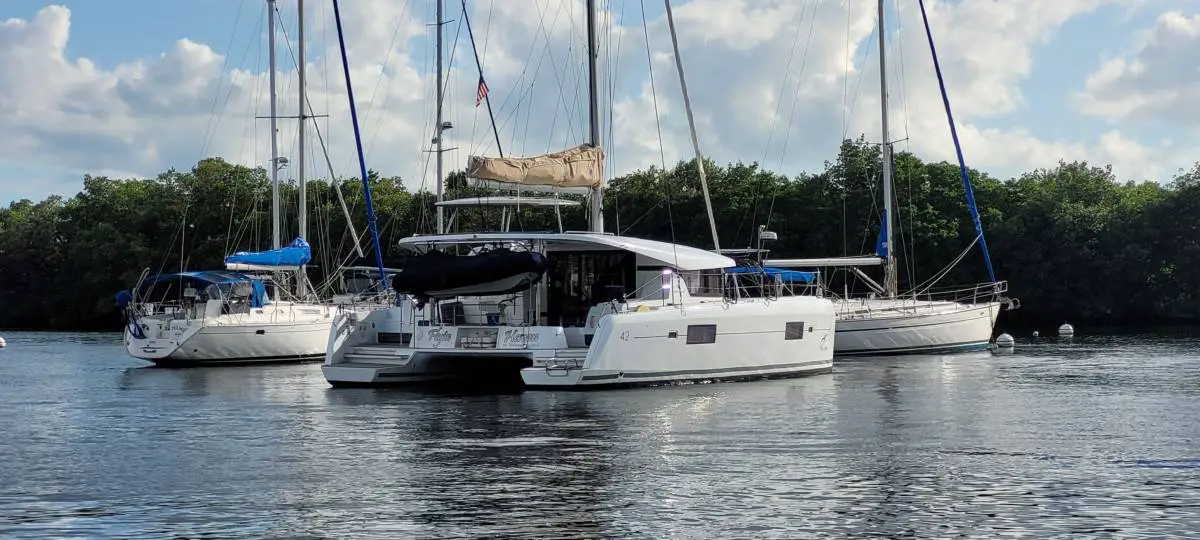
As an Amazon Associate, we earn from qualifying purchases. We may also earn commissions if you purchase products from other retailers after clicking on a link from our site.
Solar panels have become game changers when it comes to supplying power while off the grid. Marine solar panels can charge anything from batteries to computers to bigger electronic appliances. What are the best solar panels for sailboats?
The 9 best solar panels for sailboats are:
- Renogy Flexible Solar Panel
- Newpowa Solar Panel
- SunPower Flexible Sol ar Panel
- Eco-Worthy Off-Grid Solar Panel
- Rich Solar Polycrystalline
- Topsolar Flexible Solar Panel
- HQST Monocrystalline Solar Panel
- WindyNation Solar Panel Complete Off-Grid
- DOKIO Solar Panel Kit
This article will explore everything you need to know about the best marine solar panels.
Table of Contents
Solar Panels on Sailboats: An Overview
Before exploring the best solar panels, it is helpful to consider how solar panels on sailboats work and how many you need. Solar panels sit on different parts of a sailboat’s surface and absorb the sun’s rays, converting them into energy. This energy is used to power chargers, fridges, cooking stoves, and other electronics you need for self-sufficient sailing.
Worth noting is that today we will only discuss solar panels and not the batteries, which of course is an essential part of a complete system; we will also not discuss charges or charge controllers.
The products in this post will get you started in the right direction, but if you’re looking for a high-output system, then I suggest you contact someone that can help you calculate your energy requirements.
How Many Solar Panels Do I Need for My Sailboat?
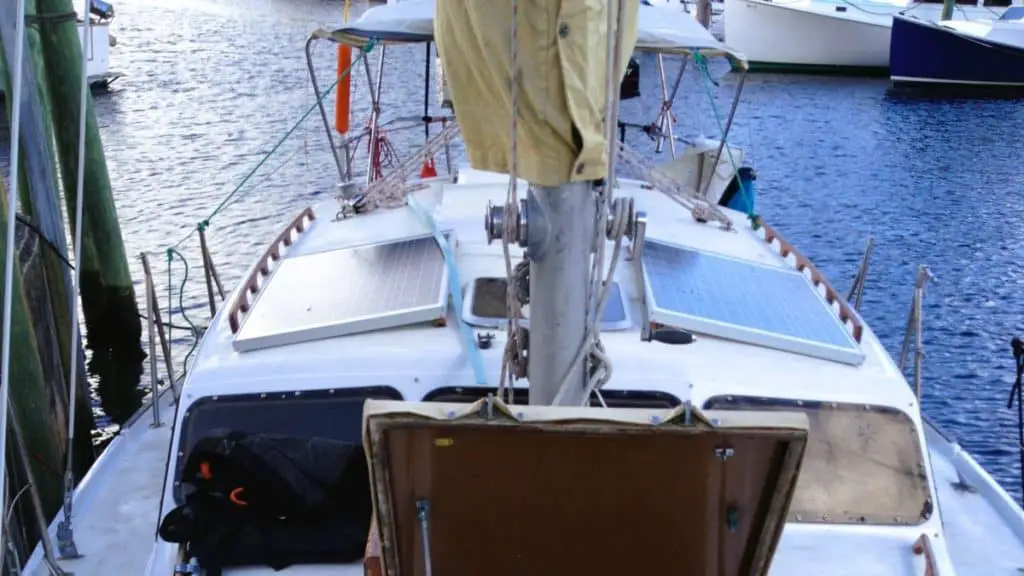
You will need between 2-8 solar panels for your sailboat. The exact amount depends on your sailboat’s space and how many electronics you need to power. Most solar panels can absorb between 100-300 watts per hour. On average, you will need approximately 1500 watts of power each day.
If your solar panels absorb 1500 watts daily, here’s what they can power on your sailboat:
- A laptop charger
- A microwave
- A coffee maker
- An induction cooker
If you want to power more heavy-duty electronics like a washing machine or a television, look for solar panels that absorb 400 watts. For heavy-duty electronics, try installing 5-8 solar panels.
Flexible vs. Rigid Solar Panels
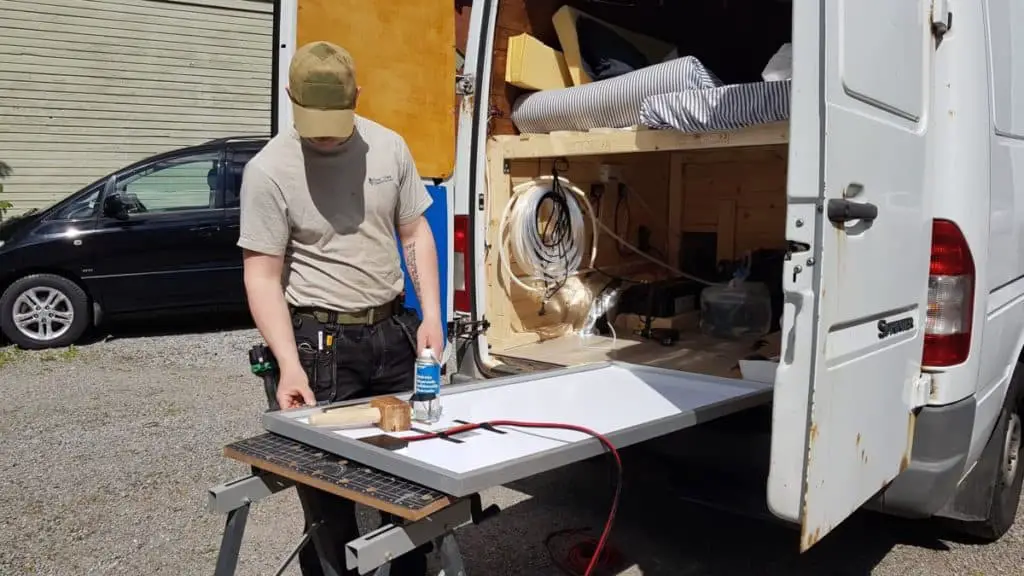
The three main types of solar panels are rigid panels, flexible panels, and semi-flexible panels.
Rigid panels are surrounded by aluminum and made with sturdy tempered glass. They are resilient against various weather conditions but require flat space to install.
Semi-flexible panels can be slightly bent to fit the shape of the installation surface. However, they can’t absorb a lot of power.
One very common type of solar panel used on boats is the flexible panel . Flexible panels are thin and lightweight, and, as their name suggests, they can be added to a wide variety of surfaces.
Here are the pros of flexible panels:
- They are thin and light. Flexible panels are approximately one-eighth the weight and size of rigid and semi-flexible panels. This allows you to add them to various sailboat sizes and surfaces. It also reduces the load on your sailboat.
- They are easy to install. Flexible panels are easy to work with and can be self-installed by following the instructions that come with the panels. Meanwhile, rigid and semi-flexible panels may require expert installations.
- They’re sturdy. Despite being light, flexible panels can bear a lot of pressure – you can easily walk over them.
However, there are also some drawbacks to using flexible solar panels:
- May fly away . As flexible panels are fragile, they can easily be dislodged and fly away, especially in strong winds.
- Vulnerable to scratches . While flexible panels can bear much weight, they may get scratched more easily. Over time this may affect their functionality.
- Not easy to reposition. Flexible panels are generally adhered to the surface of a sailboat using a specially prepared adhesive. Because of this, it is challenging to reposition the solar panels when there is a change of season.
- Less efficient. Flexible solar panels don’t convert energy to electricity or rigid panels. It may be harder to power heavy-duty appliances from a flexible solar panel.
How Many Panels Can I Fit on a Sailboat (Catamaran and Monohull)?
The amount of panels you can fit on your sailboat depends on the size of the panels and the surface space you have available.
You can fit at least two 400W panels on a Monohull and at least four on a Catamaran around 35ft in length. You will be able to fit 4-8 more solar panels if you add a solar panel bracket at the stern.
Renogy Flexible Solar Panel 100W
Renogy is a popular solar panel producer that designs high-quality solar panels. The Renogy Flexible Solar Panel is specially designed for marine vehicles, including sailboats.
Here are the best features of this solar panel:
- Flexibility . These solar panels are fragile, making them flexible and easy to mount on served surfaces.
- Easy to install. These are made with high-quality Monocrystalline, allowing them to be easily bent and easy to install.
- Lightweight. One solar panel weighs only 4 pounds, ensuring that no extra pressure or weight is displaced on your boat.
- Durability . User reviews have noted that these panels are highly durable and can last you a few years.
- Users have noted that these panels do not have the best outputs. They also can’t be stacked, which impacts their accessibility. To ensure that these panels can be connected, you may purchase extra extension cords.
Newpowa Rigid 160W Solar Panel
The Newpowa Right Solar Panel is a new design with a maximum power of 160W. It is weather-resistant and can be used on various surfaces and vehicles.
Here are the pros of the Newpowa Solar Panel:
- Weatherproof . The design features of this solar panel ensure that it survives under a range of different weather conditions. It has a heavy-duty frame preventing it from strong wind and waves. Its mainframe has a further layer of protection for the Junction box.
- Long warranty . Newpowa offers a 25-year transferrable output power warranty.
- Easy to install . These solar panels are made with mono cells and bypass diodes. Consequently, the solar panels can be immediately unpacked and are ready to install.
- High wattage. As these solar panels have 160 Watts of power, you need less of them to power all the devices on your boat.
- If you are planning on buying the Newpowa Solar Panel, you should note that they only make rigid panels. As a result, you may find it to be difficult to install them on curved spaces.
SunPower 110W Flexible Solar Panel
SunPower’s Flexible Solar Panels are made with high-quality materials ensuring durability. They are especially ideal for sailboats as their warranty also covers saltwater damage.
Here are the standout features of the SunPower 110W Flexible Solar Panel:
- Flexibility . This solar panel can be bent up to 30 degrees, making it easy to install on various surfaces.
- Easily portable. These solar panels are incredibly lightweight (4.4 pounds or 2 kilograms) and can be easily uninstalled and transported.
- Extended warranty . SunPower offers a five-year warranty on power and a two-year warranty on the product. The warranty includes damage caused by saltwater which many other solar panel warranties do not.
- Some users have noted that the output quality of these solar panels deteriorates over time. However, you can use the extended warranty to address any quality deterioration.
ECO-WORTHY Rigid 25W Off-Grid Solar Panel
This is a rigid, 25-watt solar panel that is waterproof, making it ideal for your boat. It is highly durable and has inbuilt indicators that highlight the battery’s status. Its low output makes it only suitable for charging phones or smaller electronics.
Here are some notable features of the Eco-Worthy Solar Panel:
- Ease of use. This solar panel is easy to install and requires no maintenance.
- Warranty. Eco-Worthy offers one year of warranty on all of its products and free maintenance if needed.
- USB control. This solar panel is attached to a USB control panel, preventing it from overcharging and getting damaged.
- Waterproof. All solar panel parts are entirely waterproof and can handle exposure to both saltwater and freshwater.
Some of the drawbacks to this solar panel include:
- Low watt absorption. Unlike many of the other solar panels on this list, this one can only absorb up to 25 watts of power at a time. So, it can only power smaller devices like batteries.
- Instruction manual. Some users have noted that the instructions to set up the Eco-worth solar panel are confusing for beginners. If you have never installed solar panels before, it’s best to call in an expert to help.
RICH SOLAR 100W Rigid 12V Polycrystalline
This 100W rigid solar panel is designed to absorb energy even in low light conditions. It is easy to install and ideal for marine environments.
Here’s why you should consider buying Rich Solar Panels:
- Works well in low light. This solar panel has been tested in various low light conditions, including cloudiness and during sunrise and sunset. It is certified to be able to harvest energy in low light conditions.
- Extended warranty. Rich Solar Panels offers a 25-year warranty on limited power output and a five-year warranty on quality.
- Water and weatherproof . The Rich Solar panels have used selective design elements to ensure they are water-resistant. They have high transparency and are made with tempered glass to withstand high winds and water pressure.
- Cost-effective . These are significantly cost-effective, making it easy to equip your sailboat fully.
- While solar panels can easily resist strong winds and water, they can be vulnerable to hail. Hail storms can cause dents on the solar panels, which can eventually cause damage.
Topsolar Flexible 100W Solar Panel
Topsolar provides premium flexible solar panels that are easy to move and install. They are ideal for installing on water vessels like sailboats with waterproof materials.
Here are some of the pros of choosing the Topsolar Flexible Solar Panel:
- Flexibility . The arc radius of this solar panel is 16 inches (40 centimeters) and can be bent to fit several curved surfaces allowing your solar panel to harvest the most sun.
- Efficiency . These solar panels are made with ETFE (ethylene tetrafluoroethylene) materials. They are extremely energy efficient and can rapidly convert energy.
- Some users have noted that these solar panels don’t have as long a life as other panels. In addition, some panels may only be able to absorb up to 75 watts of power at a time.
HQST Rigid 100w Monocrystalline Solar Panel
This is a 100-watt solar panel that has been specially designed to perform well in low light. It is made with high-quality materials and is ideal for sailing boats as it is durable even in unfavorable weather conditions.
Here are the pros of installing the HQST Solar Panel:
- Durability . These solar panels are designed to withstand strong winds and snowfall. They’re made with tempered glass and aluminum and are resistant to corrosion, ensuring longevity.
- Testing and warranty. Each solar panel is quality tested before it is distributed. It also comes with a three-year warranty.
- Easy to install . While these are rigid solar panels, they have pre-drilled holes, making them easier to install.
WindyNation 100W Solar Panel Complete Off-Grid
As its name suggests, this solar panel is designed for off-the-grid living and is helpful if you need to access power when you’re in the middle of the sea.
Here is why you should consider the WindyNation Solar Panel:
- Includes a charge controller. This controller lets you quickly see the amount of power the solar panel has absorbed.
- High power. Several positive user reviews have indicated that this solar panel is highly efficient in absorbing and converting power.
- This solar panel is more expensive than many others on the market.
DOKIO 300W 18V Portable Solar Panel Kit
If you are looking for a heavy-duty solar panel, the Dokio Solar Panel Kit is excellent. It can absorb a lot of energy and power a wide range of appliances on your sailboat.
Here’s why you should consider this solar panel:
- Versatile and flexible. While this is a rigid solar panel, it can be folded, making it easy to transport and install.
- High efficiency. This solar panel is highly efficient at converting energy into power. As it absorbs up to 300 watts, you can install just two of these panels to get significant energy.
- Some users have noted that this solar panel does not work well in low-light conditions. You may want to have a backup solar panel for days when it’s rainy and windy.
Here are Some of My Favorite Catamaran Cruising Resources
Thank you for reading this article. I hope you found it helpful as you hopefully start your sailing adventures. Here are some resources that I use as a sailor that I hope you’ll also find helpful. These are affiliate links, so if you do decide to use any of them, I’ll earn a commission. But in all honesty, these are the exact things that I use and recommend to everyone, even my own family. Sailboats: If you’re looking for the best boat to suit your needs, I would recommend a catamaran. If you’re interested, I can show you the differences between catamarans and other types of sailboats .
Books: For getting started, I really like Cruising catamarans made easy . It is actually a textbook from the American sailing association; it is used to get a cruising catamaran certification. There are some other great books, and I have compiled a list of books about cruising catamarans that you will find useful.
Communication: Being out on adventures, whether it be sailing or climbing mountains, good communications are essential to being safe. I recommend two things Google fi (incredibly simple cellular data all over the world) and Garmin inreach mini (for text and voice in remote areas without cell coverage)
Sailing courses: Online sailing courses are great for beginners starting out their sailing career; it’s an efficient way of learning the basics of navigation, throttle controls, and maritime safety. I suggest starting with two free courses from NauticEd .
To see all my most up-to-date recommendations, check out this resource that I made for you!
Owner of CatamaranFreedom.com. A minimalist that has lived in a caravan in Sweden, 35ft Monohull in the Bahamas, and right now in his self-built Van. He just started the next adventure, to circumnavigate the world on a Catamaran!
Leave a Reply Cancel reply
Your email address will not be published. Required fields are marked *
Save my name and email in this browser for the next time I comment.
Recent Posts
Must-Have Boat Gear for Catamaran Sailors!
Sailing is probably the most gear-intensive activity I've ever done; there are so many decisions to be made about what gear to buy now, for tomorrow, and what to definitely never buy. The gear on...
6 Best Trailerable Trimarans For Bluewater and Coastal Sailing
Having a boat costs a lot of money, even when you are not using it, marina fees, etc. And once it is in the water most sailors never go very far from their "home marina" and sailing will be somewhat...
ACTIVE STORM TRACKER Hurricane and Tropical Storm Information Learn more

Service Locator
- Angler Endorsement
- Boat Towing Coverage
- Mechanical Breakdown
- Insurance Requirements in Mexico
- Agreed Hull Value
- Actual Cash Value
- Liability Only
- Insurance Payment Options
- Claims Information
- Towing Service Agreement
- Membership Plans
- Boat Show Tickets
- BoatUS Boats For Sale
- Membership Payment Options
- Consumer Affairs
- Boat Documentation Requirements
- Installation Instructions
- Shipping & Handling Information
- Contact Boat Lettering
- End User Agreement
- Frequently Asked Questions
- Vessel Documentation
- BoatUS Foundation
- Government Affairs
- Powercruisers
- Buying & Selling Advice
- Maintenance
- Tow Vehicles
- Make & Create
- Makeovers & Refitting
- Accessories
- Electronics
- Skills, Tips, Tools
- Spring Preparation
- Winterization
- Boaters’ Rights
- Environment & Clean Water
- Boat Safety
- Navigational Hazards
- Personal Safety
- Batteries & Onboard Power
- Motors, Engines, Propulsion
- Books & Movies
- Cockpit Confessions
- Communication & Etiquette
- Contests & Sweepstakes
- Colleges & Tech Schools
- Food, Drink, Entertainment
- New To Boating
- Travel & Destinations
- Watersports
- Anchors & Anchoring
- Boat Handling
What You Need To Know About Boat Solar Panels
Advertisement
Sunshine and boats are a natural together, so why not use all that free energy? Here’s the lowdown on solar panel selection and installation
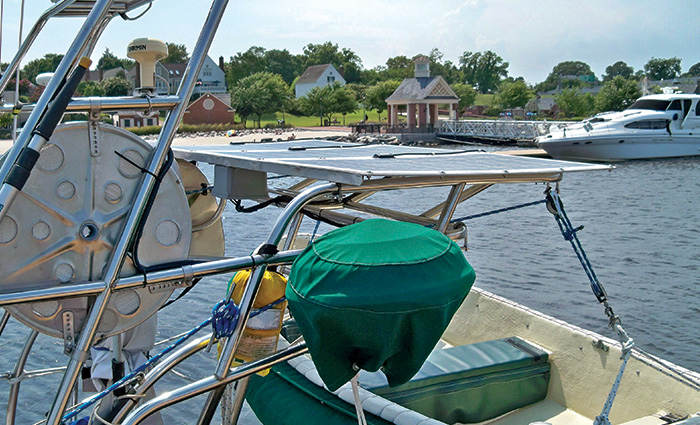
I first embraced the idea of solar power while up a pole (literally) in the Atlantic Intracoastal Waterway replacing dead batteries. It was the early 1980s, and I was maintaining buoys, beacons, and other such Aids To Navigation (ATON) for the U.S. Coast Guard, replacing massive, nonrechargeable batteries with rechargeable solar-powered ones. The higher-ups said the solar rechargeables would last six years – twice as long as the one-shot batteries. As the deck-ape in charge of lugging all those batteries up and down the ladders, my back and I immediately appreciated the whole “free power from the sun” thing, a concept I continue to embrace.
The strategy behind s olar energy onboard is simple: A solar panel converts sunlight into electricity, after which wiring conducts it to your batteries for storage until needed. Solar panels are used to keep batteries or banks charged rather than to power equipment directly. This arrangement allows the panels to store generated power whenever produced, while providing a steady source of power to a piece of equipment even when the panel is producing no power.
While they do require an initial outlay, solar panels can easily pay for themselves in money saved and independence gained over their service life. They’re noiseless, have no moving parts, and they provide free electricity for years with minimal maintenance. Solar panels also have the benefit of being modular, letting you start small and add more as your power requirements increase.
The benefits of solar
Almost any boat can benefit from solar power. Whether at a slip, mooring, or on a trailer, boats can keep their batteries topped off without the need for external power. You can also use solar power to supplement or even replace other onboard charging sources, reducing or eliminating the need to run engines or generators to keep batteries topped off (a wasteful practice that burns fuel while wearing down the costliest pieces of equipment onboard).
While underway, it’s a plus to be able to recharge a dead battery in an emergency – say, to operate a VHF radio or navigation gear. While dockside, solar panels keep batteries charged and vital systems (such as bilge pumps) up and running without the need for shore power.
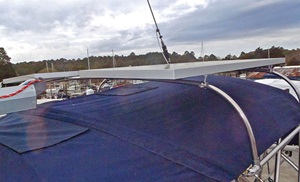
Just about any boat can benefit from solar power, whether it’s to keep batteries topped off or supplement other onboard charging sources.
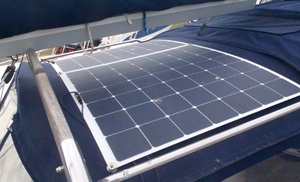
Mount solar panels where they are exposed to maximum sunlight but do not interfere with operation of the vessel.
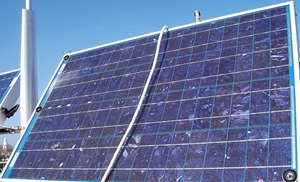
Bottom: Something as simple as the shadow of a line or shroud can reduce or halt output.
Types of panels
Solar panels contain photovoltaic cells – small silicon semiconductor devices that convert sunlight into electricity. Each cell generates between 0.45 and 0.5 volts, depending on exposure to direct sunlight. Cell size determines amperage, with a 3-inch cell producing roughly 2 amps, a 4-inch cell a little over 3 amps, and a 5-inch cell around 5 amps.
Construction-wise, the three main types of solar panels are monocrystalline, polycrystalline, and amorphous (or thin-film) technology.
Monocrystalline panels have been around the longest and remain the most popular. The panels are constructed of thin slices of crystal silicon (each cell is cut from a single crystal) housed in a rigid, aluminum frame and covered with tempered shatterproof glass. The panels have a uniform black, blue, or gray appearance and are generally quite rugged, although they can be cracked or broken if subjected to extreme abuse.
Monocrystalline panels have the longest service life of the three types. With a conversion efficiency of around 17%, they’re also the most efficient and have the highest electrical output per area, but they are also the most expensive.
Polycrystalline cells are sliced from a cast silicon block and have a shattered glass appearance. Built in much the same way as monocrystalline panels, they’re rectangular, giving the panel itself a tiled look. Their life span is similar to monocrystalline panels, and while their conversion efficiency is lower (by 14%), they’re also a bit less expensive.
Amorphous panels are made by placing a thin film of active silicon on a solid or flexible backing (such as stainless or aluminum sheeting) depending on whether the panel is to be rigid-framed and glass-fronted or flexible. Flexible amorphous panels, in which cells are sandwiched between rubber and polymer covers, are light and tough enough that you can walk on them and, in some cases, even roll them up for storage.
This type of solar panel is also better if shade is an issue. With crystalline panels, even the thin shadow of a rope or shroud across one cell can reduce or halt output of an entire module. Amorphous panels have “bypass” diodes that essentially turn off shaded cells and provide a current path around them. Some monocrystalline panels also have bypass diodes, but this feature comes at an increase in cost.
Amorphous panels are the least expensive of the three types, but their efficiency is also lower – around 8%, or roughly half that of a monocrystalline type. This lower output is somewhat mitigated in newer panels, however, which use three-layer construction. Each layer absorbs different colors of the solar spectrum, so the panel will deliver more power longer each day and during lower light conditions than the other two types.
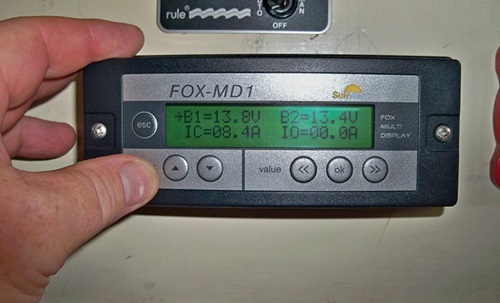
The charge controller should be mounted below decks and as close to the battery as possible.
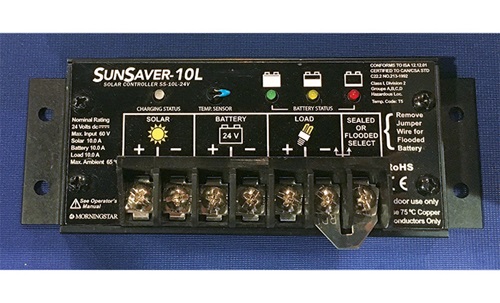
Follow manufacturer instructions for wire connections.
Planning the system
While factors such as cost, mounting options, and output are important, a successful installation depends on knowing what you want the system to accomplish. Is the goal to float-charge a single battery or supplement an overall vessel energy plan? Answering these questions up front will help determine the type, size, and number of panels required.
To understand the process better, let’s walk through the basic steps to determine power requirements and installation considerations for a single solar panel installation. While the example itself is simple, the steps are the same used to plan more complicated installations.
For our example, the goal is to install a solar panel to provide charging for a single 12-volt, 100-amp-hour wet-cell battery used to power an automatic anchor light on a moored vessel.
The first step is compiling a daily power consumption estimate to determine how much solar power is needed.
The daily self-discharge rate for a wet-cell battery is roughly 1%, meaning our 100-amp-hour battery requires one amp every 24 hours just to maintain the status quo. The anchor light draws 50 milliamps per hour of operation, and we’ll assume it operates 10 hours each night. Multiplying current draw (50 milliamps) by hours of daily operation (10) generates a daily energy expense of 500 milliamps or .5 amps.
This means our solar panel must meet a minimum daily energy tab of 1.5 amps – one amp of battery self-discharge rate plus .5 amps of power draw for the anchor light.
Next up is figuring out panel size and the best mounting location. For our example, let’s assume the panel will be a horizontal, fixed-mount installation. A 10-watt horizontally mounted panel should generate between 3- and 5-amp hours per day.
We’ll need at least 13 volts to fully charge our 12-volt battery. As most solar cells generate at least 0.45 volts, you’ll want a panel with a minimum of 33 cells, which should provide around 14.85 volts.
Keep in mind that’s the minimum needed, which may not be enough once you factor in a few cloudy days. Most panels are designed to generate between 15 and 20 volts to overcome problems like cloudy days or inherent electrical resistance within the panel or installation components. While this higher voltage lets you make up for less electrically productive days, it also means you’ll want to install a solar charge controller (voltage regulator) to avoid battery damage due to overcharging.
Attempts to plan a system that tries to use the output of the panel and capacity of the battery to prevent overcharging (and avoid the installation of a charge controller) is false economy and should not be done. The system will never meet its full output potential and, worst case, can damage the battery due to overcharging.
A word on ‘charge controller confliction’
If your vessel has multiple charging sources, such as solar panels and a wind turbine, a crucial but often overlooked consideration is “charge controller confliction.” In short, this is an issue where the charge controller for your solar panel and the charge controller for your wind turbine are internally adjusted to the same maximum charge voltage set point. This means they are constantly fighting each other to be the dominant power source, which results in diminished overall charging output and performance. An in-depth article on this issue can be found at missioncriticalenergy.com (in the website footer, click “Superwind Turbine Manuals & Technical Bulletins.” Under the header “Charge Controllers,” select the document “Resolving Charge Controller Confliction”).
While this article addresses charge controller confliction at remote, off-grid sites, the information provided is also applicable to vessel installations. — F.L.
Location and mounting
Solar panels should be mounted in a location where they are exposed to the maximum amount of sunlight but do not interfere with operation of the vessel or the movement of passengers and crew. Solar panels will typically be either fixed or mounted on some type of movable bracket that allows you to actively point the panel toward the sun for maximum output. Both methods have their pros and cons. Fixed panels (which are normally mounted horizontally) don’t produce as much power as a panel that can be adjusted to face the sun. The downside is that adjustable panels must be aimed throughout the day to maximize their output.
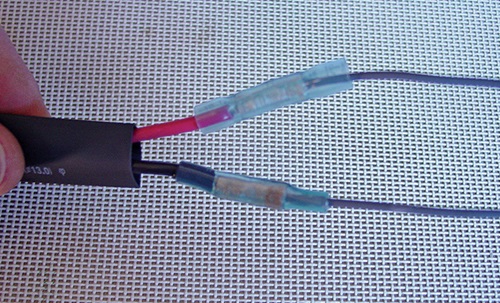
Use good quality, marine-grade heat shrink connectors (top) and liquid electrical tape (right) to create airtight, waterproof seals and reduce corrosion.
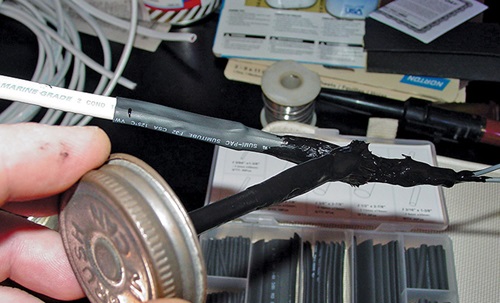
Installation
After choosing and mounting your panel, it’s time to connect it. The first thing you need to determine is the size (gauge) of the wiring to be used. Multiply your panel’s rated amp output by 1.25 (which adds a 25% safety factor). Then measure the length of the entire wiring run, panel to battery, and multiply by 2. Once you have these two numbers, refer to the American Boat and Yacht Council’s (ABYC) 3% voltage-drop table for wire size. Ancor Products offers a handy wire calculator on its website ( ancorproducts.com/resources ).
Always use good quality marine grade connectors and tinned, multi-stranded copper wire with vinyl sheathing. The wire will run from the solar panel to the charge controller first, then to the battery. Try to keep the wire run as short as possible, and if it transits an external deck or cabin house (it likely will), be sure to use an appropriate weatherproof deck fitting.
The charge controller should be mounted below decks and as close to the battery as possible. You’ll always want to follow the manufacturer’s instructions for connections, but in a typical installation you’ll connect the solar panel’s positive (red wire) lead to the charge controller’s positive input wire or terminal and the negative (black wire) lead to the charge controller’s negative input wire or terminal.
Next, connect the charge controller’s negative output to the battery negative terminal and the controller’s positive output to the battery’s positive terminal via an appropriately sized in-line fuse (or circuit breaker). ABYC recommends these be installed within 7 inches of connection to the battery or other point in the DC system. To reiterate, the installation of the charge controller can vary among models, so follow the manufacturer’s installation instructions.
Finally, ensure all connections are waterproof and secure any loose wire runs with wire ties and cable clamps for a neat installation. Then get ready to lean back and soak up some free sun.
Related Articles
The truth about ceramic coatings for boats.
Our editor investigates the marketing claims of consumer-grade ceramic coatings.
Fine-Tune Your Side Scan Fishfinder
Take your side-scanning fishfinder off auto mode, and you’ll be spotting your prey from afar in no time
DIY Boat Foam Decking
Closed-cell foam flooring helps make boating more comfortable. Here’s how to install it on your vessel
Click to explore related articles
Frank Lanier
Contributing Editor, BoatUS Magazine
Capt. Frank Lanier is a SAMS-accredited marine surveyor with over 40 years of experience in the marine and diving industries. He’s an author, public speaker, and multiple award-winning journalist whose articles on boat maintenance, repair, and seamanship appear regularly in numerous marine publications worldwide. Contact him via his YouTube channel “Everything Boats with Capt. Frank Lanier” or at captfklanier.com.
BoatUS Magazine Is A Benefit Of BoatUS Membership
Membership Benefits Include:
Subscription to the print version of BoatUS Magazine
4% back on purchases from West Marine stores or online at WestMarine.com
Discounts on fuel, transient slips, repairs and more at over 1,200 businesses
Deals on cruises, charters, car rentals, hotel stays and more…
All for only $25/year!
We use cookies to enhance your visit to our website and to improve your experience. By continuing to use our website, you’re agreeing to our cookie policy.
Yachting Monthly
- Digital edition

Sailing with solar power: A practical guide
- Duncan Kent
- November 13, 2020
The latest solar technology makes self-sufficient cruising much more achievable. Duncan Kent gives the lowdown on everything you need to get your boat sorted

SOLAR POWER ON BOARD
Solar power is fast becoming the most popular and economic method of keeping the batteries charged on a boat.
Particularly now that the efficiency of photovoltaic (PV) panels, charge controllers and batteries is improving every day.
Furthermore, the latest technology in regulators and charge controllers has brought about a noticeable increase in useable power output, so the problems of shading and non-alignment can be compensated for more easily.
Not only has PV equipment become more efficient and cost-effective, but many of the modern devices we want to use on a boat have become less power hungry.
This means it is now far easier to provide your entire yacht’s electrical needs, both 220Vac and 12/24Vdc, from natural energy resources – particularly solar power, even if you are planning on a fully electric boat .

Thinking carefully about how much power you need and how much your boat can accommodate is key to planning a solar array. Credit: Graham Snook
WHAT DO YOU NEED?
For instance, a boat with two new, good quality, deep-cycle house batteries of 100Ah each would supply 100Ah of energy to consume between charges, if you only use the recommended 50% of available charge between each charge cycle to protect the batteries.
From this you could run:
- a modern 12Vdc fridge (approx. 1.5Ah, or 36Ah over 24hrs),
- all LED lighting (say 20Ah per day),
- various small device chargers (20Ah)
- and a number of other items such as water pumps, TVs and stereos (25Ah/day)
- Totalling around 100Ah.
- For this you’d need 400W of solar capacity.
Of course, if you like to run a lot of AC devices off-grid such as hair dryers, microwaves, toasters and the like, then you’re going to need a DC/ AC inverter, which will take you to another level in power consumption terms.
But even then, with careful planning, solar could provide a large portion of the power you need before resorting to engine charging or a generator.
THE AVAILABLE SPACE
In practical terms, a modern 40ft monohull would have the space for around 1,200W of PV panels (cockpit arch, sprayhood top, deck), maybe 1,500W with the addition of a few portable panels for use at anchor.
The 1,200W of fixed position solar array could produce around 360Ah on a sunny summer’s day (zero shading) or more likely 250Ah on the average UK summer’s day.
So that’s enough for your 100Ah general DC consumption plus another 150Ah of AC consumption via the inverter.
Of course, to do this you’ll most likely need to increase your battery capacity to around 400-500Ah for maximum flexibility (you’ll need to store as much as possible during daylight hours), a typical figure for a 40-50ft offshore cruising yacht these days.

Get your solar charging right and you may never need to hook up to shore power
Typical daily inverter loads for a cruising yacht off grid might be:
- induction cooking plate (20min) 60Ah
- microwave (15min) 30Ah
- coffee maker (20mins) 25Ah
- hair dryer (5min) 15Ah
- laptop charger (2h) 10Ah
- or around 140Ah in total.
The trick is to monitor the batteries’ state of charge (SOC) at all times and vary your use of the inverter to suit.
For example, you might want to cook supper mid-afternoon, when solar is in abundance, and then reheat it in the evening when you want to eat it.
In some cases, when you’re cruising in warm climates such as the Med, you might end up with excess charge from your solar panels .
In this situation, many long-term cruisers devise a method of ‘dumping’ the extra energy by heating water for showers.
Do bear in mind if you’re planning to live aboard full time , then it’ll be a whole different story on cloudy days and during the winter, when inverter use might need to be knocked on the head entirely.
Continues below…

Eco friendly sailing: Best practice for green yachting
How easy is it to go eco friendly sailing? We look at the steps cruisers can take to minimise their…

How and where to go wild cruising in the UK
Planning to spend the night away from crowded waters can be truly rewarding but preparation is essential before you go…

Solar-powered boat crosses Atlantic
Then heads to UN climate conference
POWER DISCREPANCIES
There’s often confusion as to how much power you can harvest from a solar installation.
A PV panel is nearly always advertised stating its theoretical peak output power (Pw).
But in reality, on a yacht where there are limited areas in which to mount them, they will more likely produce a maximum of 60% of their peak output if mounted horizontally, increasing to 80% if tilted towards the sun and regularly adjusted.
The latter is rarely achievable on a boat, however, as even at anchor it can swing through an arc of 180° in wind or tidal shifts .

Flexible panels can be mounted on sprayhoods or awnings to add power when it’s needed at anchor or in harbour
INSTALLATION
Having trawled through hundreds of ‘deals’ to get the best price on the most efficient panels you can afford you now need to know how to install them to best fulfill your energy generation needs.
The output, even from the highest quality photo-voltaic array, will only be as good as the installation itself.
So following our guidelines should ensure you extract every last drop of energy from your investment.
PANEL MOUNTING
Sailing boats are not the ideal structure on which to mount wide, flat PV panels.
So before you go ahead and purchase what looks like the biggest and best, take a few minutes to decide on exactly where you can mount them, as this will affect what size and type of panels you should buy.
In many cases the first choice would be on an arch, davits or gantry aft, especially if you already have, or plan to fit one.

Dinghy davits, particularly on multihulls, can support a huge solar capacity
These allow a solid metal framework to be constructed that will be strong enough to take the heavier, more productive rigid PV panels.
You can also build in some form of adjuster to the framework that will allow the panels to be orientated towards the sun for the best performance.
With luck (or careful planning) a gantry will also keep them aft of the boom, thereby eliminating loss of output caused by boom shading.
The next most popular position for mounting the panels is on a cockpit sprayhood or bimini, although this will often mean using the flexible or semi-flexible panels, which are generally less efficient than the rigid ones for the same area.
ELEVATED MOUNTING
Alternatively, there are kits available for mounting panels onto lifelines, which can allow their elevation to be manually adjusted to a certain degree.

Pole-mounted panels can be used for maximum adjustability
Finally, panels can be fitted directly onto the deck by either gluing them down using mastic or attaching them onto a rigid support frame.
Once again you will probably need to use semi-flexible panels – especially if the deck surface is curved.
Rigid, glass-coated panels will obviously not be suitable for deck mounting in an area that is frequently walked over.
Don’t be tempted to drill through the panels, even along the edges, as this will invalidate the warranty and possibly damage the panel.

With solid panels, the ability to adjust the angle can add significantly to output
It might seem obvious, but the key to an efficient system is to avoid shading wherever possible.
It’s no good fitting expensive, high-efficiency PVs right under the boom as they’ll perform little better than the cheaper types.
Saying that, in good quality panels each cell will be isolated from the next by a series of diodes (one-way electrical valves), so that if one cell is shaded at least it won’t drag down the other cells within the same panel.
Older panels often didn’t have these, so the slightest partial shading caused the output of the entire panel to cease.
OVERHEATING
Another important factor that is often ignored when installing the panels is that of overheating.
If a PV panel gets too hot, which is quite likely if mounted directly onto a flat surface without an air gap behind, its output will drop quite noticeably.
To allow for some air circulation behind the panels it’s best to apply mastic adhesive in numerous large dabs.
This is best achieved by placing wooden spacer strips between the dabs until the mastic has completely cured, after which the spacers can be removed.
You might need some form of trim around one or more of the outside edges, though, if they are positioned where sheets and other lines might get caught under them.
Raising the panels up will also help water to drain off and thereby helping to avoid possible delamination from sitting in water for too long.
CHARGE CONTROL
A PV module cannot supply an electrical device directly due to the changeability of the sunlight, which in turns varies the current it can produce.
Therefore, it has to be connected to a battery, which stores and smooths its output.
Whatever the size of your solar array you will need to fit a regulator, or charge controller as they are now more commonly known, to the system in order to control the output and to help extract as much power from the panels as possible.
There are two types of PV charge controller.
The older designs, called Pulse Width Modulation (PWM) types, were fairly basic voltage regulators and simply output volts at just above battery level.
The latest controllers use Multi Power Point Tracking (MPPT) technology and can accept much higher input voltages (up to 240Vdc).
MPPT controllers can be up to 30% more efficient as they use the peak output of the panels to charge the batteries, even compensating for partial shading.
BEWARE FAKE GEAR
If you buy online do be careful to ensure you’re getting what you pay for.
There are a huge number of fake MPPTs out there, which are simply the much cheaper PWM dressed up with fake labels.
It’s hard to tell which is which, but the old adage of ‘if it looks too good to be true, it usually is’ makes good sense.
MPPT controllers are usually bigger and heavier than PWMs, but if in doubt call or email the supplier to discuss the pros and cons of their kit before buying.
If they’re not happy to chat and advise you then I would steer clear of their gear.
Some good MPPTs are made in China, but unless they have a UK supplier, I wouldn’t bother with them as you’ll have no follow-up advice.
To calculate what size controller you need simply divide the panel’s peak power in Watts (Wp) by the battery voltage, which will give you the maximum current (Amps) they could theoretically supply.
For example 240W/12V = 20A. Although it’s unlikely you’ll ever get near the peak output from any PV panel, it’s best to go for the maximum possible.

Induction cooking is now a reality on board, even without shore power
PV panels come with a short length of cable, usually around 1m long.
Some are supplied with MC4 connectors already attached but most only provide bare wires.
The latter can be easily extended using proper waterproof connections but thought must be given as to the current rating and voltage drop (usually max 3%) for the size of cable you intend to use.
If in doubt, bigger is better!
Panels can sometimes be ordered with the wiring on the back so that the cable can go straight below deck through a hole under the panel.

You may need to fit extra battery capacity if you want to run an inverter from solar charging
SERIES OR PARALLEL?
A commonly asked question is ‘should I wire my PV panels in series or in parallel?’
The simple answer is, if there’s any danger of frequent shading to one or more of the panels then install them in parallel.
If wired in series the shading of a single panel will drag down the output from all of the others in the same series.
PARALLEL IS PREFERRED
Most commonly, multiple panels are wired together in parallel to a single charge controller, with diodes protecting each panel from discharging the others should one become partially shaded.
With the advent of MPPT controllers, however, there can sometimes be a benefit to wiring two or more identical panels into a series bank, thereby presenting a higher voltage to the controller.
It’s worth noting that, like batteries, wiring PV panels in series increases the voltage only – the current capacity of the array remains the same as for a single panel.
‘Where’s the benefit of wiring them in series then?’ you might ask.
Well, the higher the voltage fed into the MPPT, the more consistent it will be with its output, which could, in some cases, prove more efficient than a parallel installation with PWM controllers.
It’s also likely to be necessary if you have a 24V domestic system.
SERIES WIRING
Series wiring is usually only done when the cable runs are long, as it helps negate the voltage drop caused by the resistance of the cable.
While a decent controller will have no problem handling the output from four or even five panels wired in series, it is often inappropriate for sailing yachts as shading just one of the panels will reduce the output of the entire series array.
If you need to do so in order to reduce cable runs then it’s best to split the panels between each side of the boat – a series bank on each side.
If you do this, then you would ideally fit a separate controller to each series PV bank and then connect their outputs together in parallel to the battery bank.
Note, however, that panels wired in series must all be the same types with an equal number of cells per panel.
Furthermore, the charge controller needs to be sized for the total of all panel voltages added together and the current rating of one individual panel.
Differently rated panels can be connected together in parallel but only if each panel has its own controller.
The outputs of the individual controllers can then be joined together to go to the battery bank.
BATTERY BANK QUESTION
Another frequently asked question is ‘Can I connect another charging source to the battery bank while the solar array is charging?’
The answer is yes.
Any decent PV controller will be protected against feedback from other charging sources.

Think carefully about where shade from mast, boom and rigging will fall. Credit: Graham Snook Photography
CABLE SIZE AND CONNECTORS
A frequent cause of reduced output from PV arrays is wiring that is too small.
The resistance of a wire conductor increases in direct proportion to its cross-sectional area, so go as big as is practicable for the least cable loss.
Each panel should be supplied with the correctly sized cables for its own maximum output.
But if you’re combining panels, either in parallel or in series, you will clearly need to rate the single feed cable to suit the maximum current available at theoretical peak solar output and to minimise voltage drop.
Likewise, the cable from the controller to the batteries should be sized to suit the controller’s maximum output current and protected with a fuse.
For outside it’s important to use exterior grade cable, which is double- insulated and UV-proof.
WEATHERPROOF CONNECTORS
And wherever possible use compatible weatherproof connectors (usually MC4) to those found on the panels rather than cutting off the plugs and hard-wiring them.
Field- assembly MC4 plugs are available, so you don’t have to drill large holes in the decks or bulkheads when feeding the cables through.
When joining more than one panel together try to use the approved multiway connectors; not only do they keep the wiring neat and tidy, but they also offer a greater contact area than budget terminal blocks.
If you have to use screw-type connectors make sure to fit proper ferrules to the wire first to avoid any stray wires in the multistrand shorting across the terminals.
When feeding a cable from above to below deck, try to go through an upright bulkhead where possible to minimise ‘pooling’ of water around the access hole.
Also, use a proper watertight deck seal that matches the cable you’re using.
If drilling through a cored deck you need to drill a larger hole first, fill it with epoxy resin and then drill the required size hole through the epoxy to ensure no water gets into the deck core.
Ideally, the charge controller should be mounted no further than 2m from the battery bank.
If you need to go further, you’ll require larger cabling to reduce the voltage drop.

A generous solar array will keep you self- sufficient indefinitely. Credit: Graham Snook Photography
CONTROLLER LOAD TERMINALS
There is often confusion over the ‘load’ output of a charge controller (often depicted by a light bulb) and what can safely be connected to these terminals.
Rarely explained in the manual, the load terminals should be pretty much ignored in a marine installation as the output on these terminals is usually very limited (10A max).
Some attach an LED light to them to indicate the controller is operating, but all your usual electrical loads should remain connected to the batteries with the battery terminals on the controller connected directly to that battery bank via a fuse.
It is possible, though, to control a high-current switching relay in certain conditions.

Parallel installation is more resilient to shading, but a series installation will increase peak charging outputs. A combination of the two offers some of the benefit of both
CIRCUIT MONITORING
Unlike most cheap PWMs, the majority of good quality MPPT charge controllers come with an alphanumeric LCD screen to let you know what is going on.
This can either be a remote display or simply one on the front of the box.
It’s obviously a lot better to have a proper numerical display than to rely on a few flashing LEDs to tell you when something’s not right.
So if your chosen controller doesn’t have one be sure to fit a battery monitor (the shunt type) into your solar circuit between the controller and the batteries.
It doesn’t have to be a very ‘smart’ monitor, just one that can display the voltage and current being supplied by the panels.
For smartphone addicts there are several wifi apps that will do the job remotely on your phone or tablet.
DEVICE PROTECTION
All good quality PV panels feature built-in diode protection between each cell to prevent a shaded cell from dragging down the productive ones.
In addition, there will be internal blocking diodes on the final output to protect the panel from polarity reversal and to ensure that the batteries can’t discharge back into the panel during the night.
The latter can be added externally, the former can’t, so check before you buy.
A fuse, rated just above the maximum current available, should be fitted between each panel and the charge controller.
Another fuse should then be installed between the charge controller’s output and the batteries.
In the case of multiple arrays, this second fuse will be rated higher than the individual panel fuses and should match the maximum current rating of the cable.
With this protection installed other charging devices can be connected in parallel at the battery, meaning the solar can be left connected even when you are hooked up to shore power and the battery charger is operating.
In some circumstances, however, this arrangement can affect the sensing of the battery by the charger, causing it to fall back into float mode.
If this becomes apparent it can be overcome by installing a manual/auto switch to disconnect the solar array when on shore power.

Check the flex of the solar panel is sufficient for your deck
EXCESS POWER DUMPING
A solar charge controller works by disconnecting the supply from the PV panels when the batteries are fully charged.
But for some full-time liveaboards in sunny climates that can be considered a waste, when the excess power could be put to good use – heating water, say.
This is commonly done using an inverter to supply AC power to the heating element.
Alternatively, you can now buy a 12Vdc element for your calorifier (hot water tank) and supply this directly from your battery bank.
Both of these methods would require a voltage sensitive relay (VSR) to disconnect the element should the battery voltage drop below a pre-set level.
Don’t expect boiling hot water, as there will probably only be enough spare power to take the chill off it before your battery bank reaches its lower threshold voltage.
A 600W/12V element will draw some 50A, from the batteries, whereas a 1kW AC element run through an inverter will need close to 100A.

A small, semi-flexible panel will be sufficient for keeping batteries trickle charged, but not for heavy use
RIGID, FLEXIBLE, OR SEMI FLEXIBLE?
Despite massive recent improvements in semi-flexible panels in recent years, the solid glass panels still offer a higher power density.
That said, they are heavier, more awkward to mount and can’t be walked on, so unless you have a dedicated gantry aft, you’re better off choosing the more rugged semi-flexibles.
Modules incorporating monocrystalline cells also have a better output than those with polycrystalline cells (that’s cells made from a single slice of silicon as opposed to layers of smaller pieces).
Output voltage also depends on the number of cells on the panel.
In the past this has commonly been 32, but now some 36 and even 40 cell panels are available.
That said, they’re larger, of course, so an array of interconnected smaller panels might be a better solution.
Module efficiency is now more often around the 20% mark, as opposed to 12-15% for older models and semi- flexible (up to 20° bend) are usually better than flexible (up to 180° bend).

A rigid panel is more efficient, but less robust
There are a huge number of panels on the market, but many use the same cells.
Sunpower Maxeon cells are exceptionally good, as are the Panasonic HIT range and LG, but they are pricey.
If the maker is offering a 25-year guarantee instead of a 3-5 year one, you can be pretty confident they’re good.
When it comes to charge controllers it’s definitely worth paying a little more for a decent MPPT.
A cheap PWM might be okay just to keep a small starter battery charged with a 30W panel, but the MPPT will give you much more when it comes to heavy service.
Victron are probably top of the range, while cheaper brands like MakeSkyBlue and EPever are also good value – but treat imports of unclear origin with care.
ABOUT THE AUTHOR

Duncan Kent has been evaluating and reviewing yachts and marine equipment for the past 30 years
Enjoyed reading this?
A subscription to Yachting Monthly magazine costs around 40% less than the cover price .
Print and digital editions are available through Magazines Direct – where you can also find the latest deals .
YM is packed with information to help you get the most from your time on the water.
- Take your seamanship to the next level with tips, advice and skills from our experts
- Impartial in-depth reviews of the latest yachts and equipment
- Cruising guides to help you reach those dream destinations
Follow us on Facebook , Twitter and Instagram.

The best of EcoWatch right in your inbox. Sign up for our email newsletter!
- About EcoWatch
- Contact EcoWatch
- Terms of Use
- Privacy Policy
- Learn About Solar Energy

Top 5 Best Solar Panels for Boats (2024 Marine Buyer’s Guide)
In this guide, you’ll learn:
- Why photovoltaic (PV) equipment is great to have on your boat
- Which panels are best suited for use on the water
- What qualities make for a great boat solar panel
Note: In July 2024, SunPower notified dealers it would be halting all new shipments and project installations. The company also noted it would “no longer be supporting new Leases and PPA sales nor new project installations of these financing options.”
Why Should You Install Solar Panels On Your Boat?
Before we dive into the best panels to bring your boat into the world of clean energy, it’s worth discussing why you’d want a solar panel system on your boat in the first place.
There are a few use cases that are important to consider. These not only dictate whether or not you need panels on your boat, but they can also help you decide which system is the best and most cost-effective for you. We’ll discuss the different reasons to go solar on your boat below.

Blue Raven Solar

Regional Service
EcoWatch rating
Average cost
- Industry-leading in-house financing
- Competitive pricing
- Excellent reputation
- Doesn't offer solar batteries (coming 2022)
Charging Emergency Equipment
For anyone who has run into issues out at sea, the need for reliable emergency equipment is well understood. Whether you run out of gas, your boat breaks down or you have some other issue that precludes you from getting back to shore, having a way to reach out for help will keep your mind at ease.
Depending on the type of boat you have and how well it’s equipped, you may have a radio system, a satellite phone, a regular phone or some other communication device for emergencies. All of these require power, and having a solar system on your boat ensures that you’ll always have access to these devices.
Charging Recreational Equipment
Even if you’re not running into problems at sea, you might want the ability to charge recreational equipment. It’s always nice to have the ability to charge smartphones, e-readers, speakers and other devices you might use for entertainment.
This is especially important if you plan on spending a few days at sea and don’t want to rely on your boat’s batteries. Keeping those well charged for lighting, navigation tools and starting your boat’s engine is more important than getting your phone up to a full charge.
Quality of Life at Sea
For a lot of people, there’s a lot of joy in upgrading life at sea and making things just a little more comfortable. One of the perks of installing a solar system on your vessel is that you don’t have to worry about using your boat’s batteries for non-necessities.
For example, many recreational boaters connect their solar array to an electric cooler. Others use their solar modules to power electric water heaters for hot showers and constant hot water.
The possibilities for improving your at-sea experience with solar are really up to you, which is part of what makes bringing renewable energy to your boat so exciting.

What Are the Top 5 Best Solar Panels for Boats?
If you’re convinced you want to install solar on your boat, but you don’t know much about the available options, you might be overwhelmed by the choices. You’ll have access to seemingly countless brands and models.
To help you narrow down your options and choose panels that will meet your needs, we’ve done extensive research and chosen just a few product lines that we recommend. We’ll provide a quick breakdown of the different options below, and we’ll dive deeper into the specifications in later sections.
| Best Overall | Best Value | Easiest Installation | Great Budget Option | Best Starter Kit for Backup Energy | |
| 170 watts | 100 watts | 25 watts | 30 watts | 20 watts | |
| $399 | $220 | $42 | $60 | $50 | |
| Solar panel only | Solar panel, controller and wiring | Solar panel, controller and wiring | Solar panel, controller and wiring | Solar panel, controller and wiring | |
| High | Above Average | Low | Average | Average | |
| IP67 | IP67 | IP65 | IP67 | N/A (noted to be waterproof) |
SunPower 170W Solar Panel
SunPower is a leader in the residential solar industry, so it’s no surprise that we found that the company also makes the best solar panels for use on boats.
This panel is pricey, but it’s significantly more powerful than most other options. At 170 watts, you can use these panels to charge your boat’s main battery, provide backup power for emergencies, or live large on the water by powering coolers, hot water heaters and much more.
This panel doesn’t come with a solar charge controller like many other options do, so not only is it expensive, but you’ll have to lay out more money for a controller, inverter and battery. However, we believe the efficiency and power output are well worth the investment.
These panels are also rated with a waterproof rating of IP67, which means they can withstand immersion in water up to about three feet for around half an hour. If you need more protection than that, you have bigger problems on your hands than losing a panel.
- High-efficiency panel for maximum power
- High-quality, durable materials
- Trusted and reliable brand
- Waterproof up to a meter for 30 minutes
- Doesn’t include any equipment other than the panel
Renogy 100W Flexible Marine Solar Panel
The Renogy Flexible solar panel designed specifically for use on the water is our pick for the best bang for your buck. It’s about half the price of the SunPower panel, although it does have a little more than just half the power capacity.
At 100 watts, this panel is great for middle-of-the-road power. It can serve as a reliable backup source of energy, or you can use it to recharge phones, GPS devices, e-readers, laptops and other electronics. It’s possible to use it for the quality-of-life items mentioned above as well.
This panel also has an IP67 waterproof rating, which is ideal for maintaining peace of mind on the water. Although it’s less expensive than our top pick, it includes a controller and wiring to connect your panels. You’ll just need an inverter and a battery to complete your setup.
- Excellent power output
- IP67 waterproof rating
- Includes controller and wiring
- Reliable brand name
- More expensive than many other options
- Doesn’t include a battery or inverter
EcoWorthy 25W Solar Panel Kit
The EcoWorthy solar panel kit is one of the easiest photovoltaic (PV) systems to install, so it’s our top pick for those looking to get started with clean energy. You can purchase this kit with a 10 amp-hour (AH), 12-volt battery, and the MC4 connectors are plug-and-play for a quick and painless installation.
This panel has a much smaller output than our top two picks, so it’s best reserved for backup power or for charging cell phones and other small electronics.
This kit has a waterproof rating of IP65, which means it can withstand being submerged in around five feet of water for up to a half hour, and it will also be protected from sprays of water. This is a great option for maintaining peace of mind when you’re on the water, especially if conditions are rough.
Lastly, the kit includes a panel, a controller and wiring, so you’ll just need to add a battery and an inverter to complete your kit.
- IP65 waterproof rating
- Includes a controller and wiring
- Very affordable
- Significantly less power than our top picks – Only ideal for light-duty use
NewPowa 30W Solar Panel Kit
This 30 watt solar panel kit from NewPowa includes a panel, a controller and wiring. If you add a backup battery and an inverter, you can create a complete off-grid solar kit for less than $150 without leaving your home (thanks to Amazon).
With an output of 30 watts, this is the best marine solar panel for light-duty use, although you could use it for non-essential electronics like an electric cooler or a small solar water heater. Those more demanding devices should be low-use, though.
The panels and controller are IP67-rated, so they’re suitable for use on just about any boat.
Best of all, the partial solar kit is just $60, so this makes our list as our top budget pick for going solar without breaking the bank.
The kit has pre-drilled mounting holes and is compatible with a wide variety of mounting brackets. As such, your installation process should be relatively straightforward.
- Includes a controller and plug-and-play wiring
- Relatively low wattage
TopSolar Monocrystalline Solar Panel Kit
The off-grid solar kit from TopSolar is a great affordable option, and it’s what we’d recommend as a starter kit for backup energy for beginners. It only puts out 20 watts, so this is not the best option if you’re looking for something to charge your recreational devices or quality-of-life equipment. However, it’s an affordable and easy-to-install kit for emergency power.
Unfortunately, this kit doesn’t include a specific ingress protection (IP) rating, but the manufacturer does note that the product is waterproof. Based on customer reviews, it appears that this product is safe for use on the water.
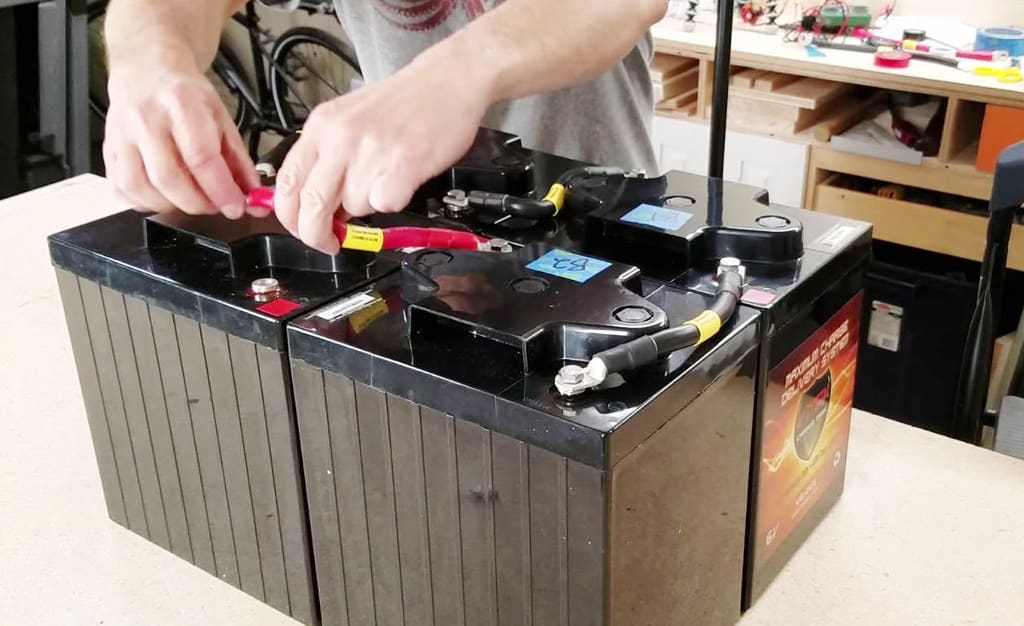
The kit includes a small PV panel, a controller and wiring, so you’ll need to buy an inverter and battery separately if you want AC power or backup power.
Best of all, the kit is super easy to install. It has pre-drilled holes and is compatible with most mounting brackets and clips.
- Great option for backup power
- Easy to install
- No official IP rating
- Low wattage
What Should Boat Owners Look for When Buying Solar Panels?
Solar panels can be a great option for marine use, but not all panels and solar kits are suitable for use around water. Additionally, the panel you choose needs to be selected based on how you want to use your solar power system.
In the sections below, we’ll include a few key things you’ll want to consider when choosing a solar module for your boat.
Energy Needs
One of the first things we recommend thinking about is how much energy you need your panels to generate. This will help guide you to what size panel and how much energy output you need.
If you’re just looking for reliable backup power for your boat’s internal 12-volt battery, or you want your panels to provide power for emergencies only, you’ll probably only need a panel of around 20 watts.
If you use your boat frequently for entertaining guests, or you spend days at a time on your boat, you might want something above 100 watts to provide backup power plus electricity for electric coolers, water heaters and more. Consider everything you’ll use your solar array for and size your system accordingly.
The chart below provides a quick breakdown of what size solar panels you need for different purposes on a boat.
| Single LED light | 3 watts |
| Phone charger | 10 watts |
| Backup battery for boat | 20 watts |
| Small electric fan | 50 watts |
| Electric cooler | 100 watts |
| High-end speaker system | 100 watts |
| Small solar water heater | 100 to 150 watts |
| Laptop charger | 125 watts |
If you plan on using your panels to replace an on-board generator, you can calculate how much electricity your boat uses and then size your system accordingly. It’s always advisable to go a little bigger than you think you need, as cloud coverage and the angle of the sunlight hitting your panels can cause fluctuations in solar power production.
If you have high energy needs, we also recommend considering a Maximum Power Point Tracker (MPPT) controller, which is more efficient than a Pulse Width Modulation (PWM) controller, which is more common.
Space Available for Installation
Just like residential solar systems are limited by available roof square footage, marine solar systems are limited by the available space for installation. This is an important consideration to make to ensure you don’t buy a panel that you won’t be able to mount or use in your vessel.
Before you buy any equipment, we recommend checking the measurements of the panel and deciding where on your boat you can install it. Some portable, foldable panels come with kickstands for temporary setups, but the smaller of our top picks can be set up just about anywhere without mounting brackets as well.
Type of Solar Panel
You’ll have a few choices for the type of panel you purchase for your boat as well.
First, you’ll need to decide between thin-film solar panels, polycrystalline solar panels and monocrystalline solar panels.
- Monocrystalline panels are the most efficient, so they’re the best suited for use on boats. The higher efficiency ratings will let you produce more energy per square foot, which is essential on a boat where space is limited. All of our recommendations above are monocrystalline.
- Polycrystalline solar panels can also work, but they won’t provide as much solar power.
- Thin-film panels are the most affordable, but they generate even less electricity and aren’t ideal for use where available space is minimal.
Second, you should think about whether you want a rigid solar panel with an aluminum frame or a semi-flexible one. Flexible panels contain special solar cells that can be a bit pricier, but they’re easier to install and are a bit more versatile. They can be mounted on curved surfaces, giving you more placement options.
Waterproof Rating
Since you’ll be using your panels on the water, it’s essential that you choose one with a good waterproof rating. Some of the best options are IP67 and IP65. These will ensure your panels and charge controllers or regulators remain safe and at low risk of fire even when exposed to moisture and direct water contact.
Accessories
Finally, you should consider what your kit comes with. Some come with only panels, so you’ll need to buy a controller, an inverter and a battery to complete your setup. Some come with a combination of these parts, although batteries and inverters aren’t commonly included. Some panels also include mounting brackets, although this is also uncommon.
Thinking about the additional equipment you’ll need to purchase after buying your panels will help you budget more effectively for your entire system.
How Do Solar Panels Work With Boats?
PV panels for boats work just like panels for residential use — they collect sunlight and route the energy either to a storage or use system.
Since boat solar systems are entirely off-grid, most require the following:
- Solar panels
- A charge controller
- An inverter
- Mounting brackets or other mounting hardware
- A backup battery for energy storage
We’ll explain what each of these components does in the section below, and then we’ll get into how to set up and maintain your system.
Equipment for a Marine Solar System
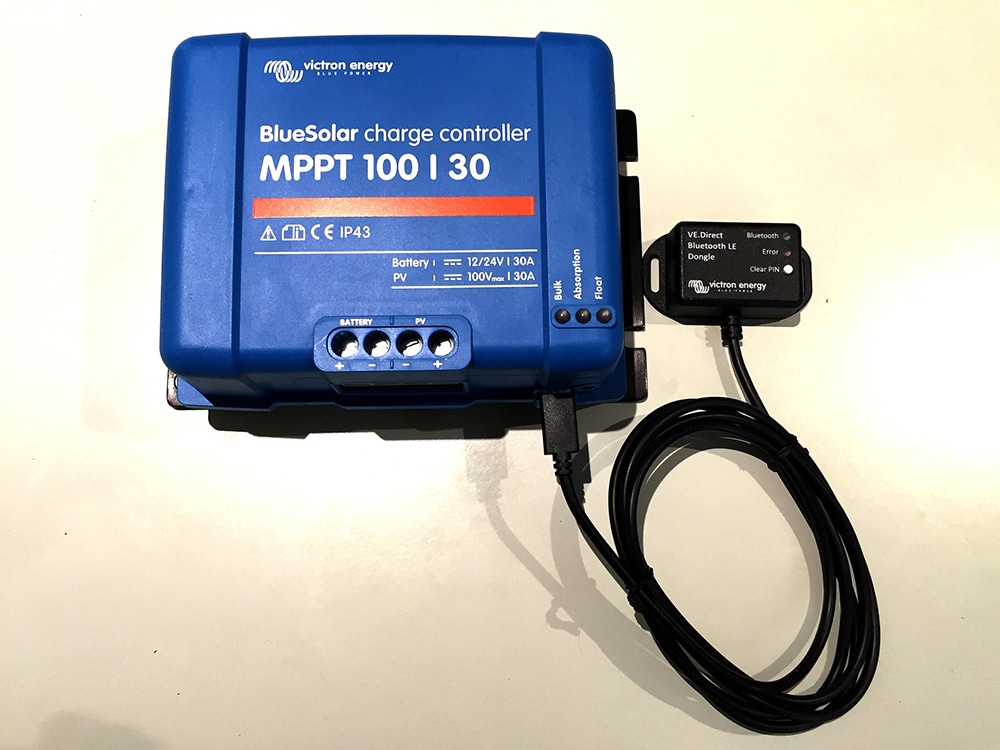
The main components you’ll absolutely need for your boat solar system are PV panels and a controller. If you plan to store energy or use it to charge common electronics, you’ll also need a battery and an inverter.
The panels are the pieces of the system that collect energy from the sun. The electricity generated is then passed to your controller, which limits the amount of power that flows through the wires to your battery or device.
The charge controller helps prevent overcharging batteries or electronics when production is high, and it also prevents battery drainage when production is low. Some panels are equipped with bypass diodes to provide the same safety features.
The solar energy that’s collected is direct current (DC), while most electronics, including standard light fixtures, use alternating current (AC) power. An inverter is used to convert DC current to AC so that you can use your solar power to power devices directly. If you don’t have DC lights in your boat, for example, an inverter might be necessary to provide lighting.
A battery storage system is exactly what it sounds like: it’s a battery bank that stores solar energy for later use.
Solar batteries are useful for two main reasons on boats.
- First, if you ever experience cloudy days, your solar production might very well drop below what you need to provide power to your devices. In that case, having a battery to pull stored energy from can be helpful in maintaining charging capability or electricity.
- Additionally, a battery on board can be useful for maintaining backup power for emergencies. If your boat’s built-in battery ever fails or you need to charge emergency communication or navigation devices, a battery will come in handy.
Installation
Since you want your solar panels to be exposed to as much sun as possible, it’s best to install them at or near the highest point on your boat — often the bimini. This will prevent them from getting shade from other parts of your boat during the day, regardless of which direction your vessel is moving.
It’s also typically best to install your panels as close to parallel with the surface of the earth as possible. Since your boat will be moving around a lot, it’s not realistic to install them facing the path of the sun in the sky as you would on a home. Laying them flat gives you the best chance of always collecting at least some sunlight.
You, of course, need to consider available space as well, so remember to take measurements of your installation site and compare them to your panels before beginning the process.
Finally, you should consider where your batteries will be — if applicable — and where your wiring will run once your installation is complete. Keeping these things in mind will help ensure that the installation process goes as smoothly as possible.
Below, we’ll include a brief step-by-step guide on how to install a solar system on your boat.
- First, take measurements of where your panels will be installed, the path the wiring will take to all components and where your battery, inverter and controller will be placed. Making sure you have enough room for all of your components will help avoid headaches once you get started.
- We recommend mounting your batteries, inverter and controller first. These are generally the easier components to mount, so they’re the easiest to move once installed.
- Next, mount your panels. The process for this will depend on the panels you choose and where you plan to install them. You should follow the installation instructions for the mounting brackets or hardware you purchase.
- Finally, you can wire your system, beginning with the connection between the panels and the controller and then the connections to the inverter and battery.
- You can test your system by using a voltmeter or by checking to see if your powered devices function as intended. Some controllers will also show you if your panels are providing energy and how much they’re producing.
For more guidance and information on how to set up your boat solar system, you can check out the video below:
Maintenance
Thankfully, solar systems are relatively maintenance-free once installed, although you should carry out routine system checks and cleaning to ensure you continue to enjoy maximum safety and energy production.
You should spray down your panels with water about once every six months to get any accumulation of dirt or salt off of them. This will help maximize energy generation. Around the same time, you should also check the wires and connectors for corrosion, which is more likely to occur if you use your boat in saltwater.
After major storms, it’s a good idea to ensure that none of the connections between components were lost. A simple disconnect could lead to your battery charging issues, which could be an issue if you ever need backup power.
Lastly, it’s worth mentioning that solar systems on boats are generally considered safe. There is a small risk of fire but provided you carry out the proper maintenance, you should avoid any serious issues.
Are Marine Solar Panels Worth It?
The answer to this question really depends on who you ask. For some boat owners, PV panels are essential. Not only can they provide backup power for emergencies, but they can also improve your quality of life at sea and the enjoyment of your boat.
For many people, these things are indispensable, so solar systems are well worth the investment. For certain types of boats — like small fishing boats and sailboats — solar panels will be the only source of electricity.
Other boat owners feel comfortable relying on generators if they have them, and some use their boats only for short durations, which makes having an on-board solar array less valuable.
For most people, though, having at least a small solar system to provide backup power for emergencies is worthwhile. From there, opting to up the size of your system to improve your time at sea isn’t hard to get behind.
FAQ: Marine Solar Panels
Below, we’ll answer a few of the most common questions we get about solar panel systems made for boats.
What are the best marine solar panels?
In our opinion, the best solar panels for boat use are the SunPower 170W solar panels. These are flexible panels that allow for easy and versatile installation.
They are some of the most efficient panels suitable for boat use, and they provide an incredible 170 watts each. This is enough power for just about anything you need electricity for on your boat and for emergency equipment in low-light conditions.
These panels are a bit expensive, and they don’t come with any additional equipment. However, the junction boxes have a waterproof rating of IP67, come with a five-year warranty for equipment and high efficiency and are made from high-quality, durable materials for years of use.
Will solar panels keep my boat battery charged?
Yes, solar panels can be hooked up to keep your boat’s 12 volt battery charged. However, you need to make sure you install a system that is sized appropriately for your boat’s needs.
You can check how much power your boat draws from its battery system by looking at the loads (in amps or watts) of each device. You can also use your battery monitor if you have one to check the energy demand of each individual component pulling power. Then, choose solar panels that produce a bit more energy than your system needs.
If you live in an area that experiences a lot of cloudy weather, you might want to size up your system even more to ensure your system generates enough electricity.
How much does it cost to put solar panels on a boat?
The cost to install a solar array on your boat can range from around $150 up to well over $1,000. Where in this range your total falls depends primarily on how much energy you need to produce.
If you’re looking for portable solar panels to take on and off a small boat with you for emergency use only — which is typical for sailboats and smaller boats that don’t normally have electricity — you’ll likely be looking at the $150 end of the spectrum.
If you have a much larger boat and want to be able to maintain power for your essential equipment and some non-essentials, then you’ll likely push your all-in cost closer to the higher end of the range.
What are the benefits of solar panels on boats?
Installing solar panels on your boat can provide quite a few key benefits, although the perks you’ll actually experience depend on your situation and your specific boat.
Perhaps most importantly, solar panels can charge your boat’s battery and maintain electricity for emergencies. Most systems — even small ones — can serve to charge your phone, GPS or other emergency devices in case you run into problems out on the water.
Larger systems can also provide power for recreational use, like charging phones, powering speaker systems, keeping beer cold and more.

Related articles
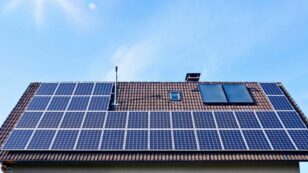
Calculate Your Solar Panel Payback Period (How Long To Recoup Costs?)

Solar Panel Cost In 2024 (Homeowner’s Installation Savings Guide)
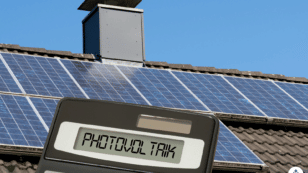
Solar Calculator
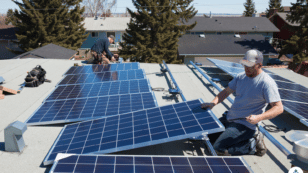
Top 6 Best Solar Companies Review
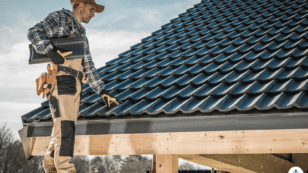
Solar Roof Shingles 2024 Cost and Buying Guide
Related Solar Panel Guides
- Buyer’s Guide: Best Solar Panels for Camping (2022)
- 7 Best Solar Panels for Mobile Homes (2022 Guide)
- What Are the Best Solar Panels for Farming Solar for Agriculture Guide (2022)
- The Best Solar Panels for Portable Solar Generators
- 5 Best Flexible Solar Panels (2022 Reviews and Buyer’s Guide)
Comparing authorized solar partners
Having trouble deciding? Click below and use our process to receive multiple quotes instead:
Advertiser Disclosure
Our editorial team is committed to creating independent and objective content focused on helping our readers make informed decisions. To help support these efforts we receive compensation from companies that advertise with us.
The compensation we receive from these companies may impact how and where products appear on this site. This compensation does not influence the recommendations or advice our editorial team provides within our content. We do not include all companies, products or offers that may be available.

- Multihull Sailor
- Real Estate
- Maintenance & Hardware
- Water Sports
The Different Types of Solar Panels for Boats
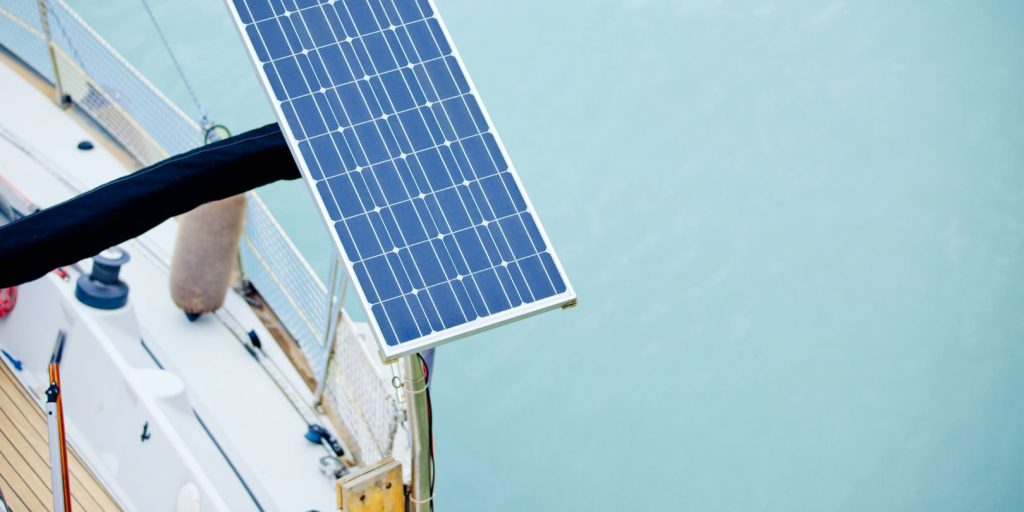
- 1 Monocrystalline Solar Panels
- 2 Polycrystalline Solar Panels
- 3 Thin-Film Solar Panels
- 4 Amorphous Solar Panels
- 5 Semi-Flexible Solar Panels
- 6 Rigid Solar Panels
- 7 Conclusion
Related Posts
As the world’s focus on sustainability intensifies, the allure of harnessing solar power for various applications, including marine settings, has grown significantly. For boat owners and enthusiasts, embracing solar panels offers a gateway to a greener and more self-sufficient way of navigating the open waters. The sun’s natural energy can power boats, reducing reliance on conventional energy sources and minimizing environmental impact.
In this blog, we delve into the diverse world of solar panels for boats , exploring the advantages and characteristics of each type. Whether you sail the vast ocean or cruise along tranquil rivers, understanding the array of solar panel options available will empower you to make informed decisions in embracing renewable energy and charting a course toward a more sustainable future on the waves.
Monocrystalline Solar Panels
Monocrystalline solar panels are known for their efficiency and sleek design, making them popular for boat owners seeking maximum power output in limited spaces. These panels are made from a single crystal structure, allowing them to convert sunlight into electricity efficiently. Monocrystalline panels boast an excellent power-to-size ratio, making them perfect for boats with limited roof or deck space. While they tend to be more expensive than other types, their durability and efficiency make them a wise long-term investment.
Polycrystalline Solar Panels
Polycrystalline solar panels are another prevalent option for marine applications. Unlike monocrystalline panels, polycrystalline panels have multiple crystal structures, slightly reducing their efficiency. However, they are more cost-effective to manufacture, making them a budget-friendly choice for boat owners. Polycrystalline panels are bulkier than monocrystalline panels, so they may require more space for installation. If you have ample deck or roof area on your boat and are looking for an economical solar solution, polycrystalline panels can be an excellent choice.
Thin-Film Solar Panels
Thin-film solar panels are highly versatile and lightweight, making them an attractive option for boats. They are created by depositing thin layers of photovoltaic material on various substrates, such as glass, metal, or plastic. Thin-film panels have lower efficiency than crystalline panels but perform better in low-light conditions, making them suitable for overcast or shaded areas on the boat. The flexibility of thin-film panels allows for easy installation on curved or irregular surfaces, making them an ideal choice for boat owners who value adaptability and space efficiency.
Amorphous Solar Panels
Amorphous solar panels, a subset of thin-film technology, are created by depositing non-crystalline silicon on a substrate. They are highly durable, lightweight, and flexible, making them a perfect fit for marine applications. Amorphous panels perform well in low-light conditions and have a better temperature coefficient than crystalline panels, meaning their efficiency drops less in hot environments. While they may have a lower efficiency overall, their ability to generate power in diverse conditions can be advantageous for long journeys or unpredictable weather conditions.
Semi-Flexible Solar Panels
Semi-flexible solar panels offer a middle ground between traditional rigid and thin-film options. These panels feature a thin layer of solar cells embedded in a flexible plastic or polymer material. Semi-flexible panels can conform to curved surfaces, making them suitable for mounting on boat decks, cabins, or sails. They are lightweight and easy to install, often requiring adhesive rather than bolts. While their efficiency might not match rigid crystalline panels, their versatility and ease of integration make them popular among boat owners.
Rigid Solar Panels
Rigid solar panels, typically monocrystalline or polycrystalline materials, are the most common type in various applications. While they are less flexible than other options, they remain a reliable and efficient choice for boats with ample deck or rooftop space. Rigid panels are durable, weather-resistant, and can deliver higher power outputs. They are ideal for boats with higher energy demands, such as those with multiple electronic devices or appliances.
Solar power is revolutionizing how we generate energy, and boats are no exception to this transformation. As boat owners seek eco-friendly and cost-effective solutions to power their vessels, solar panels offer a reliable and sustainable answer. Understanding the different types of solar panels available for boats is crucial in selecting the right solution for your needs, considering factors like space availability, budget, and desired efficiency. Whether you opt for monocrystalline, polycrystalline, thin-film, amorphous, semi-flexible, or rigid solar panels, embracing solar energy will propel your boat toward a greener and more independent future on the water.
Article Contributors
Sail magazine review team.
SAIL Magazine Review Team reports on best-selling products in sailing and boating. SAIL Magazine is reader-supported: When you buy through links on our site, we may earn an affiliate commission. Artificial Intelligence (large language models) may have been used in the research and creation of the content.
To ensure questions about product testing or a specific article are addressed, please contact [email protected]

Avasolar is reader-supported. When you buy via our links, we may earn a commission at no cost to you. Learn more
Choosing the Best Marine Solar Panels for Your Boat
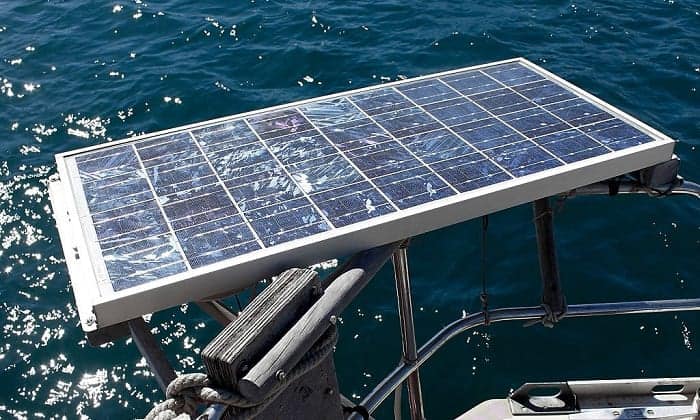
There’s nothing like kicking back and relaxing in a boat all to yourself. But while sailing the waves and soaking in the sun is an awesome getaway, you’ll still need to think about how to generate electricity while on board, especially for running your boat battery.
Get free power through solar energy with the best marine solar panels. Not only are they easy to set up and use, but you also save money by relying on renewable energy instead of paying expensive electricity bills like usual.
But how do you look for the most suitable solar panels for boats if there are dozens of solar panel types out there? Well, you’ve come to the right marine solar panels review. There are three key things you need to keep your eyes out for when choosing marine solar panel kits for your beloved boat.
- Waterproof: Since you’ll be traveling across bodies of water, you have to anticipate that your solar panels could get wet. Make sure your solar panels are resilient against water damage through waterproof designs.
- Flexible: Boats have curved surfaces, unlike roofs that are flat and can do with rigid panels. Marine solar panels can be straight and conventional, but it would be a big help if they were flexible so that you can mount them on tricky surfaces on your boat. Flexible solar panels hug irregular surfaces, ensuring they don’t topple over as your boat moves.
- Thin: Boats are small spaces as it is. You don’t need bulky, rigid panels occupying more space than necessary. Go for ones that are about an inch or so thick. Thinner solar panels are sleek and don’t take up too much space, so they’re a must for marine solar solutions.
There are many other factors you need to consider when looking through boat solar panels for sale. Check out the rest of the important factors in our buying guide below.
Need more help picking out a good boat solar panel kit? Look through this rundown of solar panels for boats reviews to see some of the most popular options.

Best Overall

Renogy Monocrystalline Solar Panel
| ✅ The solar panel has a durable frame |
| ✅ Power production is quite |
| ✅ Stops overcharging and short circuits |
Premium Choice
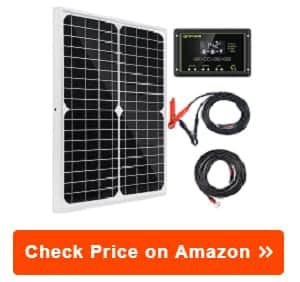
Topsolar Solar Panel
| ✅ Weighs only 4.8 lbs |
| ✅ Resistant to harsh weather |
| ✅ Has pre-drilled holes |
Editor’s Pick
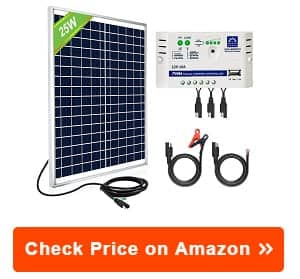
ECO-WORTHY Solar Panel
| ✅ 1-year warranty |
| ✅ Connector cables are quite long at 9.84 feet |
| ✅ Charge controller has power indicators |
Table of Contents
1. Renogy 100W 12V Monocrystalline Solar Panel
2. topsolar 20-watt monocrystalline solar panel, 3. eco-worthy 25w off-grid solar panel, 4. renogy extremely flexible solar panel, 5. suner power 30w polycrystalline solar panel, 6. newpowa monocrystalline 100-watt solar panel, 7. rich solar polycrystalline solar panel, 8. topsolar 100-watt 12-volt solar panel kit, 9. newpowa monocrystalline 30-watt solar panel, what to look for when looking through marine solar panel options, how many solar panels do i need to run a boat, how many amps does a marine refrigerator use, how do you install solar panels on a boat, top-rated marine solar panel reviews.
- Material: Monocrystalline
- Wattage: 100W
- Voltage: 12V
This solar panel kit by Renogy is awesome because it’s an all-in-one solar system. It includes all the necessary cables and accessories to get the show on the road.
The convenient kit includes a 100-watt solar panel, the Wanderer 30A PWM controller, and connectors and adapters. It even has Z brackets for mounting your solar panel. I like that I didn’t have to purchase all these separately.
I like that the Wanderer charge controller is negative ground, which means it prevents any overcharging and short-circuiting issues with our batteries.
Now, for the solar panel itself, I appreciated how the frame was made of sturdy, high-quality, corrosion-resistant aluminum, making the panel extra durable.
Its monocrystalline solar cells can convert 21% of the solar power to free energy you can use on your boat. That’s pretty high compared to other solar panels.
Plus, the production power of this solar panel kit is quiet, so it won’t bother you when you need silence.
- Includes the necessary connectors, controller, and mounting brackets
- The negative ground controller stops overcharging and short circuits
- The solar panel has a durable, corrosion-resistant aluminum frame
- Monocrystalline cells convert 21% of solar power into free energy for you
- Power production is quiet, so it will never disturb users
- The charge controller has no LCD screen
- Wattage: 20W
This Topsolar solar panel kit is another one that offers a lot of accessories. It comes with a charge controller, some alligator clips to hold your cables and connectors properly, and even an O-ring terminal.
The solar panel itself is made of thick, high-class tempered glass to protect the cells inside. It’s framed with aluminum for extra sturdiness as well. I love that it’s made of such premium materials, so I never have to worry about it being too flimsy or break apart easily.
All in all, the solar panel weighs a mere 4.8 lbs, making it easy to carry around. It’s lightweight enough for effortless lifting and transporting when I’m about to install it or move it to another area.
This marine solar panel is resistant to harsh weather, thanks to its maximum static load of 2,400 Pa. Because of this, you can use it worry-free, even in inclement climates.
There are pre-drilled holes at the back of the panel to make it easier to set up with screws and grommets.
- Comes with a charge controller, alligator clips, and O-ring terminal
- The panel is made of tempered glass and an aluminum framing
- Weighs only 4.8 lbs, so it’s easy to lift and carry around
- Resistant to harsh weather like wind or snow
- Has pre-drilled holes at the back to make set-up easier
- Doesn’t include mounting brackets
- Material: Polycrystalline
- Wattage: 25W
A long lifespan is one of the top factors I consider when looking for a marine solar panel. This one by ECO-WORTHY ticks off that box because it is built to last.
It’s made with highly efficient cells to give me adequate power output. The framing is designed with aluminum to make it sturdy, increasing its longevity.
This off-grid solar panel kit comes with a convenient charge controller. Its interface may not have a modern display screen, but it does have light indicators that update in real-time so you can tell how far your charge is coming along. It also has a USB port to let you charge your phones and other small devices.
The solar panel set comes with SAE connector cables to help users set up. They’re quite long and stretch to 9.84 feet, giving us maximum flexibility for moving our panel and charge controller around.
ECO-WORTHY offers a one-year warranty for this kit. You’ll also have access to the brand’s 24/7 hotline in case you have questions or concerns with your solar panel.
- Made with high-efficiency solar cells and aluminum for longevity
- Charge controller has power indicators that update in real-time
- There’s a USB port on the charge controller for small devices
- The SAE connector cables are quite long at 9.84 feet
- A one-year warranty with 24/7 technical support from ECO-WORTHY
- One 25W solar panel might not be enough to power multiple appliances
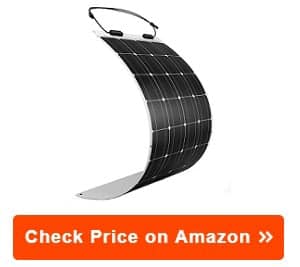
Setting up solar panels on curved surfaces is tough, but with these Renogy flexible solar panels for boats, it’s never a challenge.
These flexible solar panels bend to a 248-degree arc, which is a lot more flexible than other bendable panels. This is excellent for boat and yacht decks that are curved.
The panels are made of monocrystalline cells that emit 100 watts, ensuring a strong and reliable power supply for our consumption.
Transporting and setting up these flexible solar panels is a walk in the park, thanks to its lightweight and super thin design. They’re never bulky and retain the smooth silhouette of your boat.
They’re thin and light because they’re designed with advanced polymer, which is 70% lighter than other materials traditionally used to build solar panels.
These flexible panels are made to withstand bad weather. They resist impact and don’t get damaged in heavy loads of rain. You’ll find that they even tolerate up to 5,400Pa of snow.
- Bends to a 248-degree arc to fit irregular and curved surfaces and decks
- Monocrystalline panels emit a consistent 100 watts
- Super lightweight and ultra-thin, making it a breeze to transport
- Made with advanced polymer that is 70% lighter than traditional materials
- Resists impact and damage from heavy loads of rain and snow
- The cables in the solar panel kit aren’t the same length
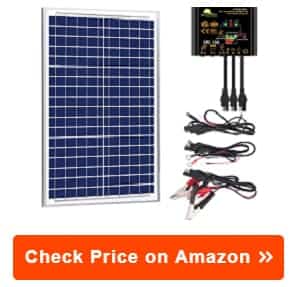
These solar panels by SUNER POWER are built with high-efficiency polycrystalline cells, giving me great performance even with the small energy output. They emit up to 30 watts of power to use as free energy on the boat.
This kit charges our batteries safely. It goes through a strict three-step intelligent algorithm to make sure our battery doesn’t go through overheating and short-circuiting, so I know I’m extra safe.
You’ll also find bright LED lights on the charge controller that indicate how the charge is coming for easy monitoring. It’s a convenient way to make sure our charging is right on track even when we’re doing other errands on the boat.
Tough weather conditions are nothing when it comes to this marine solar panel. It’s built with IP65 waterproof technology, so I don’t have to worry about the climate damaging my solar panel kit. It can even resist erosion, rusting, and damage from the sun’s UV rays.
- Polycrystalline cells emit 30 watts of power to use as free energy
- Charges our battery safely with an intelligent three-step algorithm
- Has bright LED light indicators so you can see how your charging is going
- Withstands tough weather because of IP65 waterproof technology
- Resists erosion, rusting, and UV damage in finicky weather
- The wires could be longer
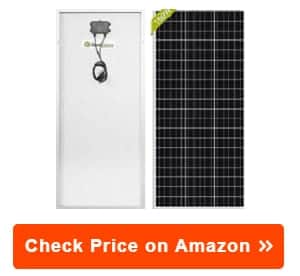
This Newpowa monocrystalline panel is smaller in size compared to most other panels. It comes up to about 45 x 20 inches, making it more manageable than bigger ones.
It’s made of monocrystalline cells that are highly efficient in turning power from the sun into free energy for our consumption and charging.
The panel’s aluminum framing prevents any corrosion, which extends the lifespan of the solar panel kit. That means I won’t have to constantly replace it.
The marine solar panel and some of its accessories are made to be waterproof. That way, they’ll survive even the most horrible weather conditions as you sail.
Venturing to areas and cities without much bright sunlight is no problem for this marine solar panel kit. The junction box is equipped with bypass diodes that ensure users don’t get any power outages even in cloudy, shaded areas.
- Smaller in size and more manageable than other solar panels
- The monocrystalline panels are efficient in converting power into energy
- Aluminum framing prevents corrosion, extending the solar panel’s life
- These monocrystalline solar panels can survive horrible weather
- Junction box has diodes to let your power work even in low-light areas
- You don’t get the rated 100-watt output every single day
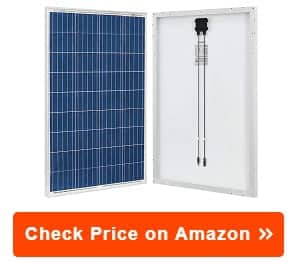
This RICH SOLAR panel is one of my favorites for travelling. I love it because it allows for more sunlight absorption. The panels’ anti-reflective, high-transmission film also helps make energy conversion more efficient.
Because of these factors, this panel works extremely well even in areas that are low in sunlight . So when I know I’m going to be sailing to cloudy shores, I make sure to bring this panel along.
This set uses quick-connect cables that don’t take more than a few seconds to fix up. It makes installation fast and easy even for beginners.
There are also about 14 holes on the panel so that you can simply screw it onto your mount. That means you can set it up without the complication of drilling the holes yourself. The design is also compatible with a variety of mounts, further adding to user’s convenience.
- Its anti-reflective panels are high-transmission for even more efficiency
- High conversion efficiency even in areas without bright sunlight
- Uses quick-connect cables, so setting up is fast and easy even for beginners
- There are 14 pre-drilled holes on the panel for quick installation
- Works with many types of mounts
- Doesn’t include mounting brackets, so you have to purchase some
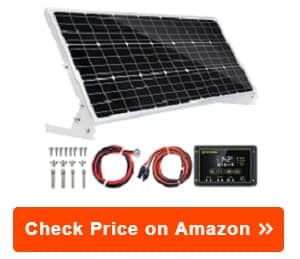
This solar panel by Topsolar emits 100 watts of power to charge any 12-volt battery while you’re on the go. It’s perfect for cars, RVs, and a huge range of off-grid uses, but it works excellently for boats too.
The panel is made with monocrystalline cells, protected by a coating of high-quality tempered glass. This protective layer also prevents wear-and-tear in the long term. Meanwhile, anodized aluminum frames the panel, protecting the edges from corrosion.
You get a V-shaped bracket along with your panel in this kit. This bracket allows users to tilt the panel in whatever direction they desire. It’s very helpful when we’re trying to position the panel to face the sunlight directly.
The charge controller this solar panel comes with is made with IP67-rated waterproof technology. This means it prevents any water damage from ruining our solar system.
- Charges any standard 12-volt battery while you’re on the go
- A wide range of uses
- The mono cells are protected with wear-resistant tempered glass
- The framing is made of anodized aluminum to protect the panel’s edges
- Comes with a V-shaped bracket to tilt the panel in the direction of the sun
- The charge controller is made with IP67 technology to avoid water damage
- The panel is quite heavy at almost 16 lbs, making it heavy to carry
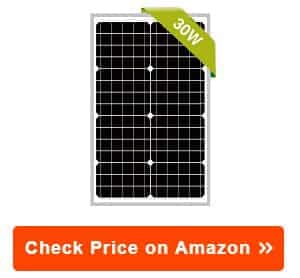
This Newpowa panel emits 30 watts of power. That may sound small to some people, but it’s perfect for charging small devices and running just a few appliances on a short boat ride.
It’s made with high-efficiency monocrystalline cells. These cells allow for a more compact panel design that is smaller and more manageable than the brand’s polycrystalline panels.
Multiple layers of the panel protect its cells. This includes an ethylene-vinyl-acetate encapsulation, iron tempered glass, and even a TPT back sheet that can help with heat dissipation.
There are wires already pre-attached to the panel, one at 3 ft and another at 1 ft. Both of these have Anderson connectors as well, so users don’t have to fuss about setting them up themselves.
The panel also has holes pre-drilled in them, so it’s ready to be screwed into your mount or bracket of choice.
- Provides 30 watts of power, perfect for small devices and short trips
- Made with high-efficiency mono cells that allow for a compact design
- Cells are protected by multiple layers, like tempered glass and TPT backing
- The wires and connectors are pre-attached, which is great for beginners
- Comes with mounting holes already drilled on the back of the panel
- The solar panel isn’t weatherproof, so you can only use it on sunny days
HQST 100W 12V Solar Panel (Outdated)
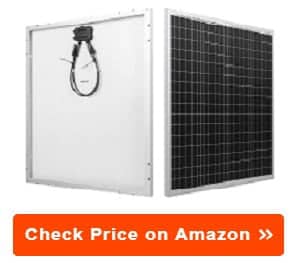
This 100-watt solar panel by HQST is designed for efficiency and durability. The panel itself is anti-reflective, thanks to thick and durable tempered glass. It’s also lined with aluminum in its framing, which resists corrosion and damage to the panel’s edges.
Polycrystalline solar panels like this one are made with high-efficiency cells that convert more power into energy than the usual panel. They also contain diodes to bypass any power outages or drops when your boat travels into a shaded area.
This kit’s junction box is rated IP65, which means it’s waterproof. That way, it can resist damage from water jets and uncontrollable weather.
Installation is a breeze with the pre-drilled holes at the back of this panel. It’s perfect for newbies that don’t want to call in a professional to set it up.
- The anti-reflective panel is made with sturdy tempered glass
- An aluminum frame
- Polycrystalline panels efficiently convert the sun’s energy into power
- Contains diodes to bypass power outages when you go into low-light areas
- The junction box is rated IP65 to resist damage from undesirable weather
- Comes with holes drilled at the back of the solar panel for easy mounting
- The wires on the panel are quite short
WindyNation 100W Off-Grid Solar Panel (Outdated)
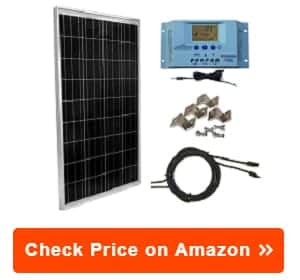
I love that this solar panel by WindyNation gives off a consistent 100 watts of power, provided that the panels are positioned directly under the sun. That makes it an ultra-reliable panel that isn’t flip-floppy when powering our devices.
The solar system comes with many accessories you’ll need to set up and use your panel. There’s a quality charge controller, some mounting brackets, and all the necessary cables needed.
My favorite part about this system is the charge controller. It has a high-quality LCD screen that displays all the information I need to see about my battery as it charges. It even has a sensor to help me monitor the battery’s temperature.
I can also choose and adjust what information settings are shown on the screen, depending on my preference. Buyers can get whatever information they’d like to know—amperage, amp-hours, temperatures, voltage, and more!
- Consistently provides 100 watts of power when positioned under the sun
- Comes with a charge controller, mounting brackets, and cables
- The charge controller has an LCD screen
- Sensor for battery temperature
- You can choose and adjust what settings to see on your LCD screen
- You must purchase fuses and fuse holders to complete this solar system
SUNER POWER 12-Volt Waterproof Solar Panel (Outdated)
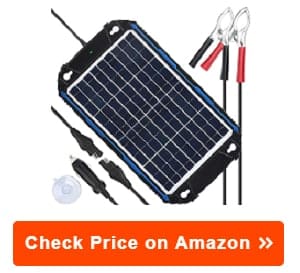
This solar panel by SUNER POWER doubles as a battery charger. It’s powered by highly efficient polycrystalline cells on a sturdy solar panel. These solar cells generate battery power in any condition, even when the sun isn’t so bright.
The charging system follows a stringent and smart three-step algorithm, keeping your battery safe as it charges. It does so with a unique “Maximum Power Point Tracking” (MPPT) chip, which prevents battery issues like overcharging and short-circuiting. MPPT also allows the charge controller to generate up to 30% more power than others do.
The controller has a LED light where you can see all the pertinent information on your battery, like whether it’s charging and if the battery’s full.
This entire solar system is made with IP65 waterproof technology. It won’t be susceptible to water damage, so users don’t have to worry about backflow from the water around the boat causing damage to it.
- High-efficiency polycrystalline solar cells generate power in any condition
- Has a smart three-step charging algorithm for a safer charge
- Its unique MPPT chip protects your battery
- MPPT controller generates up to 30% more solar power than others
- Has a LED light to indicate battery status
- The system is IP65 waterproof, so it won’t be susceptible to water damage
- Designed to work only on 12V batteries

Easy to install through grommets or adhesives
Setting up traditional solar panels on regular surfaces like walls and roofs can be difficult as it is. It might be trickier on a moving, swaying boat.
Make sure your marine solar panels are a breeze to set up. Look for ones that are okay to simply stick onto surfaces with adhesives, or have pre-drilled holes so you can screw them onto a mount quickly.
Provides an adequate amount of energy to power up your batteries and appliances
Select marine solar panels that will give you the right amount of solar power to meet your energy requirements.
For example, if you only need solar power on the boat to charge devices in the short term, 50W or 100W might be enough for your trip.
However, if you intend to use your solar panel to charge marine battery, you’ll definitely need one that converts a higher amount of solar energy—perhaps some 200 watt marine solar panels.
Comes with all the necessary accessories, like connectors and junction boxes
Don’t put yourself through the hassle of buying each part of your marine solar system separately. Look for solar panels that provide all the necessary cables, boxes, and accessories to get you set up immediately. Ensure that your panel comes with connectors, junction boxes, charge controllers, and more.
Manufactured by a legitimate and respectable solar power brand
You must always purchase solar panels from legitimate brands that will give you top-notch and high-quality panels. There are many bogus panels in the market today, so double-check to make sure the solar panels you’re buying come from good, renowned manufacturers
If you’re not sure which solar panels to buy, it’s wise to go for classic, tried-and-tested brands. These include Renogy, TP-Solar, and SunPower marine solar panels.
Plus, buying from bigger brands will increase your chances of getting a product warranty that lasts years.
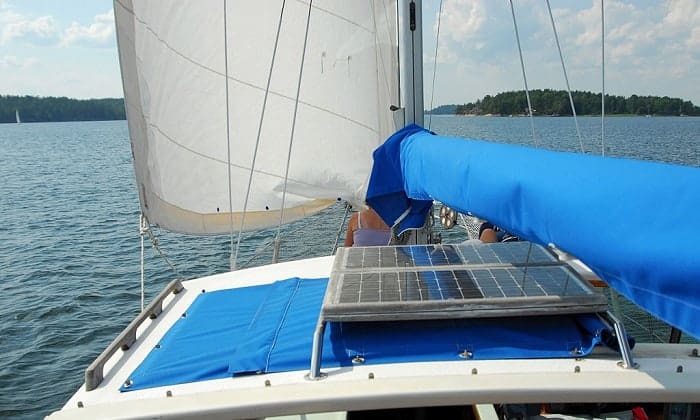
It depends on how much power you need to keep your appliances and gadgets up and running.
For shorter, one-day excursions, you can live with just one or two high-quality solar panels to provide some electricity to charge your phones and maybe a mini-fridge for the day.
But if you’re planning to sail for longer and live on the boat 24/7, you’ll probably need a bigger boat solar system with as many solar panels as you need. This is because you’ll likely have to run bigger appliances and lights, which demands more solar energy.
If you have a 12V marine refrigerator, it will likely only use up anywhere between 2-6 amps per hour. One solar panel emitting a usual 100 watts is more than enough power for such a fridge.
There are many different ways to set up solar panels on boats. If your solar panel is flexible, thin, and ultra-light, you can simply secure it in place with adhesives.
Thicker panels may need to be screwed in with grommets. If this is the route you’re going for, make sure you have sturdy mounting hardware to place your solar panels in.
Traveling through water may be relaxing and stylish, but the excursion is never complete without the best marine solar panels to provide solar energy and battery power during your trip. Hopefully, this round-up of traditional and flexible marine solar panels reviews help you out on your hunt to find the best panels.
Just make sure your panels are efficient in providing high power, waterproof to avoid damage from the sea, and thin and lightweight for easy mounting and storing. If you tick all those boxes, your sailboat solar panels should be all good.

I am Kathleen Miller, staff writer and reviewer of the Avasolar team. Working with the team has been a pleasure for me so far, I hope to bring readers useful information by creating detailed and easy-to-follow contents.
8 Best Boat Solar Panels in 2024 to Power Your Boat Sustainability
With plenty of sunlight but no access to mains electricity, solar power is made for boating, but this doesn’t mean you can use just any solar panel on your boat.
Green Coast is supported by its readers. We may earn an affiliate commission at no extra cost to you if you buy through a link on this page . Learn more .

Solar power is the perfect solution for meeting your energy needs when you’re out on the water, but you can’t necessarily use the same solar panel you would on your home. Here are our top picks for the best boat solar panels, as well as some info you should know when buying a marine solar panel.
The best marine solar panels for your boat
Thanks to advances in solar technology, there’s now a dizzying array of solar panels available on the market in various forms. However, some are better suited to marine conditions than others: the following products are your best bet to install on your boat.
1. Renogy 400 Watt 12 Volt Solar Premium Kit
For a truly powerful solar system, look to this 400-watt solution from Renogy . This comprehensive kit includes four 100-watt solar panels, a 40-amp MPPT charge controller, module fuse, mounting brackets and an adapter kit.

Combined, the panels output up to a total of 2.5kWh of electricity per day (provided there’s enough sun), to power most boat engines with power to spare for appliances.
The high-quality panels have a bypass diode that bypasses cells that are performing poorly because they’re in the shade, to minimize power drops when the solar panel is in partial shade, and therefore delivering strong performance in a low-light environment.
However, you will need enough space on your boat to accommodate four 40 x 21 inch panels, which will probably only fit on a larger vessel. Online reviewers also complain that the kit doesn’t come with detailed assembly instructions, so you may struggle to put everything together, especially if you’re a beginner.
What we like:
- Powerful: The total system delivers 400 watts of power output, or 2.5kWh of electricity, in optimum conditions.
- Bypass diode: Which maximizes the solar panel’s performance by bypassing cells that are in the shade, allowing the panel to perform well in low light.
- Powerful: This kit will produce a total of 400 watts, so is great for charging larger boat batteries or running a number of appliances onboard.
- Solid and durable: The panels have multi-layered sheet laminations and come in a corrosion-resistant aluminum frame, so will stand up to different conditions without damage, so you can be confident they’ll stay in good condition wherever you take your boat.
What we don’t like:
- Instructions not very extensive: The kit doesn’t come with an extensive manual to help you put everything together, so you might struggle if you’re not particularly handy.
Despite the lack of clear instructions, overall this is a well-made, powerful solar kit. If you need lots of power and have the space for four solar panels, this could be the best choice for you.
2. Newpowa 20W Monocrystalline Sailboat Solar Panel
This panel is a good choice if you have limited space and don’t need too much power for your boat. Each panel has only 20 watts of output, but is very compact: in fact, the new design is highly-efficient, allowing it to be even smaller than previous models, at just 13.6 x 14.2 inches.

With such small dimensions, you may be able to install several panels on an irregular boat roof or in other tricky spots. However, keep in mind that even with a few of these panels, you probably won’t have enough power to run your boat battery.
Newpowa’s 20-watt solar panel is built to last. It comes with a two-year workmanship warranty, and an output warranty that guarantees 90% power for 10 years, and 80% for 25 years.
The panel is slim, but with sturdy aluminum frames around the panel and between each cell, so it’s designed to stand up to harsh conditions, including winds up to 2400Pa and hail and snow loads of 5400Pa. Therefore, you’ll be able to take this panel on your boat through all kinds of weathers without it being damaged.
- Compact: At just 13.6 x 14.2 inches, this small panel will fit in all kinds of tight spots, making it easier to find a mounting location on your boat.
- Good workmanship: The panel is well-made, backed up with a generous warranty, meaning you can feel confident that on the slight chance of any faults or issues, they’ll be resolved by the manufacturer.
- Durable: The Newpowa panel has a sturdy aluminum frames between each cell, and can stand up to high winds, hail, and snow, which is obviously very important for solar panels for boats
- Low power output: This panel has a relatively-low 20-watt power output, which isn’t great because it will only supply enough energy to run one or two appliances part time.
Small, slim and durable, this high-quality solar panel is perfect if you have low power needs on your boat, or as part of a larger solar system.
3. ACOPOWER 35W Polycrystalline Sailboat Solar Panel
Specifically designed for boats, this small polycrystalline solar panel provides 35 watts of power. It’s highly efficient with a conversion rate up to 19.1%, so you’ll get the maximum amount of power output in return for the precious space on your boat.

Suitable for all climates and conditions, the silicon cells have a protective coating and come in a corrosion-resistant aluminum frame. It’s rated for high winds to 2400Pa, snow loads to 5400Pa, temperatures between -40 and 176 degrees F, and up to 100% humidity.
We also love that this panel is easy to install, coming with four pre-drilled holes, junction box and a three-foot solar cable. It’s compatible with a range of mounting systems, including Z-brackets, pole mounts, and tilt mounts, making it easy to place virtually anywhere on your boat, from the roof to the stern.
- Suitable for all weathers: The panel is rated for extreme cold and hot temperatures, as well as high humidity, winds, and snow loads, which is good because boat solar panels may be exposed to all of these conditions.
- Easy to install: It comes with pre-drilled holes for easy installation, as well as being suitable for various mounting systems, so can be mounted in varying locations on your boat’s roof.
- Highly-efficient: This panel has an impressive maximum conversion rate of 19.1% so will perform well in low-light environments, meaning you’ll still have power on overcast days.
- Inconsistent quality control: Some reviewers mention issues with parts and accessories failing or breaking, though many also mention the manufacturer quickly resolved the problem. However, it’s worth remembering the affordable price of this panel – so if the quality issue is a big concern, better to opt for something more premium.
Some online reviews mention issues with some parts breaking during install. However, with a five-year workshop warranty, a 20-year power output warranty, and lifetime technical support, you can feel confident that, on the slight chance that you do experience any issues, they’ll be resolved easily.
Despite even this, the Acopower is worth your attention because of its affordable price and easy, out-of-the-box design that’s easy to install right out of the box.
4. Newpowa 160W Monocrystalline Sailboat Solar Panel
For significantly more power, consider this 160-watt panel from Newpowa. The panel does involve a higher investment than small panels, but you’ll be able to charge your boat battery and perhaps even run some appliances with the power this product delivers.

The panel is made of top quality, high-performance polycrystalline cells fitted with an aluminum frame, making it efficient but durable. It uses 9 busbars (9BB) technology which converts light more efficiently while lasting longer.
It’s also easy to install, coming with diodes pre-installed in the junction box, as well as two pre-attached 3-foot MC4 cables, so all you need to do is mount the panel and you’re good to go! The well-made panel comes with a 10-year 90% power output warranty, 25-year 80% output warranty, and two-year limited material and workmanship warranty.
- Highly efficient: This panel’s use of 9BB technology makes it more efficient and longer lasting than many other panels.
- Easy installation: With pre-installed diodes and pre-attached cables, this panel is a piece of cake to install, so it’s a great option for those who aren’t experienced with this type of thing.
- Long life: The panel is made with advanced 9BB technology that is efficient and long-lasting, so you won’t need to replace your panel for years to come.
- Expensive: You’ll pay more for the extra power, so it’s important to be sure that a smaller panel won’t suffice.
This powerful and efficient Newpowa panel is built to last, evidenced by the generous manufacturer’s warranty, making it an excellent boat solar panel.
5. Nature Power 120W Portable Sailboat Solar Panel
This portable solar panel from Nature Power can be set up and used anywhere, so is a great solution if you don’t have space on your boat to install a permanent panel. Equally, this can be a good option if you only want to use it on a boat occasionally, and also use it when camping, trekking, or at home during emergencies.

The compact, foldable panel can be set up anywhere there’s sun, and then easily stored or transported after use. The panel folds out to 67.2 x 24.8 x 3 inches, and then can fold up into the size of a slim suitcase with an easy-carry handle.
Thanks to its high-efficiency, monocrystalline cells, this small panel can produce up to 120 watts and 6.67 amps of output. It also comes with a charge controller to help you efficiently charge your battery, and a built-in diode to avoid discharging.
Although the panel itself is well-made and robust, some online users complain that the clips and stand are less durable, with some reporting breakages.
- Portable: The panel can be folded up and easily transported, thanks to its easy-carry handle. This is great because you can use it on your boat when needed, then for other uses, such as for camping or emergencies.
- Highly efficient: Thanks to its advanced monocrystalline cells, this panel delivers 120 watts despite its small size and slim design.
- No need to install: Simply set up the panel on your deck when you need some power, and then fold it away, so a great option if you don’t want to fuss with installation or don’t have space on your boat to put it up permanently.
- Low-quality accessories: Some online reviews mention the poor quality of the panel’s accessories such as the clips and stand.
Overall, this portable solar panel is a great choice if you’re unable to mount a panel on your boat, or want the freedom to use it in different locations.
6. Nature Power 165W Sailboat Solar Panel
This monocrystalline solar panel is powerful, durable, and efficient . The modular design, robust aluminum frames, and scratch-resistant, anti-reflective coating means the panel will stand up to all weather conditions, making it perfect for your boat.

This panel is sold on its own, but the brand also offers an 8-amp solar charge controller that you can use with any 12-volt battery to build your own boat solar kit. The panel itself comes with a built-in diode, as well as “plug and play” connections that are easy to install.
- Monocrystalline: The monocrystalline cells make this solar panel very efficient, giving you a powerful output of 165 watts with just one panel.
- Robust: The panel is built to withstand all conditions, with a strong aluminum frame and scratch-resistant coating.
- Easy to install: The panel comes with simple, “plug and play” connections, making it a breeze to install, so is perfect for beginners.
- High cost: Because of its premium construction and features, this is not the most affordable solar panel on the market.
This panel is relatively expensive, and there are more affordable options available, but you get a high-quality, well-made panel in return for your investment. Furthermore, it comes with a 25-year power generation warranty, so you can be confident that you’re unlikely to encounter any major issues for years, and if you do, they’ll be resolved.
7. Topsolar 100W 12V Solar Panel Kit
This complete solar kit contains one 100-watt solar panel, intelligent charge controller, v-shaped tilt bracket, as well as two 16-foot and two five-foot cables with MC4 and O-ring terminals, making it easy to install and connect.

This set is designed for off-grid, outdoor use such as on boats, RVs, cabins, and yards, and suitable for charging car and boat batteries. The panel is highly durable, thanks to its corrosion-proof aluminum frame and tempered glass coating, so will cope with whatever conditions you throw at it.
The high-efficiency monocrystalline PV cells deliver 100 watts of power in a relatively compact 46.5 x 21.8 inch panel that’s just 1.37-inch thick. The adjustable mounting bracket can tilt to capture the maximum amount of direct sunlight, helping you get the maximum amount of power for your boat.
- Complete kit: With a 100-watt panel, charge controller, bracket, and cables, you have everything you need to set up and install your marine solar system.
- Tilted mounting bracket: Meaning you can tilt the panel to capture the maximum amount of sunlight.
- Versatile: The kit comes with two 16-foot and an additional two five-foot cables featuring both O-ring and MC4 terminals, meaning you can connect it to different types of equipment and in various locations.
- Problematic controller: Online reviewers complain about performance issues with the charge controller.
The most common complaint about this set is that the controller is low-quality, though the panel itself works very well. However, overall this is a good set for any boat with medium power needs.
8. 200 Watt 12 Volt Monocrystalline Solar Starter Kit w/ MPPT Charge Controller
This kit comes with two 100-watt poly/mono-crystalline solar panels, a 40-amp MPPT charge controller, Z-brackets for mounting the solar panel, an adapter kit, and connector cables. However, it should be noted that the kit lacks a few important accessories, such as fuses, so you’ll need to buy these separately.

Although these two 100-watt solar panel can supply up to 800Wh power output a day if there’s enough sun, they have a small footprint. This makes the kit ideal for boats, as you can install them in small and compact spaces, like the roof of your sailboat.
The solar panels are also highly-efficient, with 22% solar cell efficiency , significantly higher than many comparable products. With a corrosion-resistant aluminum frame, the panels will also stand up to all weathers, including winds of up to 2400Pa and snow loads of 5400Pa.
This means you can be confident they’ll last for decades no matter what kind of conditions your boat faces over the years!
- Maximum power for the footprint: The solar panels are highly-efficient, giving you the maximum amount of energy without taking up too much space.
- Corrosion-resistant frame: The aluminum frame is resistant to corrosion, so will keep its form in salt water and harsh weather.
- Charge controller included: The kit comes with an MPPT charge controller, adaptor, cables, and mounting brackets, so you won’t need to invest in extra equipment and can get started straight away!
- Some accessories not included : Although this is sold as a complete kit, it lacks a few important bits and pieces, so you’ll need to be prepared to avoid disappointment when trying to install your panels.
Overall, this is a good medium-sized kit that delivers a reasonable amount of power with the minimum footprint.
Why buy a boat solar panel?
Most boats require a lot of electricity, from powering navigation lights and radio systems to maintaining autopilot and, most of all, the boat battery. If you use your boat for longer trips, you’ll probably also need electricity for appliances like fridges, heaters, and even a TV.
Traditionally, many boats used gasoline or diesel generators to supply this power, but relying on solar energy instead has a number of advantages. Not only is it more environmentally friendly, but the sun will always shine (even if it’s not full sun), so you’ll have a continuous supply of energy and won’t need to worry about running out of fuel.

Furthermore, unlike noisy, smelly generators, solar systems are quiet, odorless, and don’t create excess heat, so won’t make your boat unpleasantly warm in summer. Once you’ve made the initial investment, solar panels are cheap to run, as you don’t need to pay for fuel – after all, sunshine is free!
What to consider when buying boat solar panels
There are many different types of solar panels, just as boats can come in all shapes and sizes. Therefore, it’s important to consider the various features offered by different panels in order to choose the right model for your boat.
Here are the key things to keep in mind when shopping for boat solar panels.
Panel output and efficiency
The first thing to consider when buying a solar panel for your boat is how much power it will produce, and whether this will be sufficient to meet your needs. You need to consider what you want to use the panel for: for example, do you just want to run a couple of onboard appliances, or are you looking to power your boat’s battery as well?
Once you’ve determined this, calculate how much power you’ll need (more on how to do that below), and this will give you an indication of the power output you should look for when buying your panel.

It’s important to get a robust panel that will stand up to all kinds of weathers and conditions without getting damaged.
The most durable panels come with a sturdy metal frame, often made of aluminum to keep weight to a minimum.
Waterproofing
Obviously, the ability to stand up to water is essential for any marine solar panel. Most good-quality solar panels for any purpose are highly resistant to water, as they’re designed to be placed outdoors in the rain.
Even still, it’s important to check that waterproof level of any solar panel before buying it for your boat. Specifically, look for a panel with a IP67 rating, as this indicates that the panel is highly resistant to water damage.
Weight and flexibility
Another important factor to consider is weight. You usually have two options when installing a solar panel on a boat: on the roof or on the stern, usually supported with some kind of bracket or scaffolding.
As neither boat roofs nor brackets are typically designed to support a lot of weight, it’s important to buy panels that are light. With limited space and low clearance, it can also be a good idea to look for thin panels that are not much more than an inch thick.
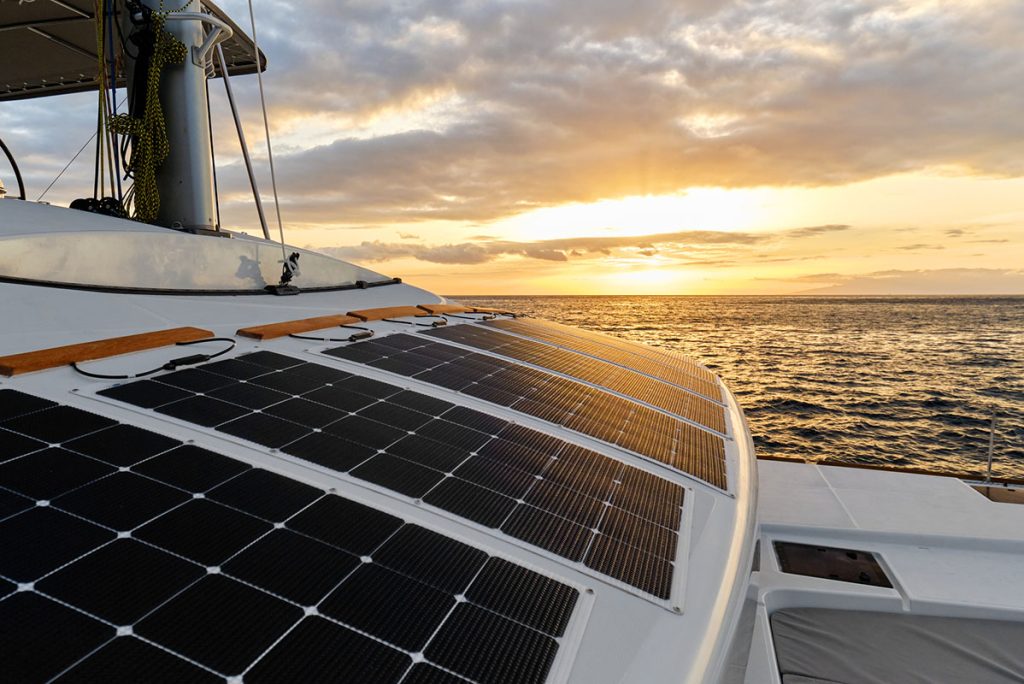
As most boats have curved roofs, a flexible solar panel can often be the way to go. These kinds of panels are not rigid, but can bend to fit irregular surfaces.
However, flexible solar panels tend to be less efficient and generally don’t last as long as rigid ones, so you’ll need to weigh up these factors to make the right choice for you.
Ease of installation
When buying a solar panel for any purpose, how easy it is to install is a key consideration, unless you’re planning to hire an expert to handle this for you. This is even more critical when buying a marine solar panel, as installing the equipment is more difficult than ever on a boat that may be moving and swaying with the waves.
Pay attention to how the panel is installed: flexible solar panels can often be simply attached with an adhesive, though you’ll need to make sure the glue is suitable for marine applications. Rigid solar panels can be more difficult to put up, though some come with grommets and pre-drilled holes that make things easier.
Reading user reviews on sites like Amazon will usually give you a pretty good idea of whether the panel is tricky or pretty straightforward to install.
Questions to ask yourself before buying t solar panel for your boat
The right solar panel for you will depend on a range of factors, from the size of your boat to your power needs. Understanding these key factors will help you to make the right decision and buy the perfect marine solar panel for you.
What size solar panel do you need?
You’ll need to work out how much energy you need to determine the right size solar panel to buy. You can calculate this by adding up the typical amp hours and volts used by all of the appliances on your boat – the average amp hours are usually printed on the label or elsewhere on the appliance.

For a more accurate measurement, use a battery monitor to get a reading of the amp hours your boat uses. Monitor your usage over several days while you’re on the boat (the more the better) and divide the total figure by the number of days to get your average amp hour usage per day.
How big is your boat’s battery?
You’ll also have to consider the size of your boat’s battery. Other than the power you use in the hours of peak sunlight in the middle of the day, you’ll only be able use as much energy as you can store.
Also keep in mind whether you want to be able to charge your boat’s battery with solar or run your boat on gas and use the solar panel for appliances only.
Most boats have a 12-volt battery, which needs around 350 watts of power to charge. However, larger vessels can have a larger battery, which means you’ll need more panels.
Do you have enough space for a solar panel?
Once you’ve determined the ideal solar panel size for your boat and your needs, you also need to work out how much space you have to accommodate the panel. Assess your boat for suitable locations, keeping in mind that you need to install your panels somewhere that gets plenty of sun.
You can either mount your boat solar panel on the roof or on the stern, using a bracket or similar.

If you want to mount the panel on the roof, you don’t necessarily need a completely flat spot: flexible solar panels can be installed on curved surfaces, with the added bonus that they’re lightweight so can be put on boat roofs that can support too much weight. Likewise, high-efficiency panels that offer the same amount of energy with a smaller footprint, like the ACOPOWER 35W Polycrystalline Sailboat Solar Panel can be a good solution for smaller boat roofs.
If your boat really doesn’t have any suitable spots to mount a solar panel, a backup solution would be to use portable solar panels that you could set up on your deck or a similar space.

Do you need a charge controller?
When setting up a solar system for your boat, you also need to decide whether you want to include a charge controller . Some of the kits above come with a solar charge controller included, like the Topsolar 100W 12V Solar Panel Kit , but you can also buy solar panels on their own.
Charge controllers regulate the amount of energy that flows from the solar panel to the battery, helping to ensure that it doesn’t get overcharged or overloaded. This is important, because either of these things can damage the battery and shorten its life.
For this reason, although a solar charge controller is not strictly necessary when installing solar panels on your boat, it can be a very good idea in order to protect your battery and make sure your boat uses the right amount of energy for its needs.
Wrapping up
A boat solar panel is the ultimate solution for self-sufficiency, allowing you to run your boat on the energy of the sun. You won’t need to worry about running out of fuel, and having to go back to shore.
Not to mention that by using this clean, renewable energy will help you to reduce your carbon footprint and be kinder to the environment.
If you’ve found this guide to the best solar panels helpful, you’re sure to enjoy our posts on the best portable solar panels for camping , flexible solar panels and solar power output .
Articles you might also like
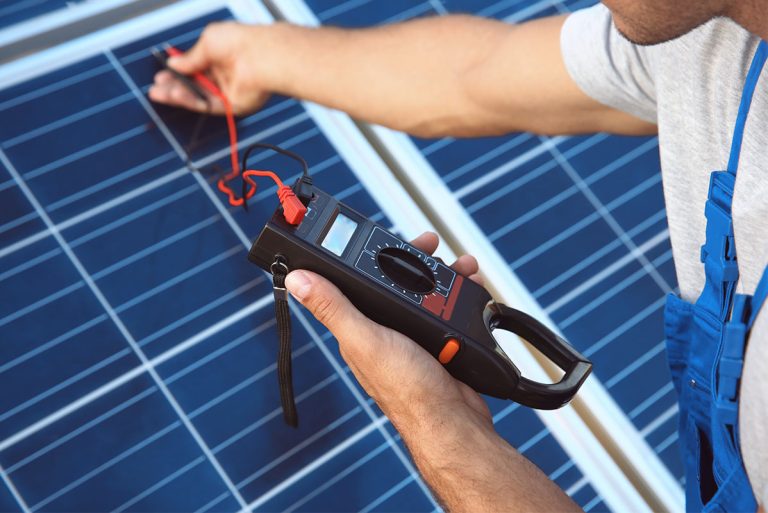
How to Test a Solar Panel: A Complete Guide
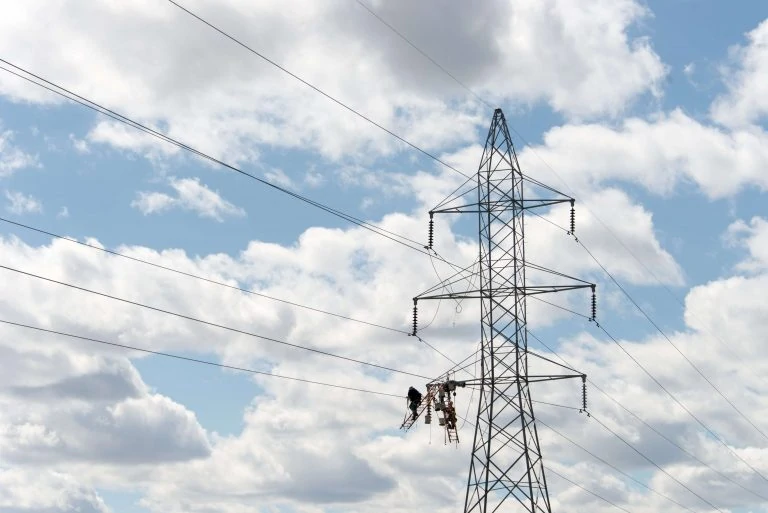
Current Flow Overview: How Electricity Travels Through Wires

Monocrystalline vs Polycrystalline Solar Panel: What’s the Difference?

What are Solar Panels Made of and How Are They Produced?

Advantages of Going Green

Best Energy Efficient Space Heater for 2024
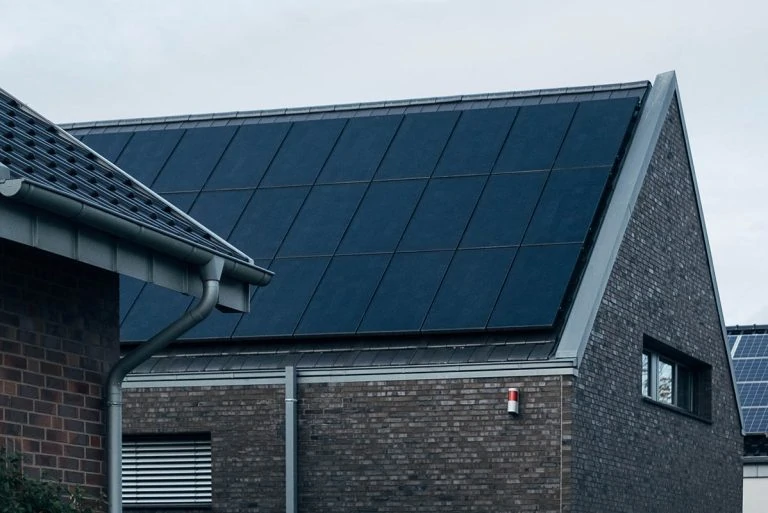
Pros and Cons of Solar Energy: What you Need to Know
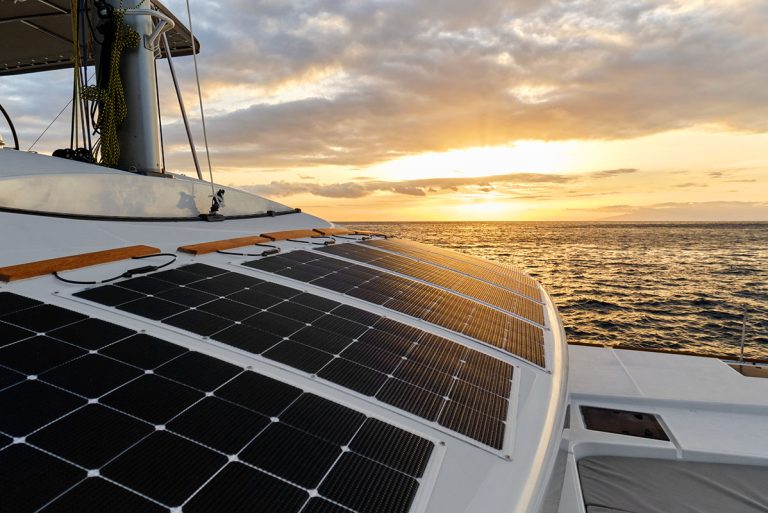
Flexible Solar Panels: What are They and Should you Buy in 2024?
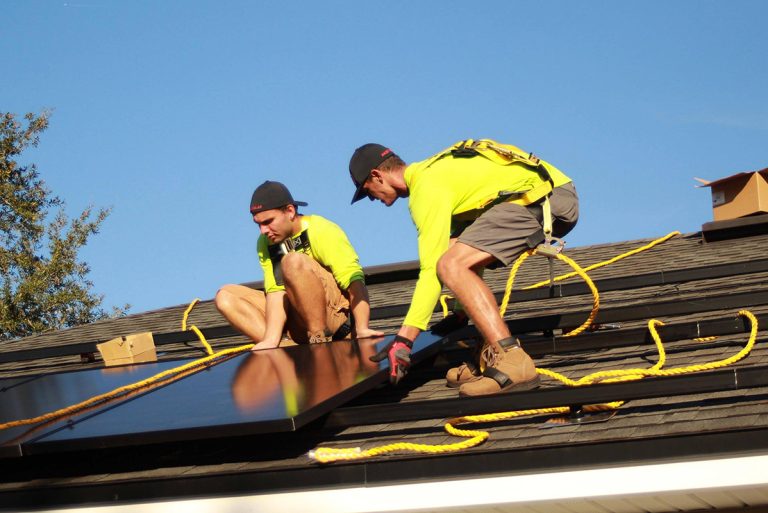
8 of The Best Solar Companies in Maryland
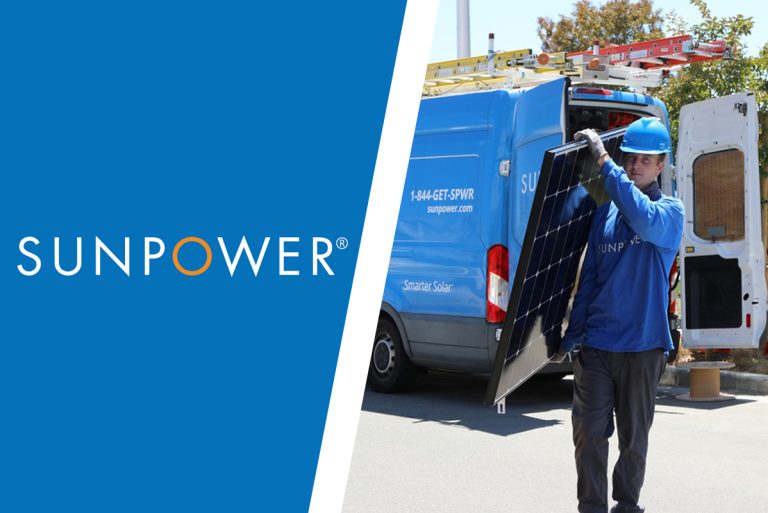
SunPower Solar Panels Review 2024: What is the Best Panel to Buy?
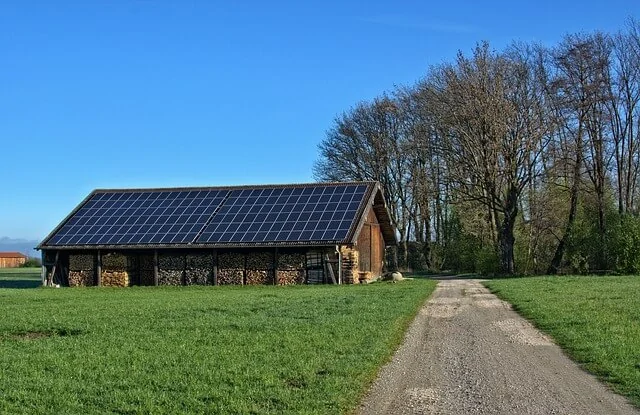
31 Top Solar Terms and Definitions: Learn Solar Buzzwords
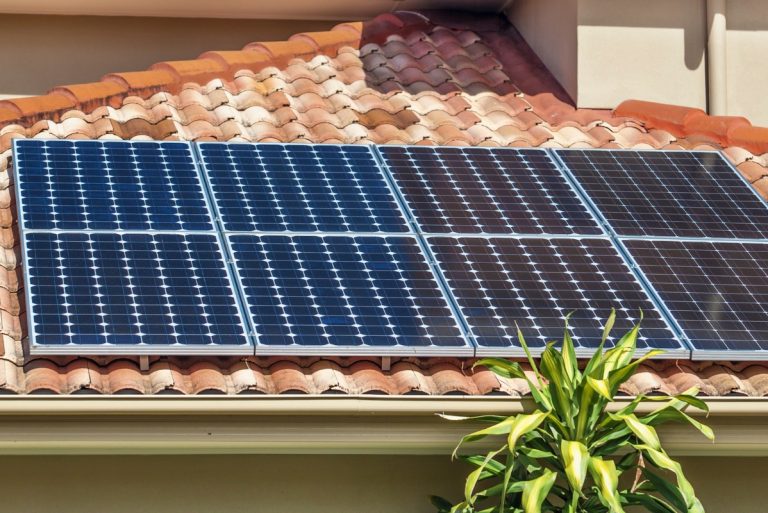
The Truth About Free Solar Panels
- BOAT OF THE YEAR
- Newsletters
- Sailboat Reviews
- Boating Safety
- Sails and Rigging
- Maintenance
- Sailing Totem
- Sailor & Galley
- Living Aboard
- Destinations
- Gear & Electronics
- Charter Resources
- Ultimate Boating Giveaway

Adding Solar Power to a Sailboat
- By Emily Fagan
- Updated: October 18, 2019
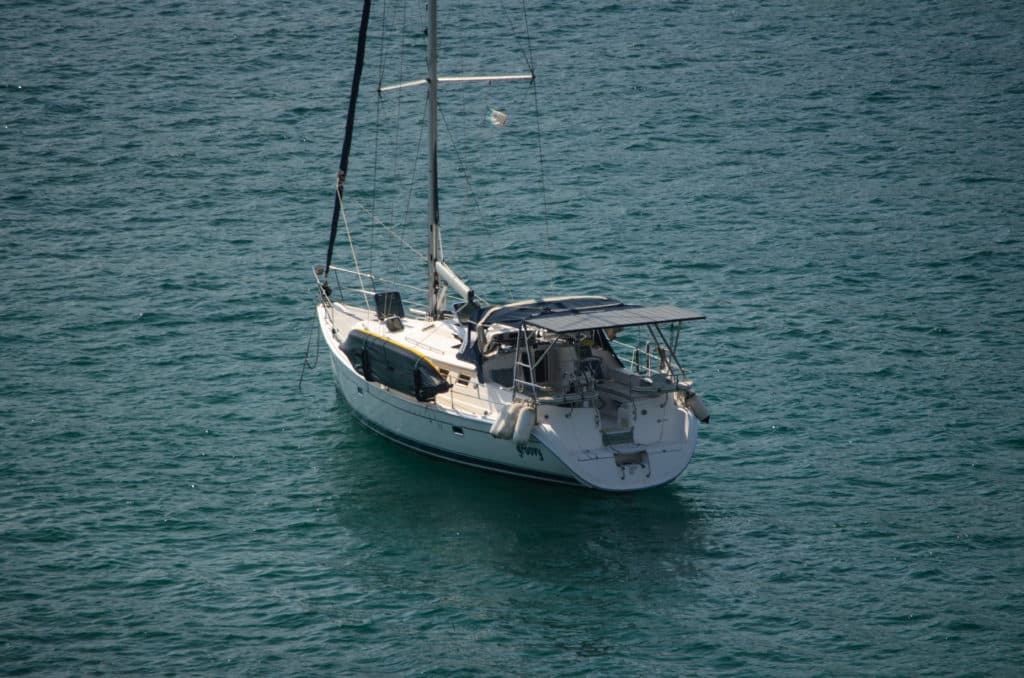
During our nearly four-year cruise of Mexico, my husband, Mark, and I lived almost exclusively on 555 watts of solar power charging a 640-amp-hour house battery bank. We anchored out virtually every night aboard our 2008 Hunter 44DS, Groovy , and relied on the sun for power. During one 10-week stretch, while we waited for a replacement engine alternator to arrive, our boat’s solar panels were our sole source of power. We had no backup charging system to turn to, and yet we lived and sailed comfortably the entire time. Mounting solar panels on a sailboat was not difficult, but a few key decisions made a huge difference in how effective our panels were.
A solar-power installation on a sailboat is made up of two independent systems: one system to charge the batteries, and another system to provide 120-volt AC power for household appliances. In the charging system, the solar panels convert sunlight into electrical current and deliver it to the batteries via a solar charge controller. Similar to a voltage regulator, the charge controller acts as a gatekeeper to protect the batteries from receiving more current than they need as they are being charged. In the AC power system, an inverter or inverter/charger converts the 12-volt DC power in the battery into 120 volts AC whenever it is turned on.
Panel Positioning and Wiring Considerations
One of the biggest challenges for sailors installing solar power on a sailboat is finding a place on the boat where the panels will be shaded as little as possible. Just a few square inches of shade on one panel can render that panel all but inoperable. Unfortunately, between the mast, radome, spreaders and boom, shadows cross the deck all day long, especially as the boat swings back and forth at anchor.
What’s worse, if the panels are wired in series rather than in parallel, this little bit of shade can shut down the entire solar-panel array. When we installed solar power on Groovy , we had already lived exclusively on solar power in an RV for over two years. Our RV solar panels had been wired in series, and we had witnessed the array shutting down current production when just half of one panel was shaded.
Choosing whether to wire the panels in series or parallel on a boat affects the wire gauge required, which is why many solar-power installers lean toward wiring the panels in series. Panels wired in series can be wired all the way to the solar charge controller with a thinner-gauge wire than those wired in parallel. This is because the voltage of panels wired in series is additive, while the current remains constant, so the current flowing is just that of a single panel. In contrast, the current flowing from panels that are wired in parallel is additive, while the voltage across them is not. This means that in a parallel installation, the current going to the charge controller is several times higher and requires much thicker cable to avoid any voltage loss over the length of the wire.
Not only is thinner-gauge wire less expensive, but it is also more supple and easier to work with, making the job of snaking it in and around various crevices in the boat and connecting it to the solar charge controller much less of a struggle. Thus the choice between series and parallel wiring boils down to a trade-off between system performance, expense and ease of solar system installation.
Luckily, the size of the wire can be reduced if higher-voltage solar panels are chosen. Since watts are determined by multiplying volts by amps, a higher-voltage panel that generates the same watts as a lower-voltage panel will produce less current. Therefore, selecting nominal 24-volt panels instead of 12-volt panels allows for the use of thinner wire sizes no matter how they are wired.
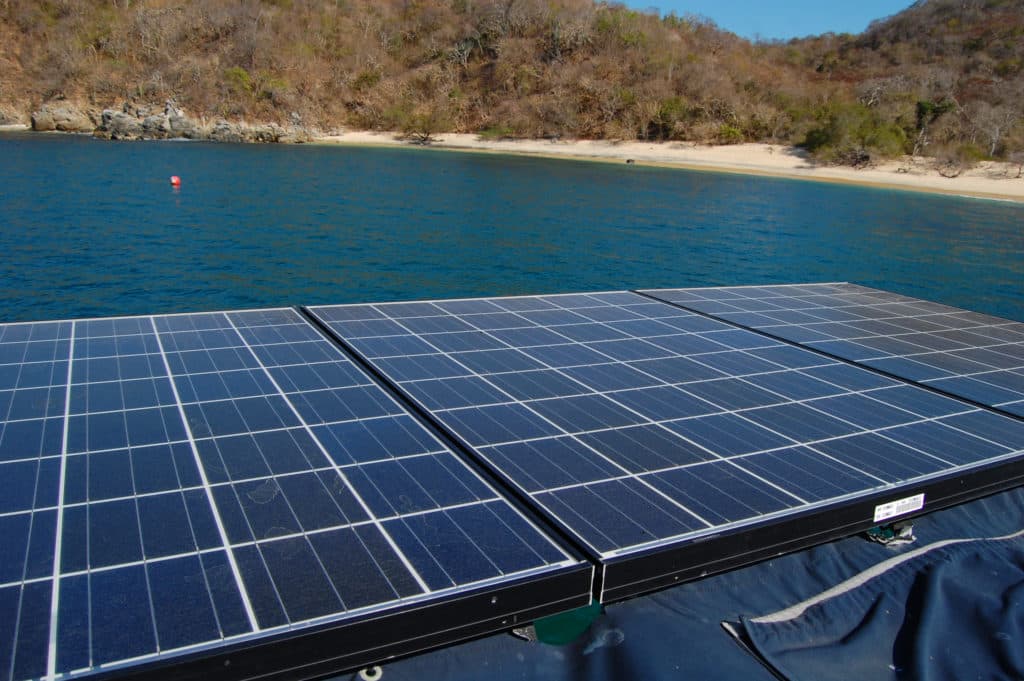
Our Marine Solar Panel Design Choices
In our installation, we decided to mount three 185-watt, 24-volt (nominal) Kyocera solar panels high above the cockpit, well aft of the boom, as far away as possible from potential shade. Our Hunter came with a big, solid stainless-steel arch, and we turned to Alejandro Ulloa, a brilliant metal fabricator at Baja Naval Boatyard in Ensenada, Mexico, to build a polished stainless-steel solar-panel arch extension onto the existing structure. He designed the arch extension with integrated telescoping davits to hoist our dinghy as well as support the solar panels. These davits were strong enough — and the lines and blocks had enough purchase — that either of us could lift our light Porta-Bote dinghy with its 6-horsepower outboard without a winch.
We spaced the panels about a half-inch apart and wired them in parallel. Using two twin-lead wires, we snaked the three positive leads and one common ground down through the inside of the arch tubes so they wouldn’t be visible, and placed wire loom over the exposed wires under the panels.
The junction points for the three parallel panels were on positive and negative bus bars inside a combiner box, all mounted in a cockpit lazarette. Inside the combiner box, we installed three breakers, one for each panel. This gave us the ability to shut off any or all of the panels if we needed to (we never did).
We mounted a Xantrex solar charge controller (model XW MPPT 60-150) in a hanging locker, as close to the batteries as possible, in a spot where it was easy to monitor and program. We ran twin-lead wire from the combiner box to the charge controller and from there to the batteries.
Our boat came with three new 12-volt Mastervolt 4D AGM house batteries, all wired in parallel, for a total of 480 amp-hours of capacity. We wanted a bigger house battery bank, and because it is best for the age, type and size of the batteries to be matched, we added a fourth new Mastervolt 4D AGM house battery, which brought our total to 640 amp-hours. Our batteries were installed at the lowest point in the hull, below the floorboards, and they ran the length of the saloon, from just forward of the companionway stairs to just aft of the V-berth stateroom door.
The best way to charge a bank of batteries that are wired in parallel is to span the entire battery bank with the leads coming from the charge controller. We did this by connecting the positive lead from the charge controller to the positive terminal of the first battery in the bank, and the negative lead from the charge controller to the negative terminal of the last battery. By spanning the entire bank, the batteries were charged equally rather than having the charging current focused on just the first battery in the bank.
We feel that AGM batteries are superior to wet cell (flooded) batteries because they can be installed in any orientation, don’t require maintenance, can’t spill (even in a capsize), and charge more quickly. Our Mastervolt batteries, like almost all AGM batteries on the market, are dual-purpose, combining the very different characteristics of both deep-cycle and start batteries. Our batteries work well, but if we were doing an installation from scratch today, we would consider the new Trojan Reliant AGM batteries. These batteries are engineered strictly for deep-cycle use and have been optimized to provide consistent current and maximize battery life.
Our boat came with a Xantrex Freedom 2,500-watt inverter/charger wired into the boat’s AC wiring system with a transfer switch. The inverter/charger performed two functions. While the boat was disconnected from shore power, it converted the batteries’ 12-volt DC power into 120-volt AC power, allowing us to operate 120-volt appliances, like our microwave. When the boat was connected to shore power, it charged the batteries.
Because this inverter/charger was a modified-sine-wave inverter, mimicking AC current with a stair-stepped square wave, we also had a 600-watt pure-sine-wave inverter to power our potentially more sensitive electronic devices. We chose Exeltech because its inverters produce an electrical signal that is clean enough to power medical equipment, and they are NASA’s choice for both the Russian and American sides of the International Space Station. For simplicity, rather than wiring the inverter into the cabin’s AC wiring, we plugged ordinary household power strips into the AC outlets on the inverter and plugged our appliances into the power strips. Like the charge controller, the inverter must be located as close to the batteries as possible. Ours was under a settee.
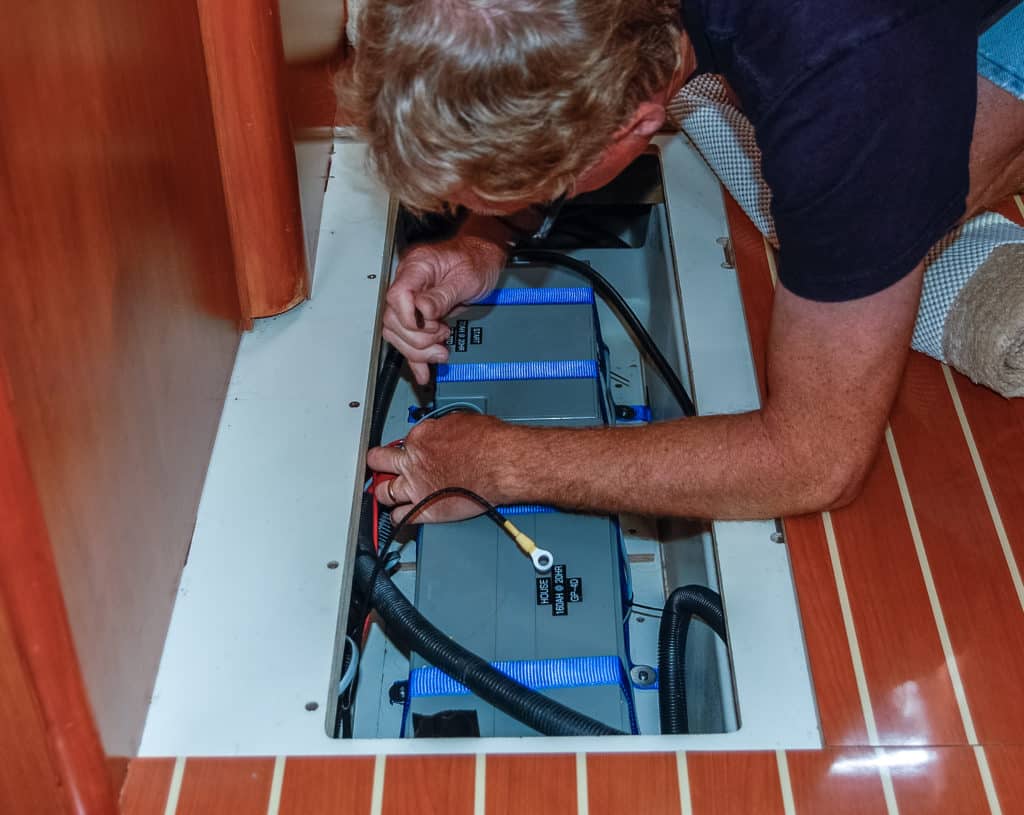
Shade’s Impact on Sailboat Solar Panels
Once our solar installation was completed on our sailboat, we closely observed the effects of shade on our solar-panel array. We were often anchored in an orientation that put the panels in full sun. Just as often, however, we were angled in such a way that shade from the mast and boom covered portions of our panels. It was fascinating to monitor the solar charge controller’s LCD display whenever the sun was forward of the beam — the current from the panels to the batteries fluctuated up and down as we swung at anchor.
Taking notes one morning, we noticed that the charging current was repeatedly creeping up and down between 9.5 and 24.5 amps as the boat moved to and fro. When the entire solar-panel array was in full sun, it generated 24.5 amps of current. When we moved so the mast shaded a portion of one panel, the array generated 15 amps. When it shaded portions of two panels and only one was in full sun, the array produced just 9.5 amps. Of course, it would have been preferable to see a steady 24.5 amps all morning, but this sure beat watching the current drop to zero whenever a shadow crossed a panel.
We discovered that shade makes a huge impact while sailing, too. Surprisingly, it is far worse to have the panels shaded by the sails than to have the panels in full sun but tilted away from its direct rays. One afternoon, we noticed that while we were on a tack that tilted the panels away from the sun, they generated 24.5 amps of current, whereas on a tack where the panels were tilted toward the sun but two of the three were partially shaded by the sails, the current dropped to a mere 10 amps.
Reflections On Our Solar Panel Installation
A wonderful and surprising side benefit of our large solar panels and arch system was that the setup created fabulous shade over the jumpseats at the stern end of the cockpit. Our metal fabricator, Alejandro, placed a support strut at hand-holding height, and sitting in those seats feels secure and comfortable while sailing, no matter the conditions.
After living on solar power for eight years of cruising and land-yacht travel, we’ve learned that you can never have too much solar power. Groovy’s 555 watts was enough to run all our household appliances as needed, including our nearly 4-cubic-foot DC refrigerator, two laptops, a TV/DVD player, and lights at night. However, it was not quite enough power to run all that plus our stand-alone 2.5-cubic-foot DC freezer during the short days and low sun angles of the winter months without supplemental charging from the engine alternator every few days. For the 10 weeks that we did not have a functioning alternator, our solution was to turn off the freezer, which enabled our batteries to reach full charge every afternoon.
Solar power made a world of difference in our cruise. Not only did it allow us to live comfortably and with ample electricity for weeks on end when our engine alternator went on the blink, but as a “set-it-and-forget-it” system, it also gave us the freedom to anchor out for as long as we wished without worrying about the batteries. In our eyes, the solar-panel arch enhanced the beauty and lines of our boat, giving her a sleek and clean appearance. It was true icing on the cake to discover that the panels and arch system also provided much-needed shade over the cockpit and helm from the hot tropical sunshine. If you are preparing for a cruise, consider turning to the sun for electricity and outfitting your sailboat with solar power.
The Installation:
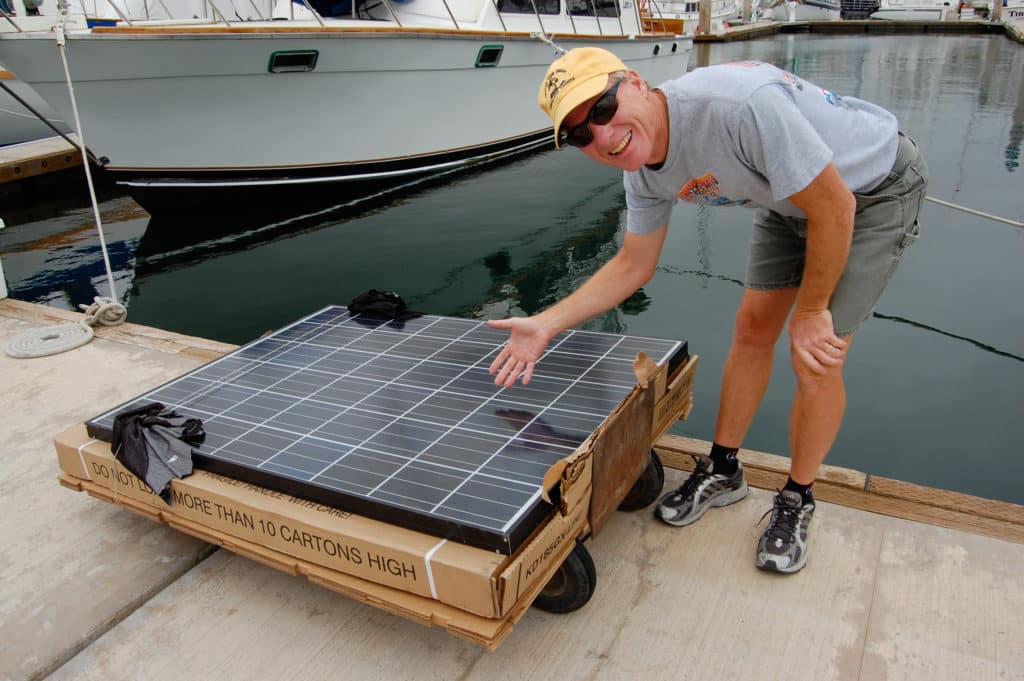
Emily and Mark Fagan offer cruising tips and share their stories and photos on their website, roadslesstraveled.us . They are currently enjoying a land cruise across America aboard an RV.
- More: DIY Sailboat Projects , green sailing , How To , installations , Refits , Sail Green , solar , solar panel , Upgrades
- More How To

Grease the Wheels of Your Boat: A Guide to Proper Lubrication

A Bowsprit Reborn: A DIY Renovation Story

Rigging Redo: Our Switch to Synthetic

Top Tools for Sailboat Cruising: Must-Have Gear for 2024

Galápagos: A Paradise Worth the Paperwork

Around Alone

- Digital Edition
- Customer Service
- Privacy Policy
- Terms of Use
- Email Newsletters
- Cruising World
- Sailing World
- Salt Water Sportsman
- Sport Fishing
- Wakeboarding
Updated 7 months ago
Everything you need to know about installing solar panels on boats
Written by Ana Almerini
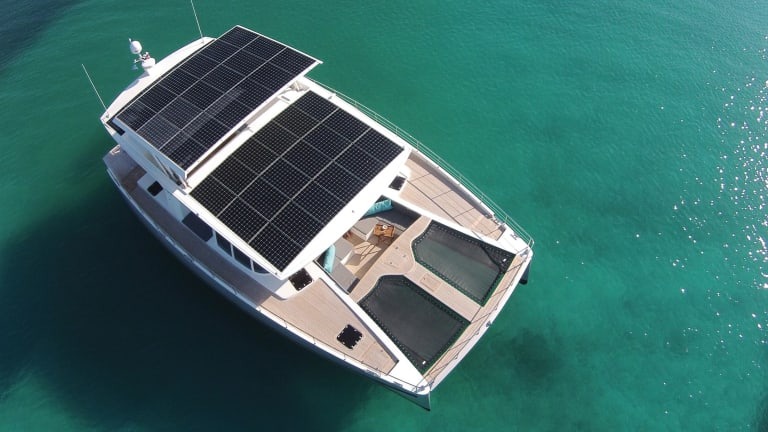
Find out what solar panels cost in your area
Solar panels built specifically for use on boats are a great option as a source of backup power when you’re out on the water. Solar panels act as a way to recharge the boat's batteries and keep your appliances running, all without needing to buy gas for a noisy gas-powered generator.
Marine solar panels are a relatively niche market, but there are plenty of options to choose from since typically, you can install any DIY off-grid solar panel on your boat.
Our favorite solar panels for boats are:
Topsolar flexible solar panel
Renogy 100W 12V solar panel
SunPower 170W solar panel
Below, we get into the best solar panels to buy for your boat depending on your needs, how to determine which size you will need, and why utilizing solar power for your boat is a smart idea.
Key takeaways
Solar panels on your boat maintain your battery’s charge to ensure that your appliances always have power, without a loud and expensive gas generator.
An average 30-foot boat will need about 350 watts of solar power to maintain electricity.
To determine how many panels your boat needs, you need to figure out how much power it uses, which you can easily do with a battery monitor. It also depends on how big your boat’s battery is.
You can install solar panels in unique locations on your boat but it is important that they can track the sun’s movement throughout the day.
What is the best use for boat solar panels?
Boats use a lot of energy for things like maintaining autopilot, keeping navigation lights on, and powering radio systems. Solar panels can provide the energy to carry out these tasks and maintain your boat's battery if it happens to be sitting idle. In either circumstance, your battery will never run out of energy.
Not to mention, compared to gas-powered generators, solar panels have the added benefit of being quiet. They also don’t produce excess heat that makes sitting in your boat with a gas generator unpleasant on hot days.
You can use solar panels for any size boat. For smaller sailboats, the main job of your solar panels would be to keep the battery fully charged for your boat’s electricity. For larger boats, they help reduce or eliminate the need to use the engine to provide excess power.
The average 30-foot boat would require about 300-350 watts of power . Depending on your energy use and boat size, you need more or less solar power to provide you with electricity.
How to choose the right solar panels for your boat
The first step to determining what size solar panel will work for your boat is figuring out how much power your boat is using . You can do this by checking the labels on your appliances for the typical amp hours and volts used.
Or, you can use a battery monitor to measure the amount of energy your fridge, lights, or the other appliances on your boat consume while in use. After finding the amp hours your boat uses per day, you can determine the wattage of power your solar panels need to produce.
Appliance | Power consumption | Power use (8 hours) |
|---|---|---|
Mini fridge |
| 800W |
Lightbulb |
| 480W |
Fan |
| 720W |
| : | 2,000W |
This example is extremely limited, you will need to determine how much energy your entire boat is using to make sure your panels provide enough power to keep your battery charged. But, technically if you had one 300-watt solar panel, or (3) 100W solar panels, they would generate 2,800W over those 8 hours. That energy would be more than enough to keep the above appliances running.
The size of your boat’s battery will also factor into which size solar panel you need . For instance, many DIY solar panels are meant to act as a battery charger to a 12-volt lithium battery, which is the typical size within a boat. But if you have a larger boat with a larger battery, you might need more than 350 watts of power.
Additional things to consider are whether you will need a charge controller and if you have enough unshaded space for your solar panels to absorb the maximum amount of sunlight.
Do you need a charge controller?
A charge controller acts as a regulator for the amount of energy that is transferred from your solar panel into your boat’s battery. This helps to make sure that your battery is not overloaded and overcharged, which can ruin the battery over time.
While it is not necessary, it is a good idea to install a charge controller with your solar panel system to help manage the energy load that your battery receives. This will prolong the life of your battery while ensuring your boat uses the exact amount of energy it needs.
Do you have enough space for boat solar panels?
Having a dedicated spot on your boat that has access to the full sun is key. Any shading, such as from a sail on your boat, will reduce the amount of energy your panels produce. While simply bringing portable solar panels aboard is an option, permanently mounting the panels to your boat makes it easier to always have your panels ready to go.
Because boats typically only have room for a small solar system, getting the most out of your limited space is key. With limited space, it’s best to look for high efficiency panels because you will need less of them to produce the energy you need.
Learn more : What are the most efficient solar panels in 2022?
Or something as simple as the setup below can power your boat's battery and be angled towards direct sunlight throughout the day while not taking up valuable space on the boat.
What are the best solar panels for boats to buy?
Any type of panel can be used on a boat such as monocrystalline, polycrystalline or thin-film. However, it is important to note that some companies exclude salt water and marine environments from their warranties.
We've listed some options below, you can choose based on where you have space to put the panels. For instance, thin-film panels are less efficient but they are flexible. So if you wanted to place a few panels on your boat’s roof versus one panel taking up valuable space, thin-film panels would be a good choice.
On the other hand, monocrystalline and polycrystalline panels have higher efficiency ratings and will ensure you get the most energy from your limited space or during low-light conditions. So if you have a location that can support racking, monocrystalline or polycrystalline solar panels are a better option.
Below are some of our top picks for solar panels for boats:
Most practical
Topsolar flexible solar panel
Cost : $149.99 Buy Now
The Topsolar 100W flexible solar panel is a practical, semi-flexible, cheap option. It does not come with a charge controller or an inverter but you can buy a few of these to create a simple solar panel system on your boat.
This flexible panel also allows you to utilize more space since this can be molded to fit untraditional angels on your boat.
Best quality, small cost
Renogy 100W 12V solar panel
Cost : $103.44 Buy Now
The Renogy 100W 12V solar panel is a great option. At 21%, it is a high efficiency monocrystalline panel manufactured by a reputable solar panel company.
There are pre-drilled holes for easy drilling to a mount on your boat. If you have space to secure solar panels to a mount, the Renogy panels will help you maximize energy output.
Best overall
Cost : $399.00 Buy Now
The SunPower 170W panel is a great flexible solar panel for off-grid use. Choose this option if you are interested in the versatility that a flexible solar panel offers and also want a reputable brand name with a high efficiency rating.
While these panels do not come with a solar charge controller, they must be used with one, so add one to your cart like the Victron Energy SmartSolar MPPT charge controller .
Why solar panels are a good choice for backup power on boats
Having a source of backup power on a boat is very important, you do not want to be caught far from land with a dead battery. Solar energy is the perfect choice because on a typical boating day, there is ample sunlight available as renewable energy. Because boats rely on a battery for electricity, a solar panel can ensure that this battery always has power.
There are many solar panel options available for your boat and can easily be installed DIY. They will help with your sense of security while saving money because you can skip out on the traditional gas generator and rely on a self-sufficient solar power system.
Ana is the Marketing & Communications Manager at SolarReviews, working within the solar industry since 2020. With a Master's in Climate and Society and professional experience in marketing, she helps communicate the value of solar to homeowners and build awareness of the SolarReviews brand. On weekends you can find her at the Jersey shore, reading a book from the ever-increasing stack on her side table, or eating food someone else cooked....
Related articles
The Best Marine Solar Panels of 2024
Recharge batteries and power up marine electronics by using the sun’s energy..

6 Best Solar Panels for Sailboats in 2023
Categories Boating

Solar panels are a great way to power your boat and enjoy off-grid benefits. You can use them for charging batteries, running lights, or even providing you with hot water. The best solar panels for sailboats are those that can withstand the harsh marine environment and provide you with clean, quiet energy.
Six best solar panels for sailboats
Here are our top six picks for the best solar panels for sailboats:
Renogy Flexible Solar Panel 175 Watt 12 Volt
This Renogy solar panel is one of the best options for a sailboat. This product has an efficiency rate of 16-18% and will produce an average of 175 watts.
The Renogy flexible solar panel is a durable and lightweight product that can easily mount on any surface.
The best feature of this product is the 10-year warranty that Renogy provides. This solar panel can be used in any weather condition and will not become damaged or broken easily.
The best part about this product is the price. It is one of the most affordable solar panels that you can purchase. This product is perfect for any boat or RV and will provide a reliable energy source.
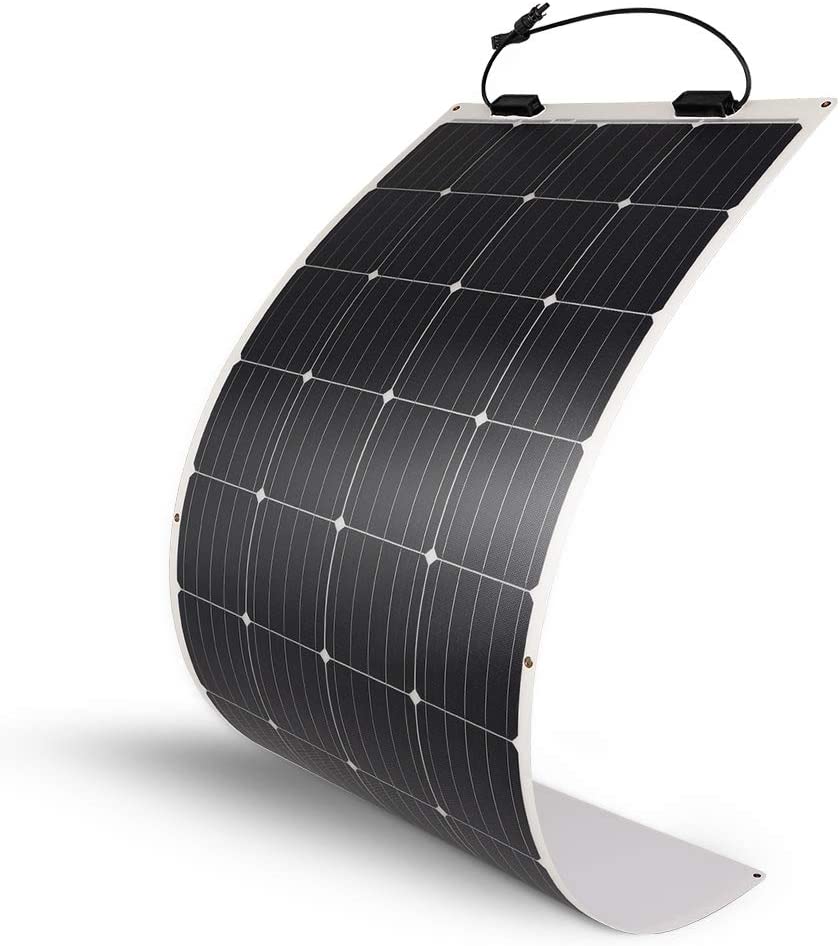
No products found.
HQST 100 Watt 12V Solar Panel
The HQST 100-watt solar panel is one of the best solar panels for sailboats. The HQST 100-watt solar panel can charge multiple batteries and other devices.
The HQST 100-watt solar panel is highly efficient as it can charge multiple batteries and other devices.
The HQST 100-watt solar panel is eco-friendly and durable. The HQST 100-watt solar panel is a one-time investment that will save you money in the long run.
The HQST 100-watt solar panel is water resistant, shockproof, and has an anti-corrosion coating.
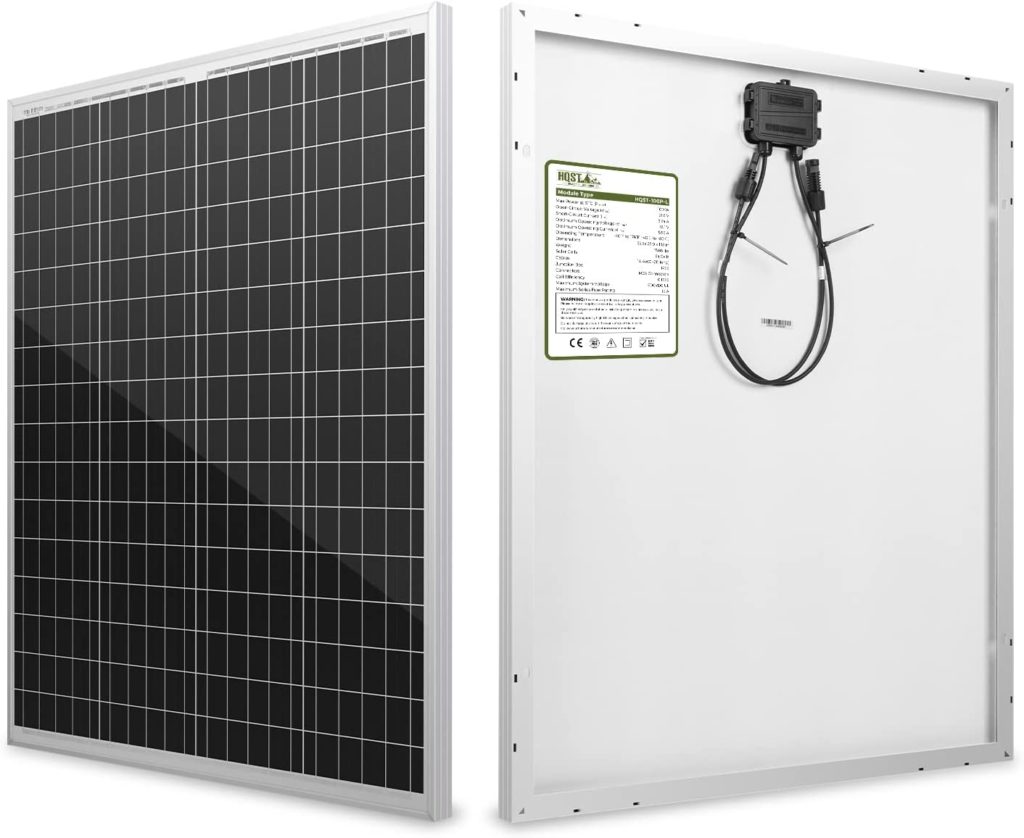
Topsolar Flexible Solar Panel 100W 24V/12V
The Topsolar Flexible Solar Panel 100W 24V/12V is an excellent option for sailboats. It is a practical, semi-flexible, cheap option. The connectors are incredibly robust and withstand lots of wear and tear over time.
The maximum energy absorption is crucial if you want to increase the performance of your solar panel.
The Topsolar Flexible Solar Panel can be mounted on pretty much any vessel, either flat on the surface of your deck or curved around the mast. This is an excellent feature as it allows you to take advantage of the sun’s energy no matter what shape your boat is.
You can use the Topsolar Flexible Solar Panel with the Topsolar Tripod for mounting your boat’s mast.
This is a great option to consider if you want something that will improve your sailboat’s performance without breaking the bank.
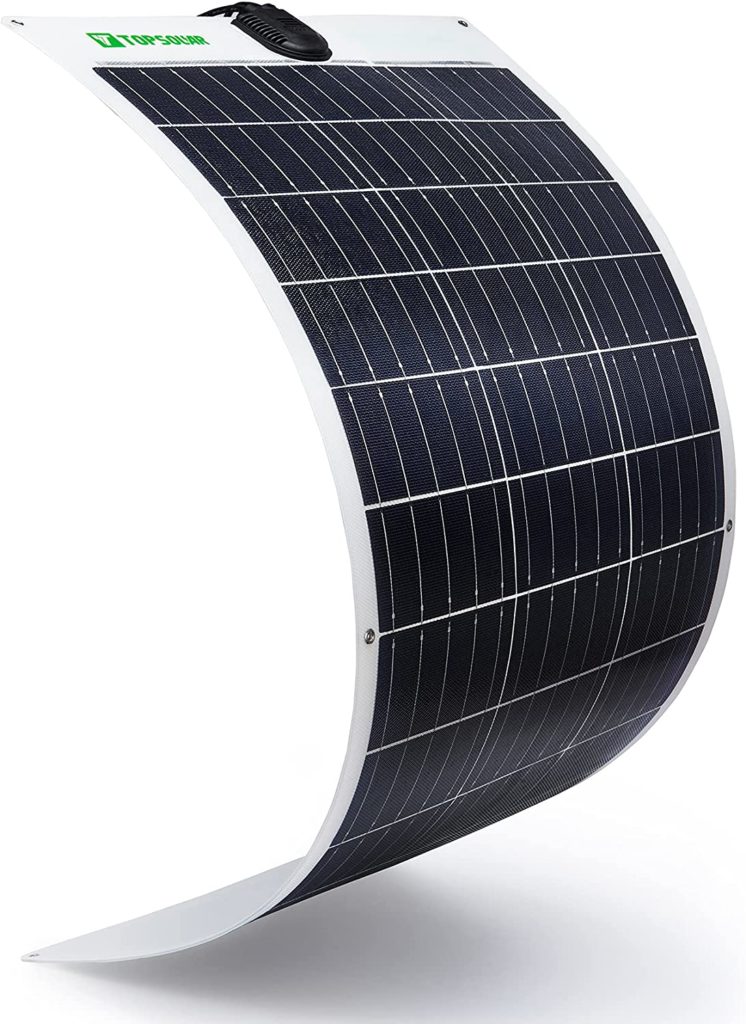
SunPower Flexible 110W Solar Panel
The SunPower Flexible Solar Panel is made with high-quality materials, ensuring durability. The solar panel can be easily portable and flexible. The solar panel has a five-year warranty on power and a two-year warranty on the product.
The solar panel is lightweight and has a durable build. The output quality of the solar panel may deteriorate over time, but you can use the extended warranty to address this issue.
The solar panel is also weatherproof, so the elements will not damage it. The only disadvantage of this solar panel is the price.
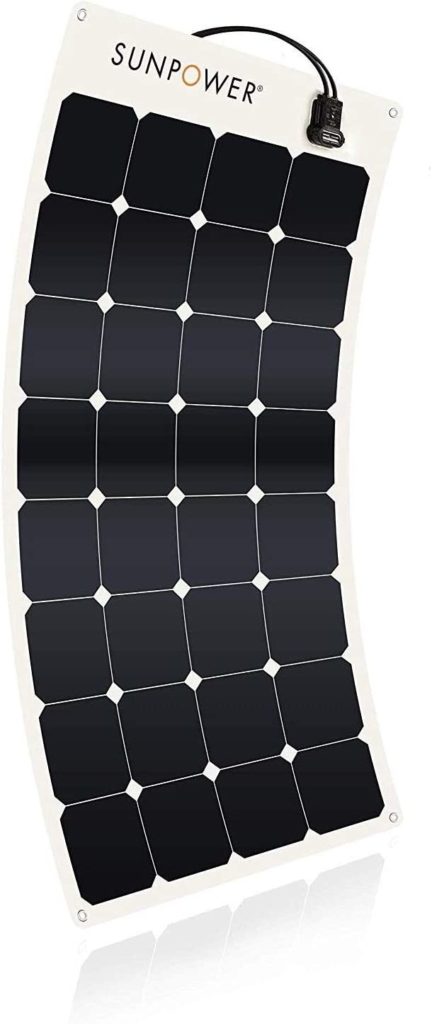
Newpowa 30W Watts 12V Solar Panel
The Newpowa 30W Watts 12V Mono Solar Panel is one of the best solar panels for sailboats. The Newpowa 30W Watts 12V Mono Solar Panel is a high-efficiency solar panel perfect for sailboats.
It is a monocrystalline solar panel that offers a 25-year transferrable warranty against a drop in power output.
The Newpowa 30W Watts 12V Mono Solar Panel is a 100% waterproof solar panel that can protect things when the doors and the soft or hardtop roofs are removed.
The Newpowa 30W Watts 12V Mono Solar Panel is a durable solar panel that can withstand weather conditions and sunlight exposure.
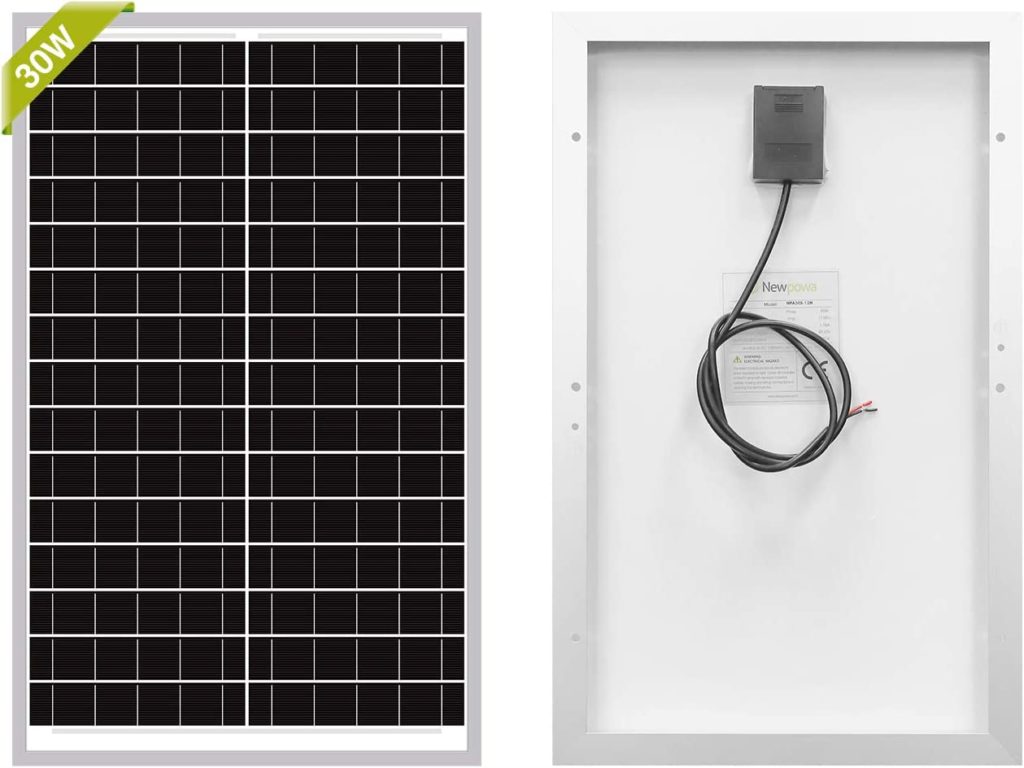
ECO-WORTHY 100 Watt Solar Panel
The ECO-WORTHY 100 Watt Solar Panel is one of the best solar panels for sailboats. This panel type comes with a warranty and IP65 water and dustproof rating.
This solar panel is lightweight (only 13 pounds) and has all the accessories needed to install it on your boat. The panel is easy to install and waterproof, so you don’t have to worry about any damage from the rain or water splashes.
The ECO-WORTHY solar panel is designed to work well with different types of boats. It has everything you need to install on your boat, including a mounting bracket and an MC4 connector cable.
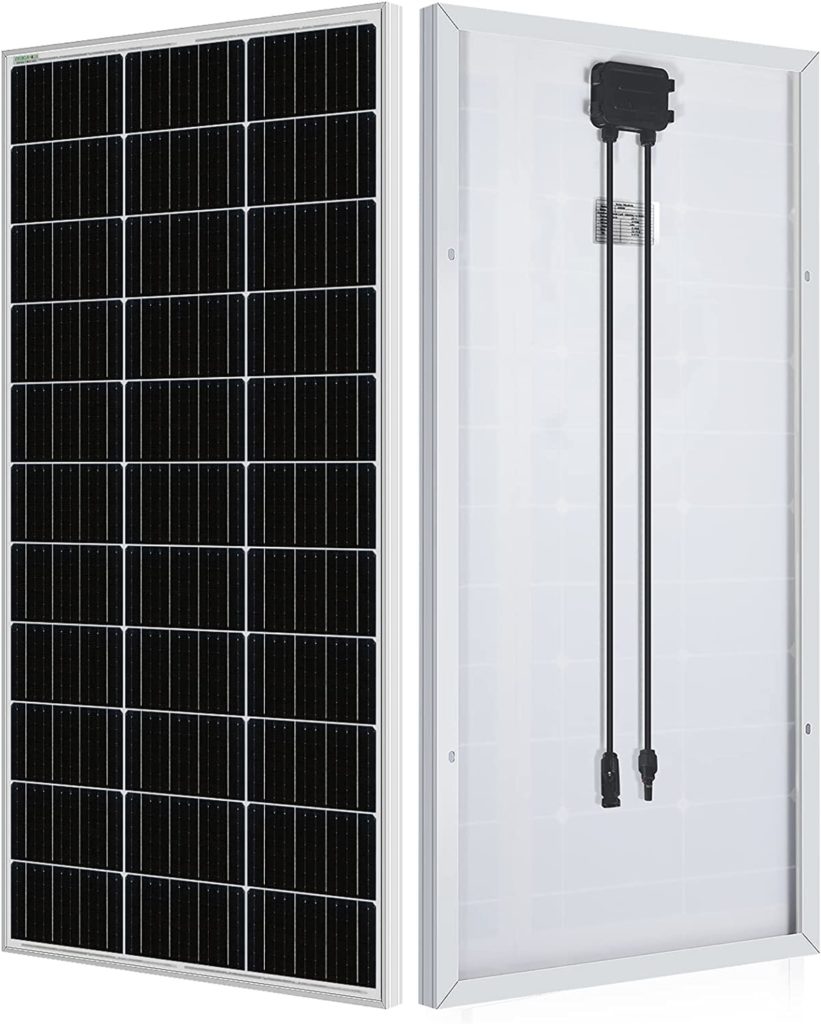
How to choose the right solar panels for your boat
To choose the right solar panels for your boat, you must determine how much power your boat uses. The first step is to determine how many amp hours your appliances use daily.
You can use a battery monitor to measure the energy your fridge, lights, or the other appliances on your boat consume while in use.
After finding the amp hours your boat uses per day, you can determine the wattage of power your solar panels need to produce. For example, if you have a 50-watt panel and use 30 amp hours per day, you would need two 50-watt panels to produce enough power for your needs.
Additional things to consider are whether you need a charge controller and if you have enough unshaded space for your solar panels to absorb the maximum amount of sunlight.
What are Flexible and Rigid Solar Panels?
Rigid solar panels are more efficient but less robust than flexible panels. Monocrystalline cells offer a better output than polycrystalline cells. The output voltage depends on the number of cells on the panel.
Module efficiency is now more often around the 20% mark, as opposed to 12-15% for older models and semi-flexible (up to 20° bend) is usually better than flexible (up to 180° bend).
If the maker offers a 25-year guarantee instead of a 3-5 year one, you can be pretty confident they’re good. Regarding charge controllers, it’s worth paying a little more for a decent MPPT.
How many solar panels do I need for my sailboat?
You will need between 2-8 solar panels for your sailboat. The amount you need depends on the size of your sailboat and how many electronics you need to power. 2-4 panels should be enough if you have a small sailboat. For larger boats with more electronics, 4-8 panels are recommended.
What are the benefits of solar panels for sailboats?
Solar panels are a great alternative to running a gasoline generator or taking power from the grid. Solar panels are eco-friendly and can be a lifesaver if you are at sea for a long time. Solar panels can provide comfort amenities such as access to a tv, microwave oven, etc.
Solar panels are an excellent option for sailboats because they are eco-friendly and have many benefits that make sailing more enjoyable. The best solar panels for sailboats are durable, easy to install, and produce a lot of power.
What are the disadvantages of solar panels for sailboats?
Solar panels for sailboats rely on the sun on to generate electricity. Sailboats are limited in space and cannot carry large solar panels. Solar panels can be expensive to install on a sailboat. Solar panels for sailboats are less efficient on cloudy days.
How much do solar panels for sailboats cost?
Solar panels for sailboats cost a few hundred dollars each. Permanent solar panels can cost one or two thousand dollars in some cases. Portable solar panels can cost just a few hundred dollars each.
If you are installing permanent solar panels because you plan to be making long voyages, it is ideal to have two or perhaps even three large batteries hooked up to your boat.
Do I need a professional to install solar panels for sailboats?
You do not need a professional to install solar panels for sailboats. Solar panels can be installed on sailboats by anyone that is reasonably handy. You can also install solar panels yourself if you are handy.
If you do not feel comfortable installing solar panels yourself, you can hire a professional to install the system for you. An excellent marine electrician will be able to help with your solar panel installation.
Are Solar Panels Safe On Sailboat Boats?
Solar panels are generally safe to use on boats. The panels themselves have a minimal risk of starting fires. However, if they are damaged, they may become unsafe.
Solar panels are covered by glass that keeps them safe from sharp shards of glass. However, if the panel gets wet, it can become deadly due to the combination of electricity and water.
- Click here - to use the wp menu builder
How to Convert Watt Hours (Wh) To Milliampere Hours (Mah) For Batteries
6 Best Solar Generators in 2024 Reviewed
4 Best Solar Generators For House Boats in 2024 Reviewed
4 Best Backup Power Sources for Security Systems in 2024
How to Choose a Quiet RV Generator for a Peaceful Camping Experience
How Long Can Food Stay in the Fridge Without Power?
The Ultimate RV Checklist: X Essentials for a Smooth and Enjoyable Trip
RV Outdoor Storage Solutions: How to Maximize Space and Efficiency
The Step-by-Step Guide to Installing an Outdoor Electrical Outlet
How to Prep for Emergencies in the City
15 Essential Items to Keep in Your Car for Emergencies
Everything You Need to Know About Prepaid Electricity Plans
What Are Thin Film Solar Panels?
What Is a Semiconductor?
Do Solar Panels Use Semiconductors?
Table of contents
Types of Solar Panels for Boats
How to choose the right solar panel for your boat, best marine solar panels.
Sign Up for Emails
And unlock a delightful surprise!
I agree to EcoFlow's Privacy Policy and Terms of Service.
5 Best Solar Panels for Boats in 2024

Marine solar panels are photovoltaic panels designed for boats and other watercraft. These panels can withstand the harsh marine environment, with features such as waterproof ratings and corrosion-resistant materials. Rigid arrays installed on the deck or roof of the boat are the most common, but portable solar panels have also become more widespread.
The main advantage of marine solar panels is that they provide a source of renewable energy that is clean, quiet, and requires no fuel. A renewable energy setup can be particularly beneficial for boaters who spend a lot of time on the water. It’ll reduce dependence on noisy and polluting fossil fuel generators and the time spent charging up with shore power.
Marine solar panels can also extend the life of a boat’s batteries by providing a consistent charging source. It’s handy for boats with limited engine run time or that rely on batteries for essential systems like lighting and navigation.
Marine PV panels are a reliable, efficient way to power onboard systems for vessels of all types.
Find the best marine solar panels for boats here and supercharge your watercraft for 2023.
Quick Overview of the 5 Best Solar Panels for Boats:
- Best for charging boat batteries: EcoFlow 100W Flexible Solar Panel
- Best for powering boat appliances: EcoFlow 220W Bifacial Portable Solar Panel
- Best for powering boats off the grid: EcoFlow 400W Portable Solar Panel
- Best for powering boat accessories: EcoFlow 110W Portable Solar Panel
- Best rigid marine solar panels: EcoFlow 100W Rigid Solar Panel
Portable Solar Panels
Portable solar panels are becoming increasingly popular for boats due to their convenience. They’re easy to transport and set up, providing a dependable energy source for a vessel.
Portable panels are also a cost-effective way to power boats. They don’t require fuel and have no maintenance costs. They’re also environmentally friendly, producing no emissions or noise pollution.
When selecting portable solar panels for boats, it’s essential to consider the size and rated power output, as well as the quality and durability of the panels. Weather resistance and waterproofing are also essential qualities. Look for panels with an IP68 waterproof rating.
Portable solar panels offer a practical and sustainable solution for powering marine vessels. They’re an excellent choice for boaters who want to reduce their environmental impact while enjoying their time on the water.
Rigid Solar Panels
Rigid solar panels are best for boat owners looking for a permanent solution to powering their vessels. These panels are fixed directly onto the boat’s surface, with the arrays made from durable materials like tempered glass or aluminum.
One of the main benefits of rigid panels is their efficiency. They produce more power per square inch than their portable counterparts, which makes them perfect for larger boats or vessels with higher energy demands.
Another advantage of rigid panels is their durability. Rigid arrays can withstand harsh marine environments, including exposure to saltwater and extreme weather conditions. Just make sure that the panels you choose have an IP68 waterproof rating.
Installing rigid solar panels on a boat can be complex, so ensure that the panels are mounted correctly to prevent damage or loss. This complexity allows for customization and expansion — you can create larger arrays by wiring multiple PV panels together .
Flexible Solar Panels
Flexible solar panels are a newer, more versatile alternative to rigid panels. They consist of lightweight and flexible materials such as thin-film photovoltaic cells, making it easy to affix them to curved, irregular surfaces.
The main advantage of these solar panels is their extreme flexibility. They can mold onto various surfaces, including boats, RVs, and other outdoor applications. They’re also incredibly lightweight, which makes them ideal for applications where weight is a concern.
Flexible panels are also highly durable, able to withstand harsh weather conditions , including hail , rain, and high winds. Make sure to purchase panels that have an IP68 waterproof rating.
The only downside is that flexible solar panels have a lower power output than rigid panels. Less power limits their ability to meet high energy demands. They also tend to have a shorter lifespan than rigid panels and may require more frequent replacement.
Overall, flexible solar panels are best for augmenting a rigid solar panel installation and maximizing available surface area for solar power generation. They are not designed to be a standalone solar solution.
Power Output
To calculate the solar panel output needed for a boat, you must first determine the total energy required by all the electrical equipment on board by calculating each device’s wattage and estimated run time.
Once you have this data, calculate the minimum panel output needed to meet this energy demand. Divide the total watt-hours required by the average number of sunlight hours per day.
For example, suppose you need 1500Wh, and your location receives five peak sun hours daily. You’d want at least a 500-watt panel array. Keep in mind that rated power for solar panels indicates the maximum amount of electricity the panel can generate under ideal conditions. It’s highly unlikely that any solar panel will consistently deliver its full rated power.
Power output also determines the solar battery and balance of system you can use since the solar power system must be compatible with the PV panels. You can’t feed electricity from solar panels directly into your boat appliances. You’ll need a portable power station or other power solution for your boat to store and distribute the energy.
One solar power solution for a boat is the EcoFlow Power Kit . The Power Kit contains all the required components — solar battery, inverter, charge controller, etc. — in a compact, space-saving plug-and-play modular system. You can mix and match the number of 2 kWH or 5 kWh LiFePO4 solar batteries and the power rating of PV panels for a customizable marine power kit.
Durability and Weather Resistance
The solar panels you choose for your boat should be resistant to impact and weather. An IP68 waterproof rating ensures that waves and rain won’t ruin your panels.
Size and Weight
The size and weight of the panels depend on the amount of electricity you need to generate and the available space on your boat. Calculate the amount of power you need to run your appliances, lights, and electronics. Then, purchase solar panels that can meet your energy demands without taking up too much space or adding too much weight.
Installation and Maintenance
The time and costs involved with installation and maintenance may influence which panels you pick. You may need to hire a professional to install the solar panels, or you may be able to do it yourself.
Not all solar panels require mounting brackets. With portable solar panels, you can skip the labor and costs of a permanent installation.
Brand Reputation
Purchase your solar panels from a reputable brand with a proven track record of quality and reliability. Read reviews and talk with other boat owners to see what they say about the brand you are considering.
As one of the highest-funded Kickstarter projects of all time, EcoFlow is an excellent example of a reputable solar brand that has been innovating and earning customer trust for years.
Solar panels vary in price depending on the size, efficiency, and brand. Consider your budget and choose panels that offer the best value for your money.
1. Best for Charging Boat Batteries: EcoFlow 100W Flexible Solar Panel
The EcoFlow 100W is a compact and portable flexible solar panel designed for outdoor use, including boating and other wet-weather activities. It provides an output of up to 100 watts of power, which is perfect for keeping your boat batteries charged.
Its flexible design makes it easy to carry and install. It mounts onto any smooth surface (including the curves of a boat). The IP68 waterproof rating means you can confidently take it out on rough waters.
Specifications
- Weight : 5.1 lbs (2.3 kg)
- Dimensions: 41.5 x 24.1 x 1.0 in(105.5 x 61.2 x 2.5 cm)
- Rated Power : 100W (±5W)
- Voltage : 20.3V
- Extremely Lightweight : This is one of the lightest PV panels on the market at only 5.1 lbs (2.3 kg).
- Easy to Mount : You can affix this panel onto curved surfaces, and it does not require mounting brackets.
- Low Cost: This is one of the most affordable panels on this list.
- Low Output : You’d need a higher wattage panel to power anything besides the boat battery.
2. Best for Powering Boat Appliances: EcoFlow 220W Bifacial Portable Solar Panel
This high-performance PV panel utilizes bifacial technology to capture sunlight from both sides of the panel. The design increases its energy output by up to 25%.
With a lightweight and foldable design, this solar panel is easy to transport and set up, making it ideal for carrying to and from your boat when going out on the water.
Durable materials and weather-resistant design ensure reliable performance in all weather conditions. Meanwhile, the kickstand case allows you to orient the panel for maximum efficiency.
Pair it with a EcoFlow RIVER 2 Pro Solar Generator , and the 220 watts of power output will support most boat electronics and appliances.
- Weight (Solar Panel): Approx. 20.9 lbs (9.5 kg)
- Dimensions: 32.3 x 72.0 x 1.0 in (82 x 183 x 2.5 cm)
- Rated Power: Front 220W, Rear 155W
- Voltage: 21.8V (Vmp 18.4V)
- Unique Bifacial Design : Improves efficiency by up to 25%
- Kickstand Case : Easy transport and adjustable angle support thanks to the unique kickstand case.
- Waterproof and Durable : An IP68 rating means it’s waterproof and water-ready.
- Cost : Innovative bifacial design makes this panel more costly than comparable single-sided panels.
3. Best for Powering Boats off the Grid: EcoFlow 400W Portable Solar Panel
This powerful marine solar panel is the rugged solution for off-grid boating. The high-efficiency panel provides 400 watts of rated power , making it suitable for houseboats, boat camping, sailboats, and other extended marine activity.
The panel is lightweight, especially when considering its 400W output. It’s also weather-resistant, making it a dependable power source in even the roughest waters. With its high power output and portability, the 400W portable PV panel is the go-to for the seasoned seafarer.
Considering the higher power output of the 400W solar panel, it’s best to pair this with a high-capacity battery like the EcoFlow DELTA Pro Solar Generator to avoid issues of overloading. Power Kits also work well with 400W solar panels, saving space on smaller rigs.
- Weight (Solar Panel Only) : Approx. 35.3 lbs (16.0 kg)
- Weight (with Kickstand Case) : Approx. 41.9 lbs (19.0 kg)
- Dimensions : 42.0 x 94.1 x 1.0 in (106.8 x 239.0 x 2.4 cm)
- Rated Power: 400W
- Voltage : 48V (Vmp 41V)
- High Output: 400 watts can power most boat systems and appliances.
- Portability : The folding design allows you to easily transport it to and from your boat.
- Kickstand Case : The case provides protection during transportation, and the kickstand allows you to adjust the panel’s angle.
- Cost : This is the most expensive panel on the list.
4. Best for Powering Boat Accessories: EcoFlow 110W Portable Solar Panel
This compact and powerful solar panel is perfect for outdoor use. The high-efficiency monocrystalline silicon cell provides 110 watts of power. It’s ideal for charging small boat accessories like navigation devices, fish finders, and lights.
The lightweight and foldable design makes it easy to transport and set up. Plus, the included kickstand and adjustable straps allow you to maximize efficiency by adjusting the tilt and orientation.
This 110W solar panel is weather-resistant, proving it’s a dependable power solution for long days out on the water.
- Weight : 8.8 lbs (4.0 kg)
- Unfolded Dimensions: 20.2 x 62.5 x 0.8 in (178.5 x 42.0 x 2.5 cm)
- Folded Dimensions : 20.2 x 16.5 x 0.8 in (42.0 x 48.0 x 2.5 cm)
- Rated Power : 110W (±5W)
- Voltage : 21.8V (Vmp 18.4V)
- Lightweight : One of the lightest panels on this list, weighing in at only 8.8 lbs (4 kg).
- Cost: The most affordable portable solar panel.
- Extreme Portability: This panel is foldable and includes a carrying case that doubles as a kickstand.
- Lower Output : Other panels provide up to 4 times as much power.
5. Best Rigid Marine Solar Panels: EcoFlow 100W Rigid Solar Panel
The EcoFlow 100W Rigid Solar Panel is similar to the 110W portable model above but lacks folding capabilities. Instead, the rigid design allows for permanent installation on your boat. You won’t need to lug panels to and from your boat for every outing.
Its rigid design makes it easy to mount and secure. Since it is mountable, you don’t have to worry about your panel going overboard. This solar panel still provides weather resistance, with an IP68 waterproof rating. The 100W power output should keep up with basic boating systems, like lights, navigation, and fish finders.
- Weight : 13.7 lbs (6.2 kg)
- Dimensions : 38.6 x 23.1 x 1.2 in(98 x 58.6 x 3 cm)
- Mountable : Fixes permanently on your boat.
- Cost : One of the cheapest solar panel options.
- Durability : The IP68 waterproof rating means it’s ready for rough waters.
- Low Output : 100 watts is not enough to power higher-wattage appliances.
Solar panels on a boat can be a worthwhile investment. To decide if you should install solar panels , consider the boat’s electrical needs, the type of vessel, your budget, and the amount of time you spend on the water. The more you use your boat, the more quickly the investment in solar will pay off.
A boat with 1000 Wh of daily energy consumption will require one 400-watt solar panel or two to three 100-watt solar panels. The exact amount of solar wattage you need depends on the boat size, battery capacity, and peak sunlight hours in your location.
Yes, a solar panel can charge a boat battery. Most boat batteries operate at 12V, the same rating as many solar panels. The voltage allows for a simple installation of renewable energy for your boat’s electrical system. You will need a portable power station or other balance of system between the solar panels and the boat battery.
Depending on the size and power needs, some boats can run on solar power or use solar panels to charge the boat’s energy storage system. You can provide ample power to the boat’s electrical system with the right Power Kit .
Saltwater is potentially corrosive and may damage solar panels not rated for exposure to saltwater. However, solar panels suitable for marine use have an IP68 rating for waterproofing and corrosion resistance, ensuring longevity for portable or fixed installations.
When deciding on a marine solar panel for your boat, consider durability, power output, and other features. An IP68 waterproof rating is a must for any sea-faring solar panel. EcoFlow is an innovator in solar panels , with PV panels, solar generators , and Power Kits that work together seamlessly to electrify your seafaring adventures.
How to Plan a Cross-Country Road Trip
What Size Battery Do You Need for a Travel Trailer?
LEAVE A REPLY Cancel reply
Save my name, email, and website in this browser for the next time I comment.
- Privacy Policy
- Terms of Use
© Copyright - EcoFlow, Inc.

- Forums New posts Unanswered threads Register Top Posts Email
- What's new New posts New Posts (legacy) Latest activity New media
- Media New media New comments
- Boat Info Downloads Weekly Quiz Topic FAQ 10000boatnames.com
- Classifieds Sell Your Boat Used Gear for Sale
- Parts General Marine Parts Hunter Beneteau Catalina MacGregor Oday
- Help Terms of Use Monday Mail Subscribe Monday Mail Unsubscribe
Solar panel question/Recommendations
- Thread starter artleyt115
- Start date Jan 25, 2023
- Forums for All Owners
- Ask All Sailors
Attachments
- Power plan.pdf 54.7 KB Views: 111
You need to get a charge controller for the solar panel... then... yes... it would be okay to hook it up to your one battery. @Maine Sail has a few good writeups on this topic.
artleyt115 said: Hello everyone! It’s me again asking more power questions (Hooray!) so I have all my devices in the boat now and I drew up a little excel sheet of how much everything can consume and the hours we plan to run the devices. Now by my (poorly done) math I should expect around 4 day of battery usage of my one GEL 100ah battery with all electronic do-dads on the boat. Now some things (like the fridge) were put at the average consumption, though when I wrote the excel sheet, I put both the initial cooling wattage and the idle wattage (I plan to run that in the house over night before a trip to get the fridge to temp then put it in the boat). So, my questions; if I add another battery in parallel, in theory it should give me 4 days of capacity. If I add another battery, can I put a 200w solar panel on the boat and expect the batteries to be able to take the possible 30amp it can (potentially) produce. And can I put the same solar panel on just one battery for now (Until I buck up and buy the other one) and expect one battery to withstand it? Also (I know sorry) I have a 10a (2 bank) battery charger that I am hooking up, if I get two batteries in parallel can I put one bank on each battery? View attachment 212454 Click to expand

dlochner said: You're off to a good start. If you are unsure of your math, please post the spreadsheet so we can check the formulas, much easier than doing the math ourselves. A few comments: Pick one unit of power, either watt hours or amphours, it is much less confusing that way. Batteries placed in parallel should be of the same age and type to ensure the charges on the battery are balanced. This will lead to longer battery life. Lead Acid batteries generally have a maximum usable capacity of 50% of the total capacity, if the battery is fully recharged between discharges. Realistically, when cruising or when shore power is not accessible, they have a useable capacity of 40%. There are a few exceptions, carbon foam batteries and a couple of high end AGMs have a larger capacity, up to about 70%. Charging a battery is inefficient, it will take between 110% to 120% of the used ah to recharge the battery, i.e., for every 10 ah that is used, recharging will require 12 ah. Solar panels will average efficiencies can be expected to produce 3 times the nominal power each day. A 100 watt panel will produce about 300 watts (25 ah) on average per day, less on cloudy days, a little more on bright sunny days. High efficiency panels (expensive) panels can get close to 4 times. AGM batteries can generally absorb 20 to 40% of their rated capacity when charging in the bulk phase (constant current). This is written as .2C. A 100 ah battery can take a charge of 20 to 40 amps in the bulk phase. Reputable battery manufacturers will use the 20-hour discharge rate to label capacity. Less reputable ones will use the 10 hour rate which tends to yield a higher capacity rating, but less actual capacity in real life settings. A two bank charger can not deliver more than its rated capacity. When 2 batteries are connected, the charge current is divided between the two batteries. Your 10a charger will only put out 5a per battery, which will lead to under charging and very long charge times. Click to expand
dlochner said: You're off to a good start. If you are unsure of your math, please post the spreadsheet so we can check the formulas, much easier than doing the math ourselves. Click to expand
artleyt115 said: This is some really good information, from the sounds of it I should be able to use the 200W solar panel with no issues. (especially with a controller) I'll attach the sheet (though I did not use the formulas on the sheet I just hand did the math) I figured the charger was under powered for even one battery but I mainly figured it was a trickle charger to keep in the boat when I have it on a trailer. Though I didn't know about that absorption rate on the battery, that's awesome! Btw I heard through the grape vine that when a batteries are in parallel they have to be charged slower, is this true? (I don't think this is true but I thought I'd ask) Click to expand
Ralph Johnstone
artleyt115 said: The site wont let me post it :/ Click to expand
artleyt115 said: ... (especially with a controller) ... Click to expand
Timm R Oday25
A couple of thoughts . We also have 25 Oday . A 200 watt solar panel is going to take up an enormous amount of room . We mounted a 30 watt off the back of the rear pulpit . I ran the wiring inside the railing ,under the cockpit and into the regulator mounted on the back of the bulkhead . Most of the electronics you have listed most likely will only run randomly throughout the day . We actually have two solar panels, one for each battery . The "charging" we get from the outboard is maybe 3 to 4 amps . Normally ,we draw down one battery until we are at 12.3 volts . We then flip the battery selector switch to the other battery . While we don't have refrigerator, the auotpilot uses several amps at a time when in use. We've been able to stay out for as long as a week this way
Timm R Oday25 said: A 200 watt solar panel is going to take up an enormous amount of room . Click to expand

200 Watt 12 Volt Flexible Monocrystalline Solar Panel

Highest Efficiency (up to 25.4%) And Best Flexible, Rigid, And Walkable Marine Solar Panels For Your Boat in 2024. We'll help you decide on the right solar panels to meet your power needs.

Maintenance of Flexible Solar Panels
dlochner said: I didn't realize the site blocked excel files, probably because of macros that could hide malicious code. You must use a controller. The Victron controllers with Bluetooth are a good choice, easy to program and efficient. When batteries are in parallel or series they act as one large battery. Batteries in parallel will increase the ah capacity and the charge capacity will increase, but not the acceptance rate, it will still be .2C, but 20% of 200 ah instead of 100ah. Click to expand
Timm R Oday25 said: A couple of thoughts . We also have 25 Oday . A 200 watt solar panel is going to take up an enormous amount of room . We mounted a 30 watt off the back of the rear pulpit . I ran the wiring inside the railing ,under the cockpit and into the regulator mounted on the back of the bulkhead . Most of the electronics you have listed most likely will only run randomly throughout the day . We actually have two solar panels, one for each battery . The "charging" we get from the outboard is maybe 3 to 4 amps . Normally ,we draw down one battery until we are at 12.3 volts . We then flip the battery selector switch to the other battery . While we don't have refrigerator, the auotpilot uses several amps at a time when in use. We've been able to stay out for as long as a week this way Click to expand
rgranger said: Here are some more ideas and products... Highest Efficiency (up to 25.4%) And Best Flexible, Rigid, And Walkable Marine Solar Panels For Your Boat in 2024. We'll help you decide on the right solar panels to meet your power needs. Marine solar panels with best Sunpower cells, 23.7-25.4%+ efficient, A+ grade solar cells only. All info and consulting available to help you choose the ideal solar panels for your needs. Visit or call, we're more than happy to help. www.custommarineproducts.com Maintenance of Flexible Solar Panels maintenance of your flexible solar panels is easy, simply routinely keep them clean, check for structural integrity, and check the efficiency using monitoring functions in the charge regulators to ensure all is operating at optimum performance. coastalclimatecontrol.com View attachment 212460 View attachment 212461 View attachment 212462 Click to expand
rgranger said: You know.... this rabbit hole is deeeeep! We could start talking about electric outboards, LiFePO4 batteries etc. Click to expand
artleyt115 said: Yea it is, I dont plan to move to LiFEPO4 but I wanted an electric outboard originally just not too many good ones out there yet :/ Click to expand
Cruise – Electric Outboards with 6 to 25 HP – Torqeedo
rgranger said: Actually this Torqeedo Cruise is well reviewed and is equivalent to a 6 HP. My next pocket cruiser will get an upgrade to something like this... Cruise – Electric Outboards with 6 to 25 HP – Torqeedo Torqeedo Cruise outboard motors are state-of-the-art electric drive systems for boats up to 10 tons. With a respectable performance of 6 to 25 HP. www.torqeedo.com I go sailing for the silence and running an OB kind of ruins it for me. Click to expand
I'm confused by the 87w/12w rating on your fridge. You listed 288.0 WH, which is 12w * 24H. 12 watts seems too low. Let's assume 30w on average. Your inverter will draw power, even though you have N/A listed. A Victron Multiplus 2000 will draw anywhere from 3-9 watts depending on how search mode is configured. Let's assume 6 watts draw, 24 hours per day. Your depth meter is only used when sailing, not 24 hours. Call it 6 hours. Using your figures in addition to the assumptions above, I get a total of 3196.2 watts per day. A 200w panel will contribute around 800 watts per day. Figure in losses for voltage drop, battery efficiency and operating with an 80% depth of discharge, you'll need 227 AH of storage or 3 100AH batteries for 1 day away from shore power. Limit the PS4 to a couple of hours per day and you can eliminate 1 battery. But it might cause a mutiny. The numbers seem high but math is math.
mermike said: I'm confused by the 87w/12w rating on your fridge. You listed 288.0 WH, which is 12w * 24H. 12 watts seems too low. Let's assume 30w on average. Your inverter will draw power, even though you have N/A listed. A Victron Multiplus 2000 will draw anywhere from 3-9 watts depending on how search mode is configured. Let's assume 6 watts draw, 24 hours per day. Your depth meter is only used when sailing, not 24 hours. Call it 6 hours. Using your figures in addition to the assumptions above, I get a total of 3196.2 watts per day. A 200w panel will contribute around 800 watts per day. Figure in losses for voltage drop, battery efficiency and operating with an 80% depth of discharge, you'll need 227 AH of storage or 3 100AH batteries for 1 day away from shore power. Limit the PS4 to a couple of hours per day and you can eliminate 1 battery. But it might cause a mutiny. The numbers seem high but math is math. Click to expand
- This site uses cookies to help personalise content, tailor your experience and to keep you logged in if you register. By continuing to use this site, you are consenting to our use of cookies. Accept Learn more…

Suggested Searches
- Climate Change
- Expedition 64
- Mars perseverance
- SpaceX Crew-2
- International Space Station
- View All Topics A-Z
Humans in Space
Earth & climate, the solar system, the universe, aeronautics, learning resources, news & events.

NASA’s Artemis II Crew Uses Iceland Terrain for Lunar Training

NASA’s Webb Peers into the Extreme Outer Galaxy

What’s Up: September 2024 Skywatching Tips from NASA
- Search All NASA Missions
- A to Z List of Missions
- Upcoming Launches and Landings
- Spaceships and Rockets
- Communicating with Missions
- James Webb Space Telescope
- Hubble Space Telescope
- Why Go to Space
- Commercial Space
- Destinations
- Living in Space
- Explore Earth Science
- Earth, Our Planet
- Earth Science in Action
- Earth Multimedia
- Earth Science Researchers
- Pluto & Dwarf Planets
- Asteroids, Comets & Meteors
- The Kuiper Belt
- The Oort Cloud
- Skywatching
- The Search for Life in the Universe
- Black Holes
- The Big Bang
- Dark Energy & Dark Matter
- Earth Science
- Planetary Science
- Astrophysics & Space Science
- The Sun & Heliophysics
- Biological & Physical Sciences
- Lunar Science
- Citizen Science
- Astromaterials
- Aeronautics Research
- Human Space Travel Research
- Science in the Air
- NASA Aircraft
- Flight Innovation
- Supersonic Flight
- Air Traffic Solutions
- Green Aviation Tech
- Drones & You
- Technology Transfer & Spinoffs
- Space Travel Technology
- Technology Living in Space
- Manufacturing and Materials
- Science Instruments
- For Kids and Students
- For Educators
- For Colleges and Universities
- For Professionals
- Science for Everyone
- Requests for Exhibits, Artifacts, or Speakers
- STEM Engagement at NASA
- NASA's Impacts
- Centers and Facilities
- Directorates
- Organizations
- People of NASA
- Internships
- Our History
- Doing Business with NASA
- Get Involved
NASA en Español
- Aeronáutica
- Ciencias Terrestres
- Sistema Solar
- All NASA News
- Video Series on NASA+
- Newsletters
- Social Media
- Media Resources
- Upcoming Launches & Landings
- Virtual Guest Program
- Image of the Day
- Sounds and Ringtones
- Interactives
- STEM Multimedia

Hubble Examines a Spiral Star Factory
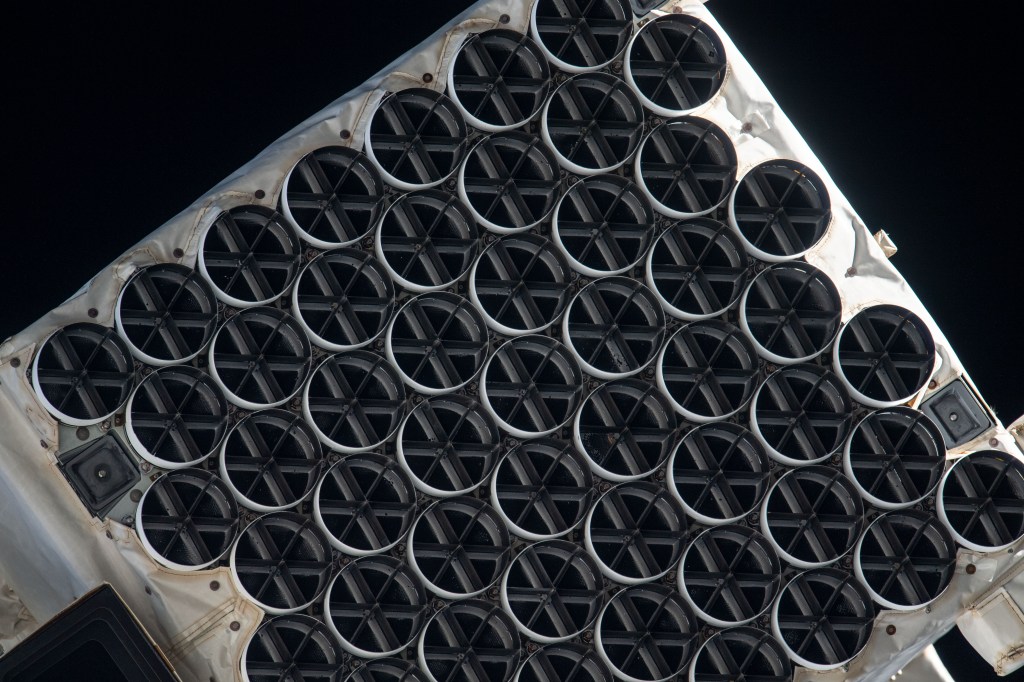
NASA’s SpaceX Crew-9 to Conduct Space Station Research
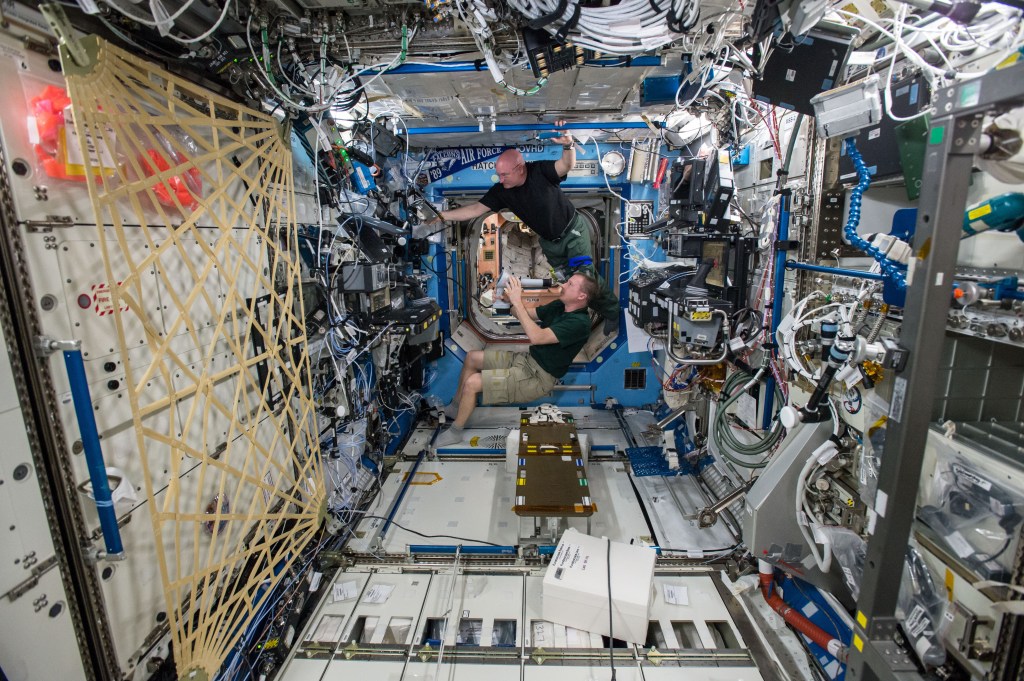
Station Science Top News: September 13, 2024

Going Back-to-School with NASA Data

Amendment 48: A.5 Carbon Cycle Science Final Text and Due Dates.

NASA Finds Summer 2024 Hottest to Date

Solar Storms and Flares

Amendment 47: DRAFT F.12 Artemis IV Deployed Instruments Program Released for Community Comment.

NASA’s Hubble, Chandra Find Supermassive Black Hole Duo

Aura at 20 Years

NASA Tunnel Generates Decades of Icy Aircraft Safety Data

Research Plane Dons New Colors for NASA Hybrid Electric Flight Tests

NASA G-IV Plane Will Carry Next-Generation Science Instrument
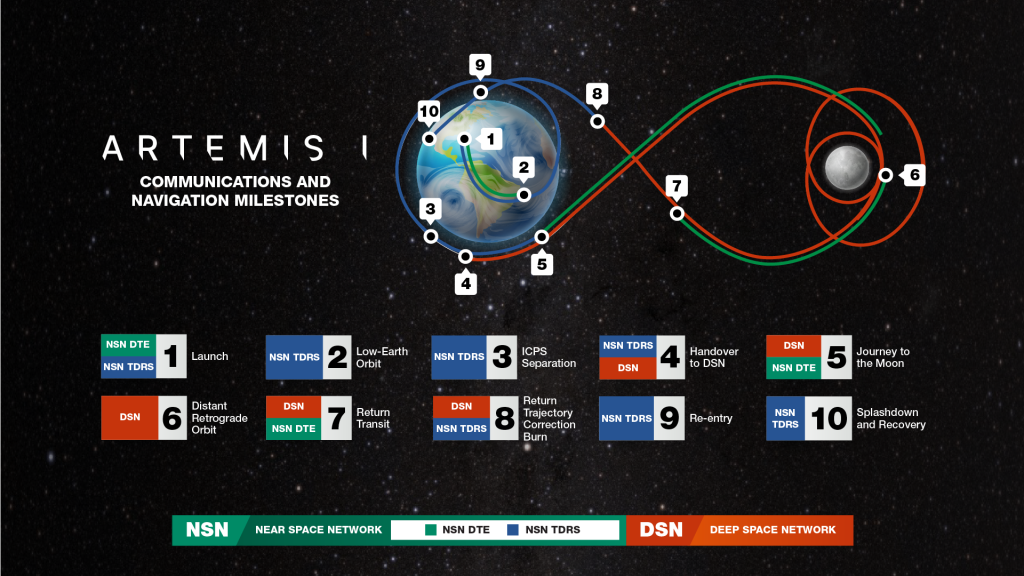
SCaN Lunar Support

Printed Engines Propel the Next Industrial Revolution

NASA Mobilizes Resource for HBCU Scholars, Highlighted at Conference

NASA Moon to Mars Architecture Art Challenge

15 Years Ago: Japan launches HTV-1, its First Resupply Mission to the Space Station

La NASA invita a los medios al lanzamiento de Europa Clipper

El X-59 de la NASA avanza en las pruebas de preparación para volar

La NASA invita a creadores de las redes sociales al lanzamiento de la misión Europa Clipper
Like a diamond in the sky: how to spot nasa’s solar sail demo in orbit.

Arezu Sarvestani
Public affairs officer.

Now that its reflective sail has deployed fully open in orbit, the Advanced Composite Solar Sail System can be seen in the night sky from many locations across the world!
Stargazers can join NASA’s #SpotTheSail campaign by using the NASA app on mobile platforms to find out when the spacecraft will be visible at their location. The app, which is free to use and available on iOS and Android , provides a location-specific schedule of upcoming sighting opportunities. A built-in augmented reality tool points users to the location of the spacecraft in real time.
Can you spot the solar sail? Share your viewing experience online using the hashtag #SpotTheSail for a chance to be featured on NASA’s website and social media channels.
Here’s how to use the sighting prediction tool:
- Install and open the NASA app on an iOS or Android device.
- Tap on the “Featured” tab on the bottom navigation bar.
- Tap on the Advanced Composite Solar Sail System mission from the Featured Missions at the top of the screen.
- Tap on the “Sightings” tab on the bottom navigation bar. A list of all the upcoming sightings for your location will be displayed.
- If you are using an iOS device, you can tap on the “Sky View” link for an augmented reality guide to help you locate the spacecraft’s real-time location during the visible pass.
NASA’s Advanced Composite Solar Sail System is testing new technologies in low Earth orbit, including a composite boom system that supports a four-piece sail. Not to be confused with solar panels, solar sails allow small spacecraft to “sail on sunlight,” eliminating the need for rocket fuel or other conventional propellants. This propulsion technology can enable low-cost deep space missions to increase access to space.
For ongoing mission updates, follow us on social media:
X: @NASAAmes , @NASA Facebook: NASA Ames , NASA Instagram: @NASAAmes , @NASA
NASA’s Ames Research Center in California’s Silicon Valley manages the Advanced Composite Solar Sail System project and designed and built the onboard camera diagnostic system. NASA’s Langley Research Center in Hampton, Virginia, designed and built the deployable composite booms and solar sail system. NASA’s Small Spacecraft Technology program office based at NASA Ames and led by the agency’s Space Technology Mission Directorate (STMD) in Washington, funds and manages the mission. NASA STMD’s Game Changing Development program developed the deployable composite boom technology. Rocket Lab USA, Inc of Long Beach, California, provided launch services. NanoAvionics provided the spacecraft bus.

IMAGES
VIDEO
COMMENTS
Our Top Picks For Solar Panels for Boats. Best Overall: Renogy Solar Panels for Boats Shop Now . Largest Panels: Rophie Solar Panels for Boats Shop Now . Most Durable: TopSolar Solar Panels for Boats Shop Now . Most Lightweight: ECO-WORTHY Solar Panels for Boats Shop Now . Easiest Installation: Sunway Solar Panels for Boats Shop Now .
Nature Power Rigid. The nature power rigid is a large, powerful, single solar panel. If you are looking for the right panels to power your entire boat comfortably, these are the ones for you. They are very large so they will need a large flat surface area. alternatively, they can be hung vertically from rails.
Giosolar 1,000W flexible solar panel. Best flexible boat solar panel. Delivering a mighty kilowatt of power, (not far off the amount used by a one bedroom house), this Giostar package comprises ten separate 100W panels, each of which is 1,050 x 540 x 2.5mm in size. Capable of charging either 12 or 24V batteries, a kit of this magnitude is one ...
The best solar panels for sailboats don't have to be powerful, but they better be efficient — find the number in the datasheet. For rigid panels anything over 18-19% is fine. Panels also should be sturdy enough to withstand seastorms. You generally also want good shading tolerance since panels often get shaded by masts and sails.
We had a 200w setup, nothing fancy but enough to supply our need for sailing the Bahamas. You will need between 2-8 solar panels for your sailboat. The exact amount depends on your sailboat's space and how many electronics you need to power. Most solar panels can absorb between 100-300 watts per hour.
A 10-watt horizontally mounted panel should generate between 3- and 5-amp hours per day. We'll need at least 13 volts to fully charge our 12-volt battery. As most solar cells generate at least 0.45 volts, you'll want a panel with a minimum of 33 cells, which should provide around 14.85 volts.
THE AVAILABLE SPACE. In practical terms, a modern 40ft monohull would have the space for around 1,200W of PV panels (cockpit arch, sprayhood top, deck), maybe 1,500W with the addition of a few portable panels for use at anchor. The 1,200W of fixed position solar array could produce around 360Ah on a sunny summer's day (zero shading) or more ...
Trina Solar, Canadian Solar, SolarEdge, Silfab, SunPower. 25-year manufacturer warranty; 10-year workmanship warranty, 2-year production guarantee. Considering installing solar on your boat for off-grid energy? Click here to see our top recommendations for boat solar panels and how to decide which one is best.
Rigid solar panels, typically monocrystalline or polycrystalline materials, are the most common type in various applications. While they are less flexible than other options, they remain a reliable and efficient choice for boats with ample deck or rooftop space. Rigid panels are durable, weather-resistant, and can deliver higher power outputs.
Another factor you'll need to consider is the size of your boat battery bank. In general, a 100Ah deep cycle battery will need 180 watts of solar to fully charge, assuming you have at least four hours of sunlight a day. Thus, if you have a 200Ah battery bank, you'll need at least 360 watts of solar. In this case, two 200-watt panels would ...
This solar panel is perfect for small boats. It is 50W 12V, made of light aluminum frame and tempered glass, the panel is waterproof and can resist the bad weather with no damages. It can handle temperature from -40℃ to 90℃. This item is anti-reflective and can withstand high winds and snow. The voltage is 16.0V.
He's been living aboard and renovating the boat for the past 3.5 years We're excited to show you the transformation as well as how he plans to propel the boat without the use of diesel or fossil fuels! 5280w Solar System for Electric Powered Catamaran. 16 Rigid solar panels (330w each) 20kwh of Lithium Batteries.
These marine flexible solar panels by Renogy are a dream for boat lovers. They fit snugly into any curved surface, which is common in boats. Plus, their ultra-light and thin design is ideal for a smooth, hassle-free sail. 5. SUNER POWER 30W Polycrystalline Solar Panel.
Small, slim and durable, this high-quality solar panel is perfect if you have low power needs on your boat, or as part of a larger solar system. 3. ACOPOWER 35W Polycrystalline Sailboat Solar Panel. Specifically designed for boats, this small polycrystalline solar panel provides 35 watts of power.
A solar-power installation on a sailboat is made up of two independent systems: one system to charge the batteries, and another system to provide 120-volt AC power for household appliances. In the charging system, the solar panels convert sunlight into electrical current and deliver it to the batteries via a solar charge controller.
What type of solar panel is best for my sailboat? There are two primary solar panel categories to investigate: monocrystalline vs. polycrystalline cells; rigid vs. semi-flexible panels; Solar Panels Left to Right: 50 and 100 Watt Flexible, 100 Watt Polycrystalline Rigid, 150 Watt Monocrystalline Rigid
Marine solar panels are a relatively niche market, but there are plenty of options to choose from since typically, you can install any DIY off-grid solar panel on your boat. Our favorite solar panels for boats are: Topsolar flexible solar panel. Renogy 100W 12V solar panel. SunPower 170W solar panel. Below, we get into the best solar panels to ...
Best Runner-Up: HQST 100-Watt 12V Monocrystalline Solar Panel. A Ringer for Renogy. HQST. Why it Made the Cut: The HQST 100-Watt 12V Monocrystalline Solar Panel is a great option if Renogy's 100 ...
Marine solar panels with best Sunpower cells, 23.7-25.4%+ efficient, A+ grade solar cells only. All info and consulting available to help you choose the ideal solar panels for your needs. Visit or call, we're more than happy to help. ... are ideal for temporary mounting of our flexible solar panels on a boat's canvas bimini or dodger. Our rare ...
WATTS/AMPS: 100W/5.6A. SIZE: 43.3" x 22.4" x 0.1". PROS: 30-degree curve possible making this ideal for boat coach roofs, very thin makes for less dirt buildup and less wind resistance, good price for a powerful panel. CONS: Cable connections are on the top of the panel which may encourage corrosion and UV damage.
Renogy Flexible Solar Panel 175 Watt 12 Volt. This Renogy solar panel is one of the best options for a sailboat. This product has an efficiency rate of 16-18% and will produce an average of 175 watts. The Renogy flexible solar panel is a durable and lightweight product that can easily mount on any surface.
3. Best for Powering Boats off the Grid: EcoFlow 400W Portable Solar Panel This powerful marine solar panel is the rugged solution for off-grid boating. The high-efficiency panel provides 400 watts of rated power, making it suitable for houseboats, boat camping, sailboats, and other extended marine activity.. The panel is lightweight, especially when considering its 400W output.
Solar panels will average efficiencies can be expected to produce 3 times the nominal power each day. A 100 watt panel will produce about 300 watts (25 ah) on average per day, less on cloudy days, a little more on bright sunny days. High efficiency panels (expensive) panels can get close to 4 times.
NASA's Advanced Composite Solar Sail System is testing new technologies in low Earth orbit, including a composite boom system that supports a four-piece sail. Not to be confused with solar panels, solar sails allow small spacecraft to "sail on sunlight," eliminating the need for rocket fuel or other conventional propellants.